🏛️ Fathers of Modernism: Through the Lens of Midjourney V7

The fathers of modernism, working between 1900 and 1920, changed the way the world looked at space. Frank Lloyd Wright, Le Corbusier, Walter Gropius, Adolf Loos, and Ludwig Mies van der Rohe transformed architecture from ornament into essence. They peeled away decoration until nothing remained but light, line, and the truth of material.
📸 Midjourney Prompt:A photoreal architectural composition inspired by the fathers of modernism: Frank Lloyd Wright, Le Corbusier, Walter Gropius, Adolf Loos, and Ludwig Mies van der Rohe. Clean geometric forms, precise lines, and harmonious proportions define the structure. Warm natural materials combine with concrete, steel, and glass, balancing function and beauty. Soft directional light reveals texture and spatial rhythm, with open interiors, cantilevered volumes, and seamless integration with the landscape. Cinematic realism, calm atmosphere, refined tonal contrast, and architectural clarity --ar 3:2 --seed 1 --raw --stylize 250
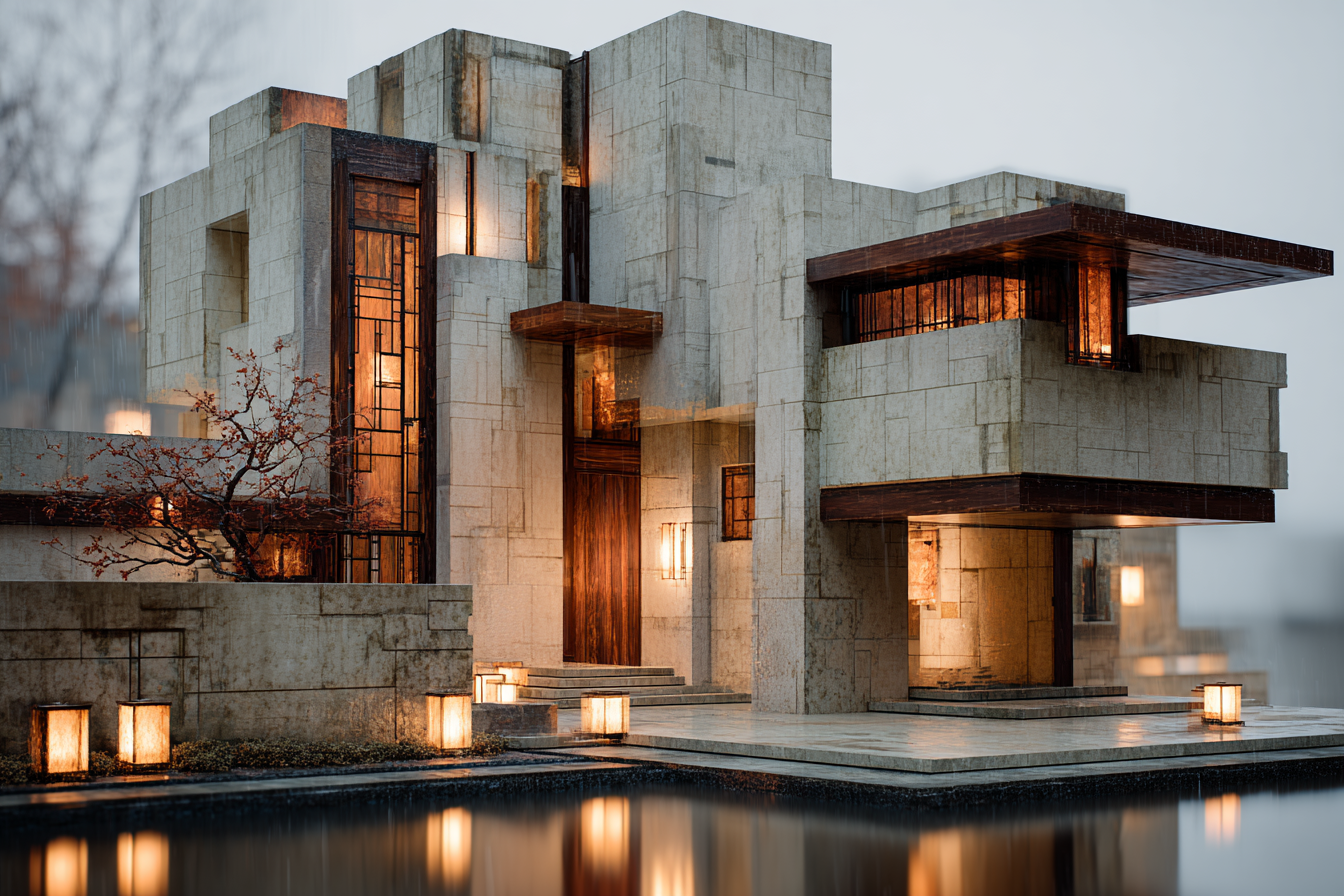
Steel was young, glass was sacred, and concrete had not yet learned to lie. The new century wanted a different kind of beauty. It wanted honesty. Buildings no longer needed to disguise what they were. They could stand, bare and luminous, like thoughts made solid.
Through the photoreal clarity of Midjourney V7, we can see those thoughts again, reimagined in digital form. Geometry becomes emotion. The grid of a façade softens into story. A wall, once drawn in graphite, now breathes in tone and shadow. The AI captures not only how these spaces looked, but how they might have felt when sunlight first touched them.
It is strange and beautiful to watch algorithms find the poetry of proportion. What Wright once traced in prairie stone, or Gropius balanced in steel and glass, Midjourney now reconstructs in light. The tool does not replace the artist; it remembers the artist. It rebuilds memory from pixels and patience.
In this visual dialogue, ten modern cameras serve as the interpreters. Their sensors and lenses, each tuned to a particular eye, revisit the masters with precision. The Sony A7R V listens for Wright’s warmth. The Canon R5 seeks Le Corbusier’s order. The Leica SL2 hears Gropius’s rhythm. Each camera becomes a voice in conversation with the past.
These are not recreations. They are echoes made visible. Through Midjourney’s lens, the philosophies of early modernism emerge once more, no longer trapped in archives or textbooks, but living again in image and light.
To look through these frames is to understand what the modernists saw in the first place: a world that could be both functional and alive, both precise and full of feeling. Their architecture did not merely change how we build. It changed how we see.
And now, in a century that speaks in pixels instead of plaster, we are beginning to see again.
🌍 Introduction: The Birth of Modernism (1900 to 1920)
At the turn of the twentieth century, steel was new magic and glass was truth. Cities were rising faster than belief could follow. The world that once carved ornament in marble now carved sky instead. Factories sang through iron rafters, and light fell differently on everything.
Industrial progress handed architects a new alphabet. With it, men like Frank Lloyd Wright, Le Corbusier, and Walter Gropius began to write the first poems of modernism. They saw form not as decoration but as declaration. They stripped away plaster and gilding, not to make things colder, but to make them honest.
They believed that beauty could live inside structure itself. A column could be graceful without Corinthian leaves. A window could express order without frame or flourish. Their buildings became arguments made of light.
It was not rebellion for its own sake. It was a search for integrity. Wright built with nature’s rhythm, his homes growing from the land as if born of it. Gropius saw factories as temples for a working people who deserved clarity more than grandeur. Le Corbusier dreamed of machines that could hold human warmth. Each of them believed in architecture as a language of truth.
Today, Midjourney V7 allows us to look at their dreams again through a century-spanning lens. The AI does not invent their ideas. It listens to them. It translates their silence into image.
When I typed “Prairie-style home bathed in late golden hour light, Sony A7R V clarity, f/4 ISO 200 photoreal style raw”, the screen did not give me a copy. It gave me a memory. The house that appeared was both real and imagined, as though it had waited a hundred years to be seen again.
📸 Midjourney Prompt:A Prairie-style home bathed in late golden hour light, captured with Sony A7R V clarity, f/4 ISO 200, photoreal composition that feels both real and remembered, evoking timeless modernist ideals and architectural nostalgia, soft light reflecting across warm natural materials, cinematic realism and atmospheric depth --v 7 --style raw --stylize 250 --seed 1
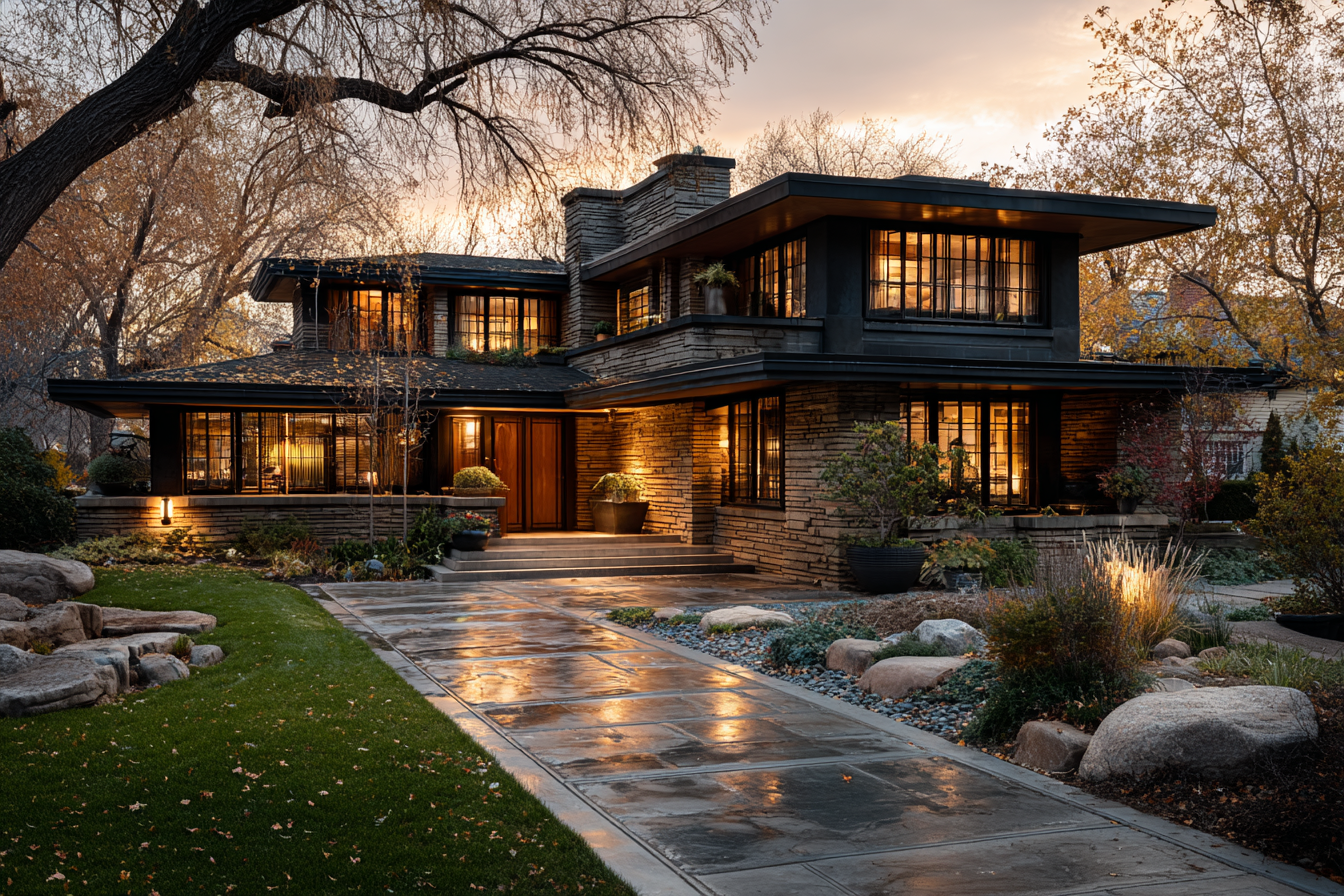
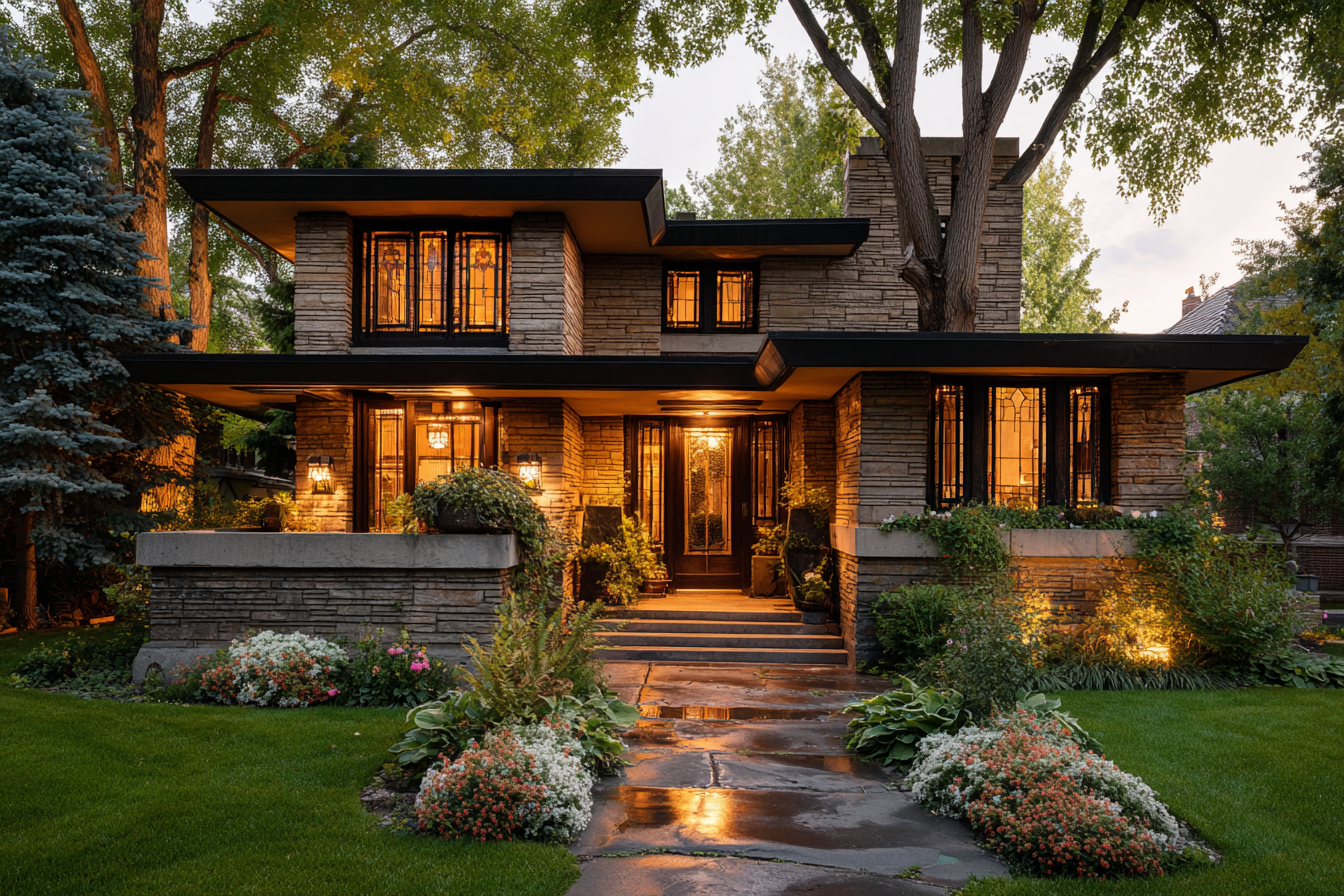
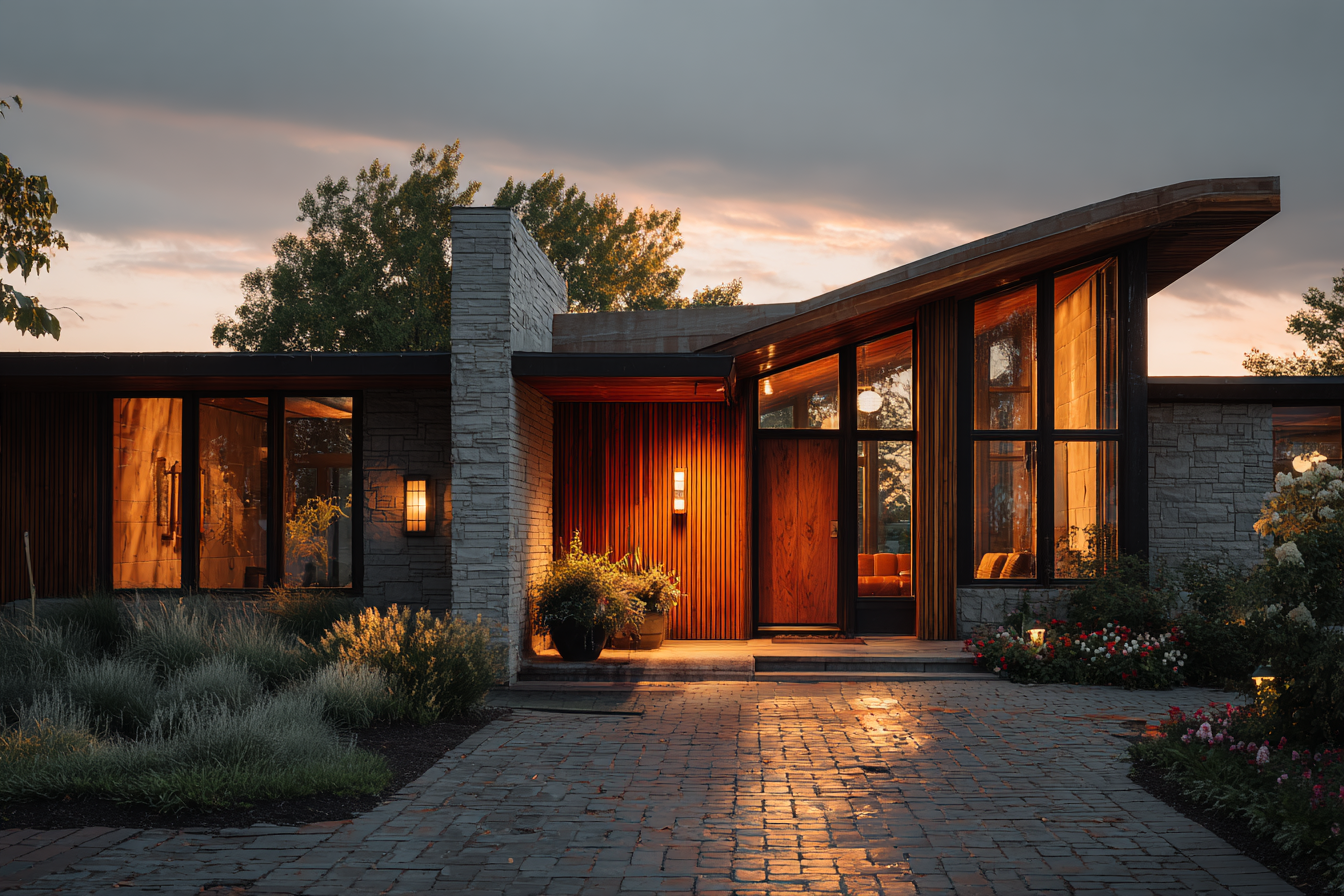
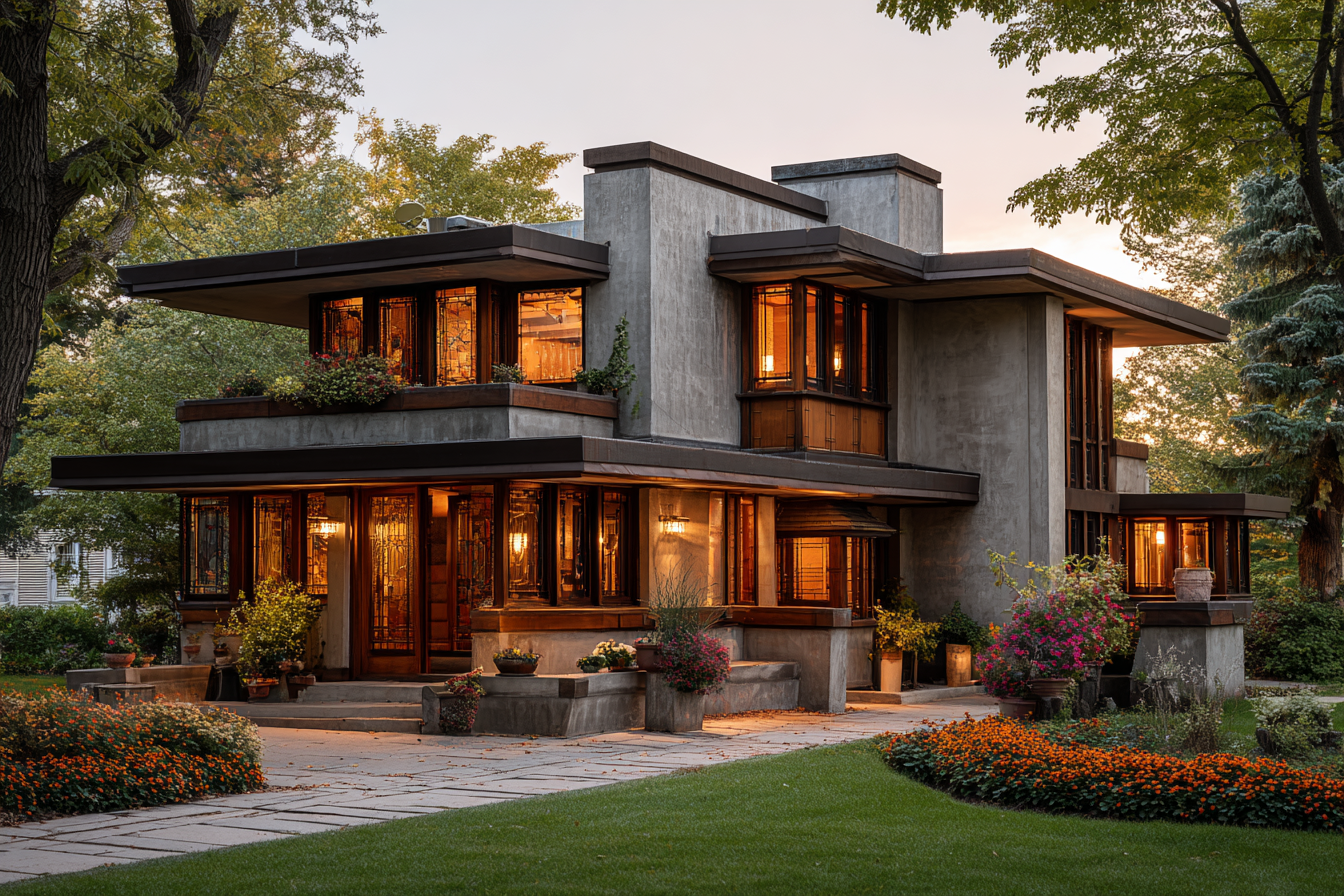
The glass caught sunlight with the same quiet precision Wright once described as “the breath of the prairie.” The shadows folded around the structure like language returning to its origin. In that moment, I understood what modernism had always been reaching for. It was not the machine. It was the moment of stillness that the machine made possible.
The birth of modernism was not just an architectural event. It was a change in how we saw the world. It taught us that space could feel as much as it could stand. That light could carry emotion. That simplicity could speak louder than ornament.
Through Midjourney’s lens, we do not recreate their vision. We rediscover it.
🏡 Frank Lloyd Wright and the Sony A7R V, Organic Geometry in AI Light
Frank Lloyd Wright believed that a house should grow from its land as naturally as a tree. His architecture did not rest on the earth. It rose from it. Stone, wood, and water were his vocabulary. Light was his punctuation.
The Sony A7R V, with its sixty-one-megapixel sensor and wide dynamic range, interprets that philosophy with quiet precision. Its clarity feels patient, as if the camera understands what it means to wait for morning light.
In Midjourney V7, I entered “Fallingwater, autumn mist over waterfall, Sony A7R V 35 mm f/2.8 ISO 100, soft morning light, style raw.” The image unfolded slowly, stone and water braided like a single thought. The falls shimmered as if breathing. The cantilevered terraces floated above the stream, their edges softened by mist. It was not imitation. It was conversation.
📸 Midjourney Prompt:Fallingwater surrounded by autumn mist, waterfall flowing beneath cantilevered terraces, captured with Sony A7R V and 35mm lens at f/2.8 ISO 100, illuminated by soft morning light. Stone and water merge in tranquil balance, evoking the spirit of organic architecture and timeless modern design, cinematic realism with natural depth and tactile atmosphere --v 7 --style raw --stylize 250 --seed 1
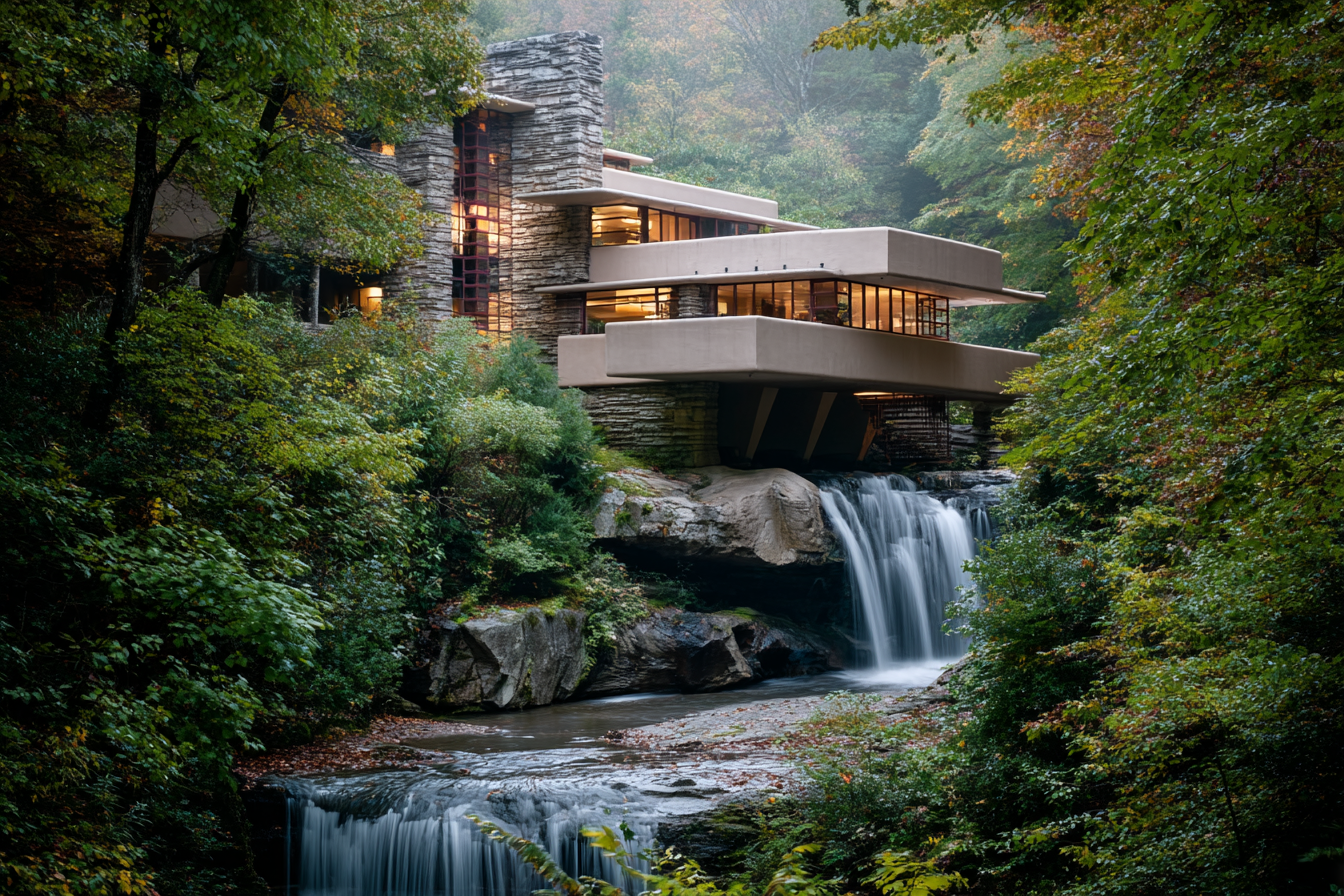
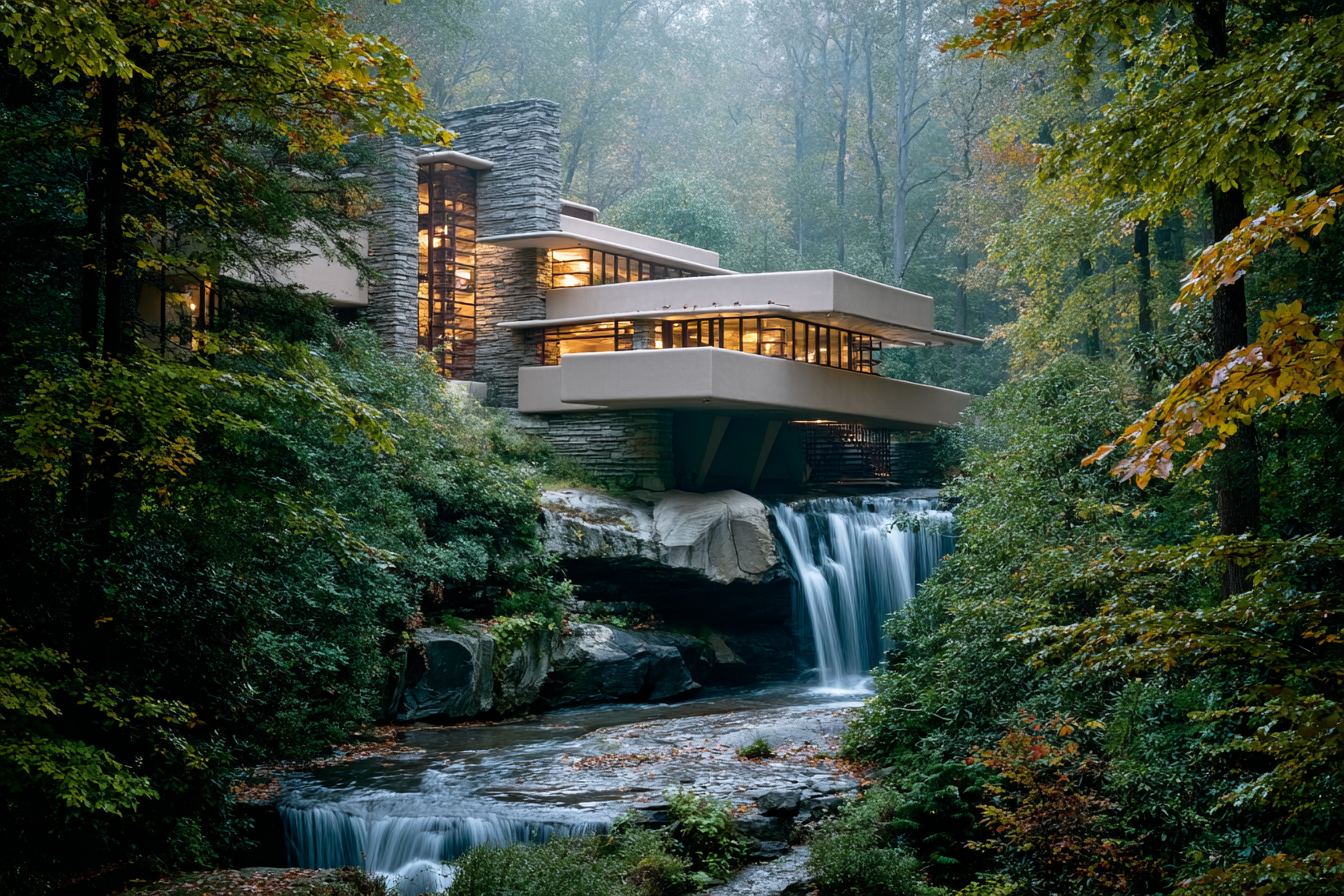
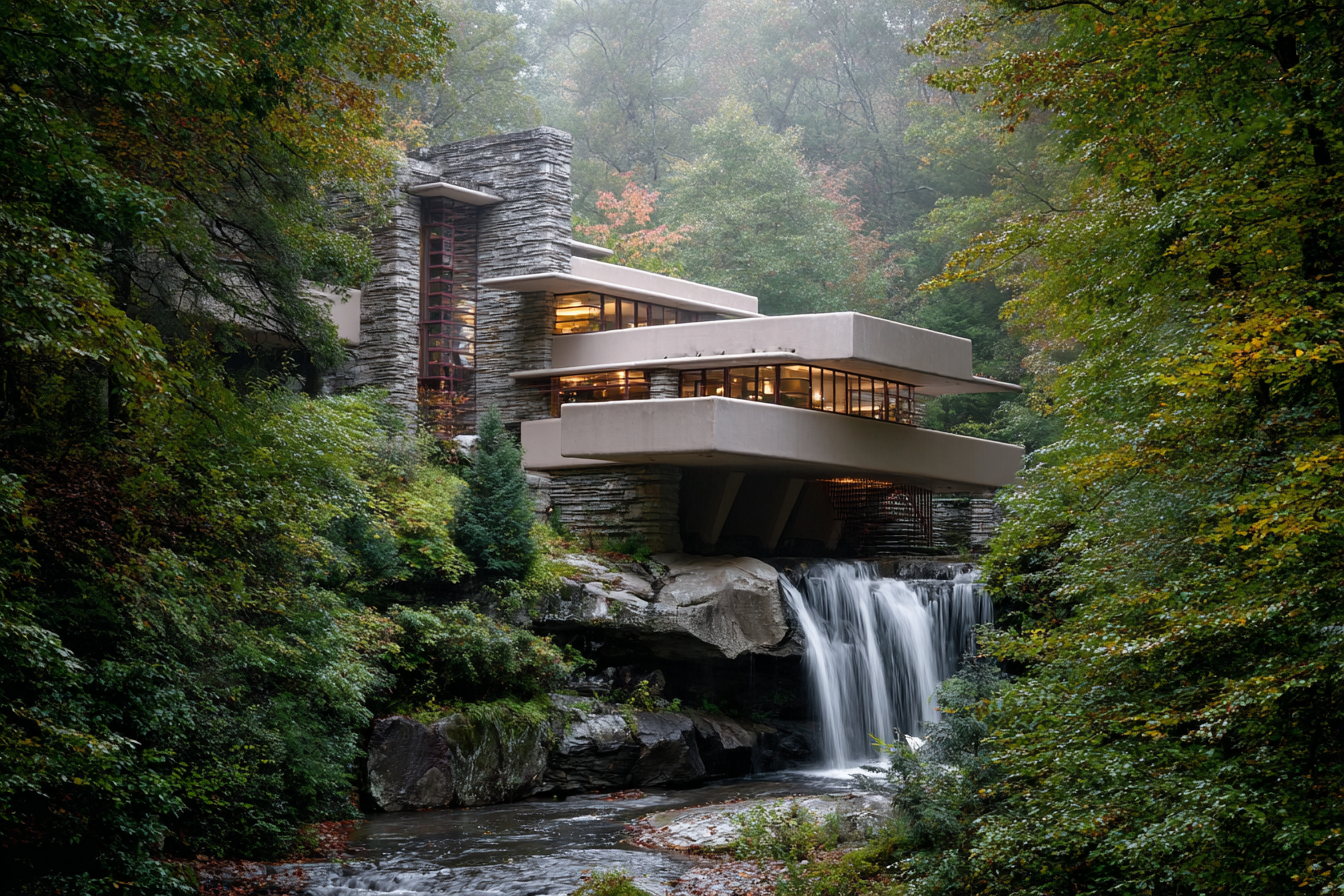
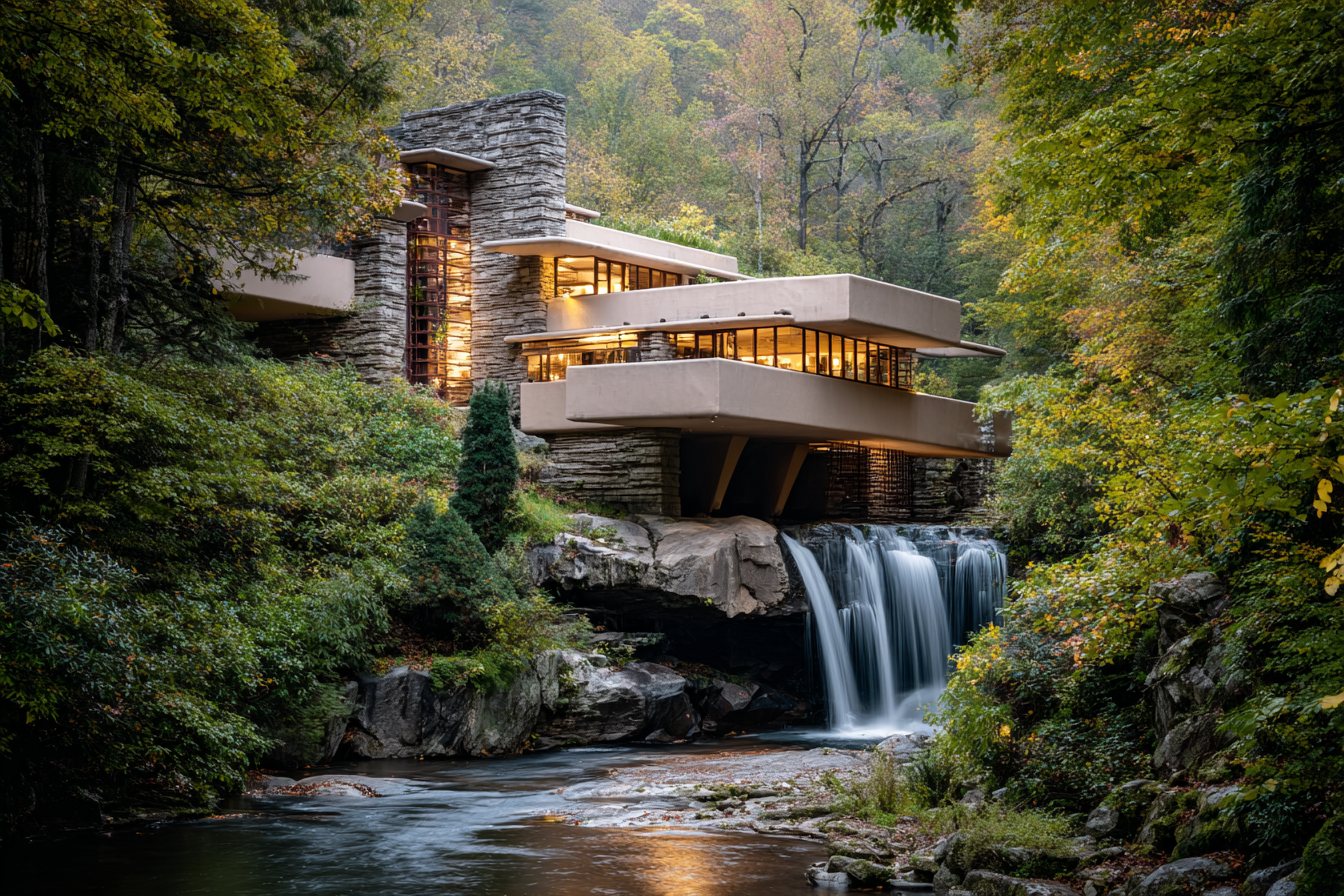
The AI’s rendering carried Wright’s signature horizontal lines, yet it revealed something new. The moss beneath the balcony glowed faintly green. Tiny droplets clung to the stone like quiet punctuation. There was life between the joints of concrete, the same fragile life Wright believed every structure should protect.
It felt as if the camera and the architect were collaborating across time. The lens listened to the landscape the way Wright once did, finding rhythm where others might see weight.
Wright’s idea of organic architecture was never about decoration. It was about belonging. He wanted a home to look inevitable, as though the earth had imagined it first. In Midjourney, that idea becomes tangible again. The AI reads light the way Wright read wind.
The Sony A7R V responds to tone and contrast the way a painter responds to brush and pigment. It reads every reflection, every leaf, every ripple. When used to interpret Wright’s work, it captures not just structure but emotion — the pulse of still water, the scent of stone after rain.
Technique: Manual mode, shutter 1/125 second, aperture f/2.8, balanced for warm Kelvin tones around 5600 K. Wait for the light to slide across the surface rather than fall upon it. Patience is part of composition.
Wright once said that a building should “appear to grow easily from its site and be shaped to harmonize with its surroundings.” That is what the Sony sees. That is what Midjourney remembers.
Through this collaboration of lens and code, his language becomes visible again. Structure meets light the way Wright met nature — in perfect equilibrium.
🏗️ Le Corbusier and the Canon R5, The Mathematics of Form
Le Corbusier sought to standardize beauty, not to empty it of feeling. He believed proportion could be taught, that light could be organized, that a house could be a machine for living without losing its human breath. His Five Points of Architecture: pilotis, roof garden, free plan, free façade, and horizontal ribbon windows read today like a camera operator’s checklist. Lift the mass. Free the walls. Let the plan flow. Unhook the skin from structure. Pull a long band of glass to stretch the horizon.
I worked with the Canon R5 as if Corbusier had traded his drafting pen for a viewfinder. Into Midjourney V7 I wrote “Villa Savoye at dawn, Canon R5 RF 24-70 mm f/2.8 ISO 200, diffused fog, style raw.” The image resolved with quiet certainty. Planes met light the way proofs meet paper. The pilotis lifted the form so the earth could pass beneath. Across the free façade, ribbon windows turned the garden into a horizontal mural.
What surprised me was the tenderness. Corbusier’s geometry stayed exact, yet Midjourney added a small human tremor. A soft reflection hovered in the glass where no one stood. The fog rounded the corners by a finger’s width. Precision met mercy. That is the moment his doctrine stops being rule and becomes life.
Technique, tuned to the Five Points
- Pilotis, spatial release. Shoot at 35 mm to hold context, stop to f/8 so columns stay clean from base to soffit. Keep ISO 100 to 200 for neutral tonality.
- Free façade, skin as canvas. Use aperture priority at f/2.8 to f/4 for a gentle falloff that separates glazing from concrete. Spot meter on the brightest panel to avoid clipped highlights.
- Free plan, flow not walls. For interiors, walk a 24 to 35 mm prime and compose from ramps or thresholds. Let the frame show movement across space rather than rooms in isolation.
- Ribbon windows, horizon as idea. Align the eye line with the center of the band. Keep the camera level to preserve the linear promise. Early or late light stretches the landscape into a single sentence.
- Roof garden, earth returned above. A 50 mm at f/5.6 balances people, planters, and sky. Slight underexposure, -0.3 EV, keeps foliage honest and concrete true.
Working the Midjourney dial, from RAW to mood
Corbusier’s work suffers when stylization runs wild. Keep --s 50 to 100 for architectural fidelity with a touch of atmosphere. At --s 0, the model records like a survey. At --s 150 to 250, forms dramatize and proportions drift. For Villa Savoye, --s 75 holds the line while allowing fog to breathe. Write camera language clearly, 35 mm, ISO 200, f/2.8, shutter 1/250, soft backlight, and the model composes like a photographer rather than a renderer.
A short study, five prompts as philosophy
“Savoye on pilotis, garden drifting underneath, 35 mm, f/8, ISO 100, style raw, --s 60.” The ground flows like air. Space becomes continuous.
📸 Midjourney Prompt:Villa Savoye elevated on pilotis, garden landscape flowing beneath open structure, captured with a 35mm lens at f/8 ISO 100. Morning light reveals pure white geometry and continuous space, expressing Le Corbusier’s modernist vision of form and function in harmony with nature. Photoreal composition with calm atmosphere, soft shadows, and balanced tonal contrast, cinematic realism with architectural precision and spatial clarity --v 7 --style raw --stylize 60 --seed 1
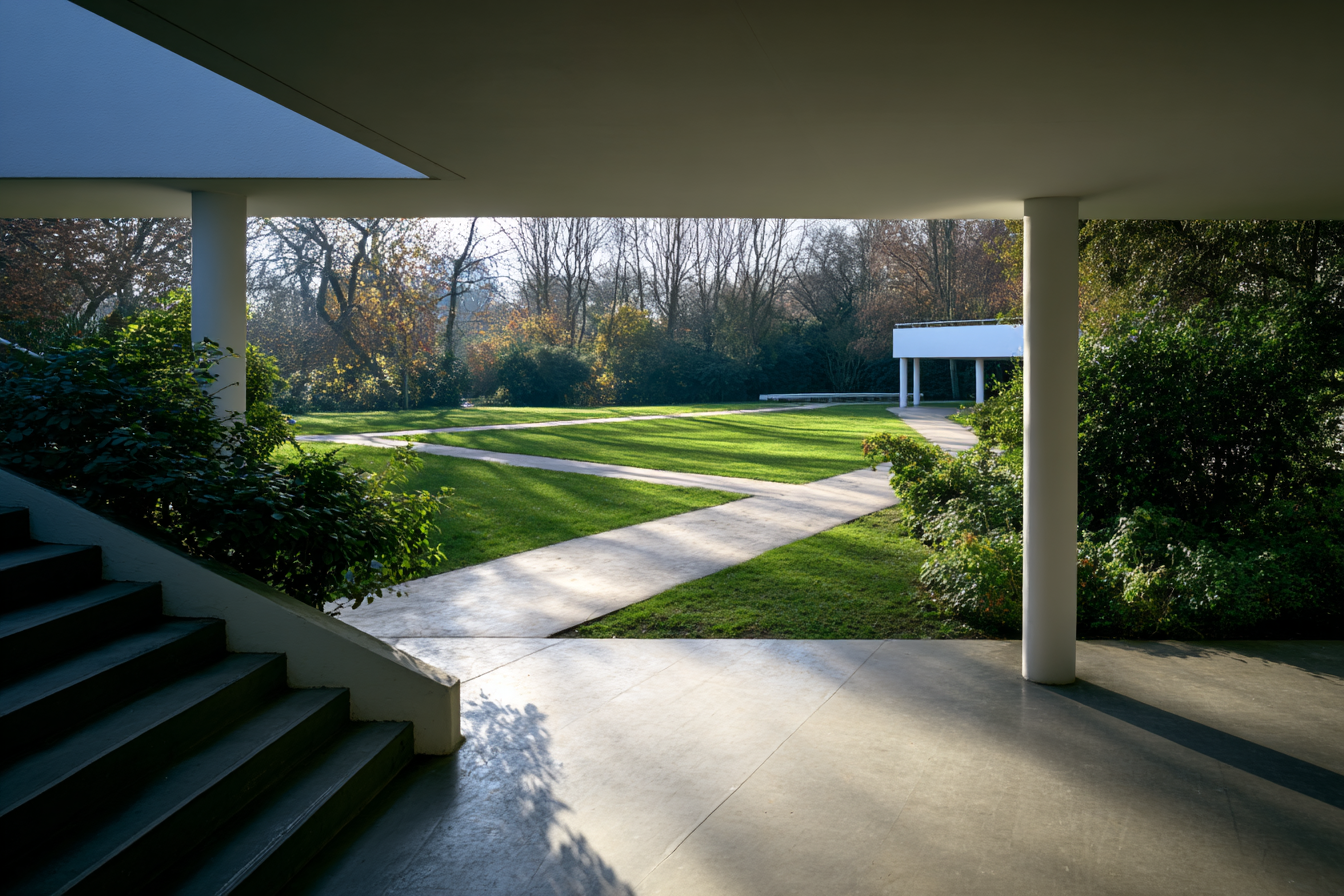
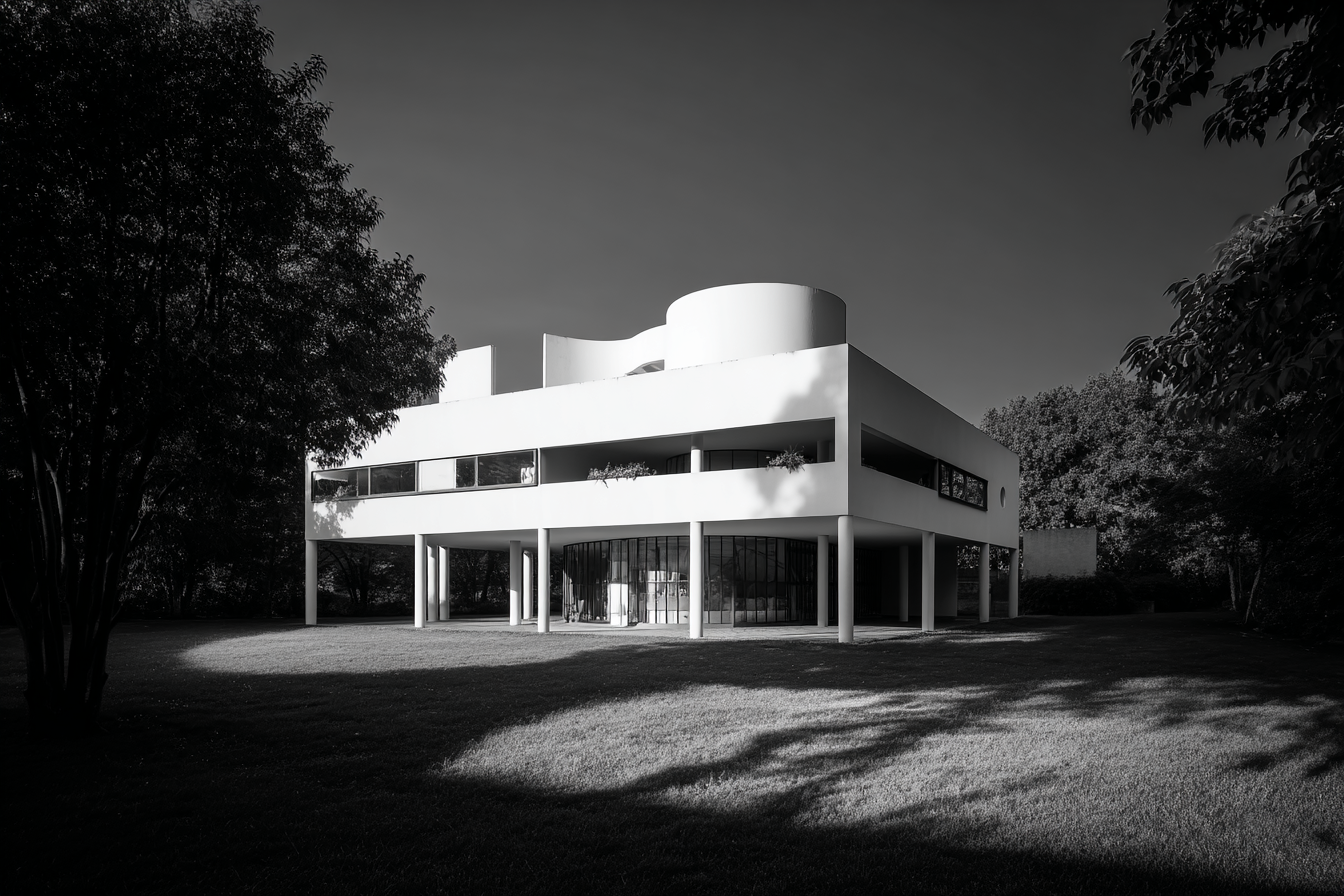
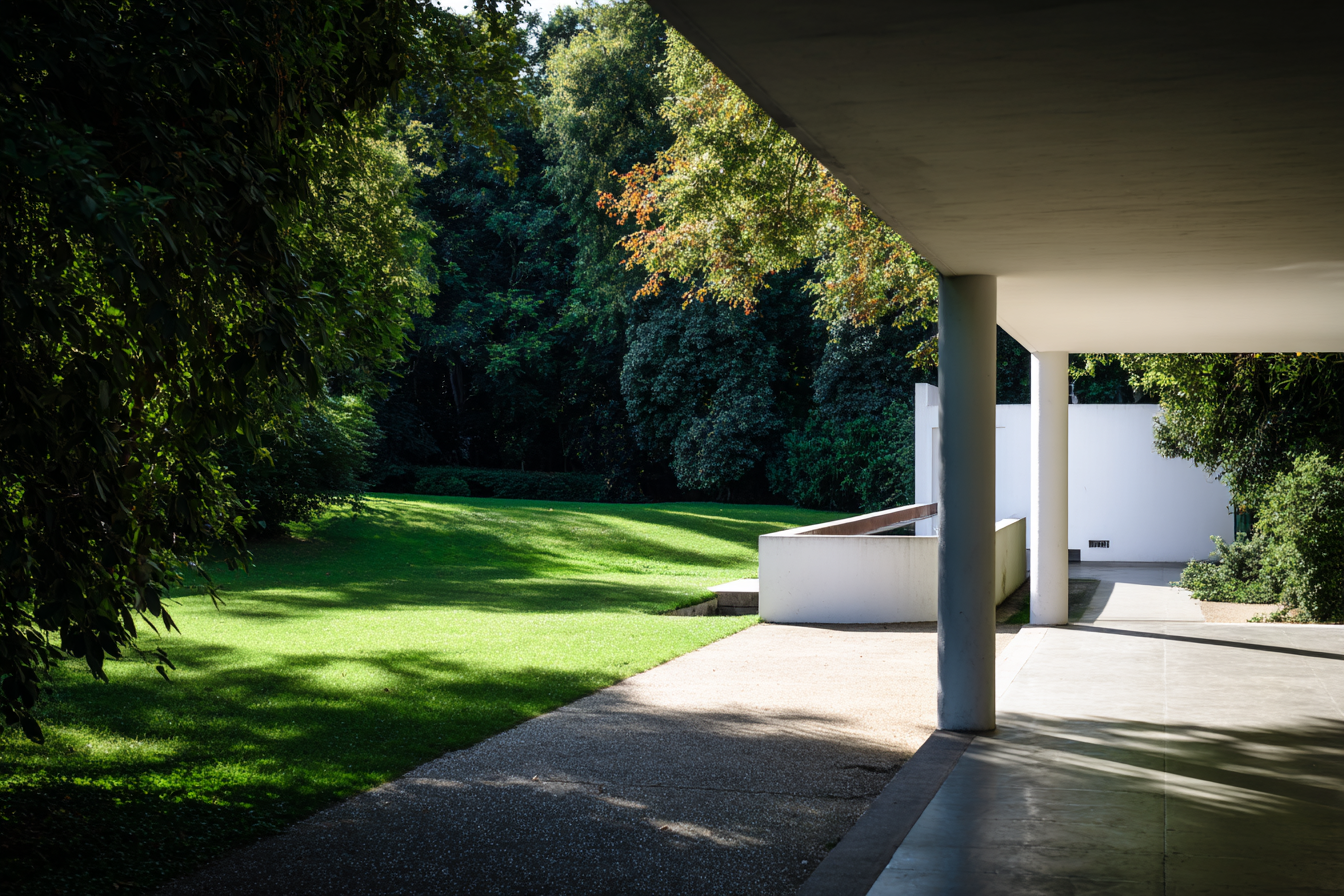
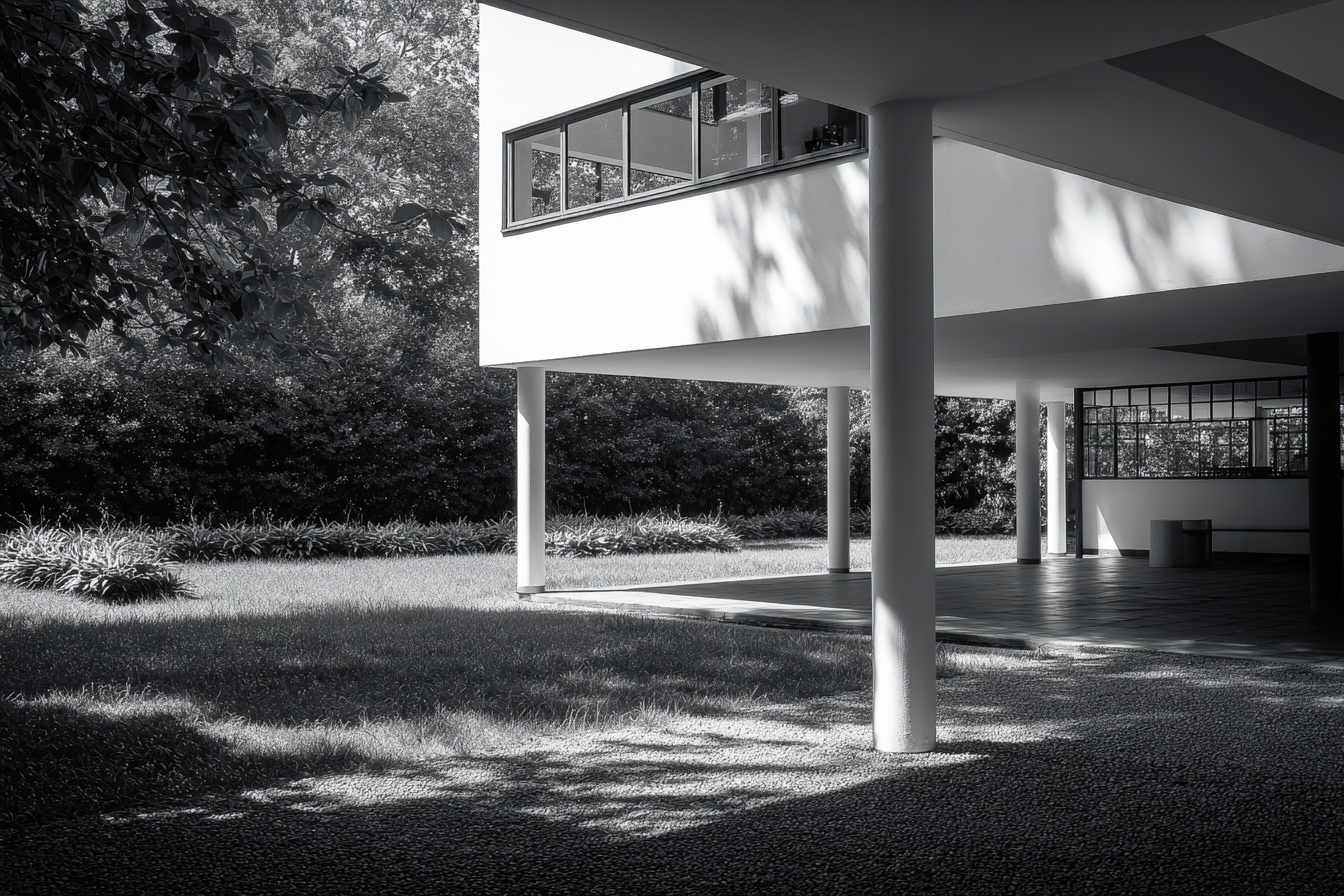
“Free façade in overcast light, plaster skin and glass, 50 mm, f/4, ISO 200, --s 75.” The wall turns to language. The building finally speaks.
📸 Midjourney Prompt:Modernist building with a free façade in soft overcast light, smooth plaster surfaces and glass panels creating rhythmic balance, captured with a 50mm lens at f/4 ISO 200. The structure conveys quiet expression through material and proportion, its walls appearing to speak through texture and light. Photoreal composition with subtle atmospheric diffusion, calm tonality, and refined architectural realism --v 7 --style raw --stylize 75 --seed 1
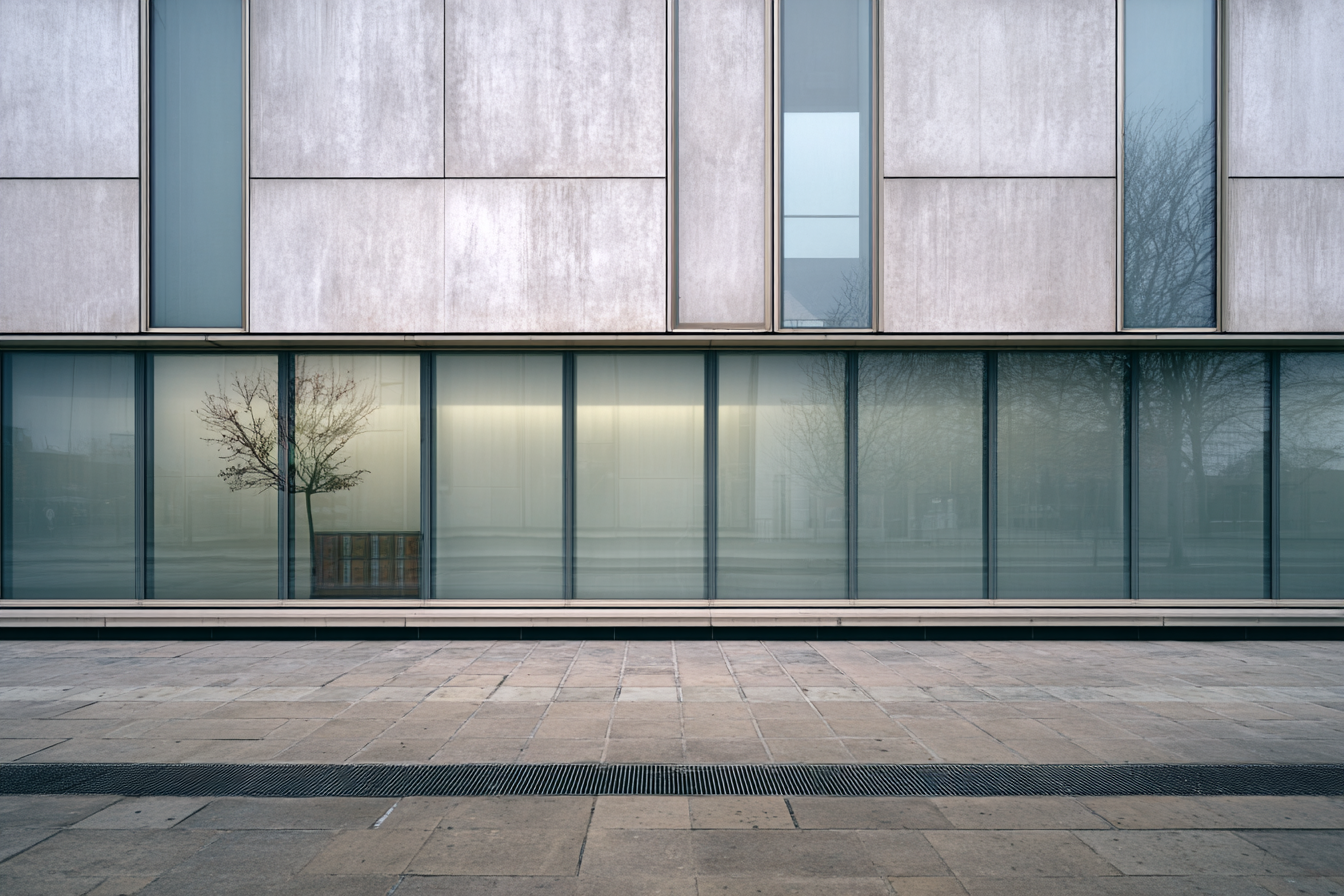
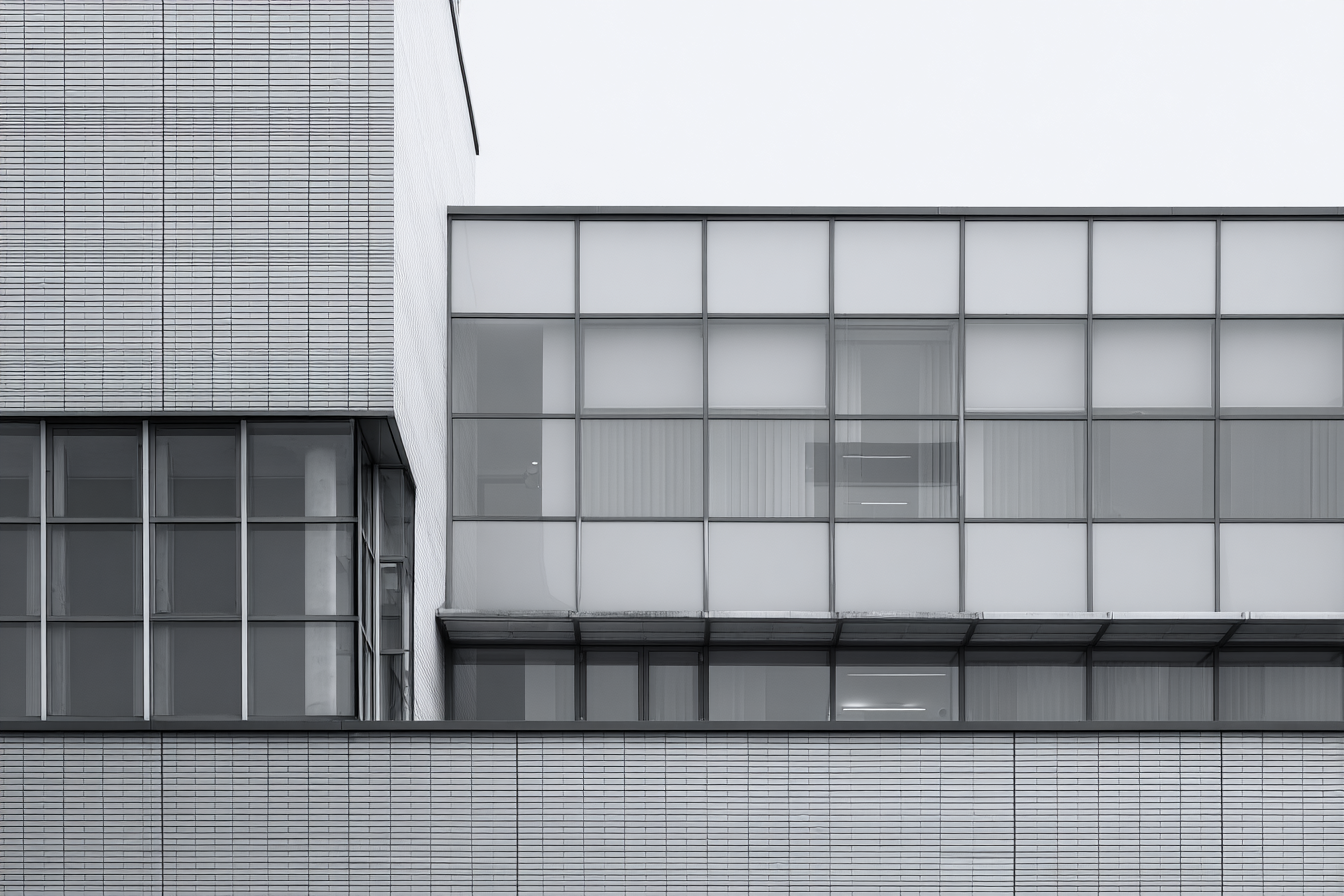
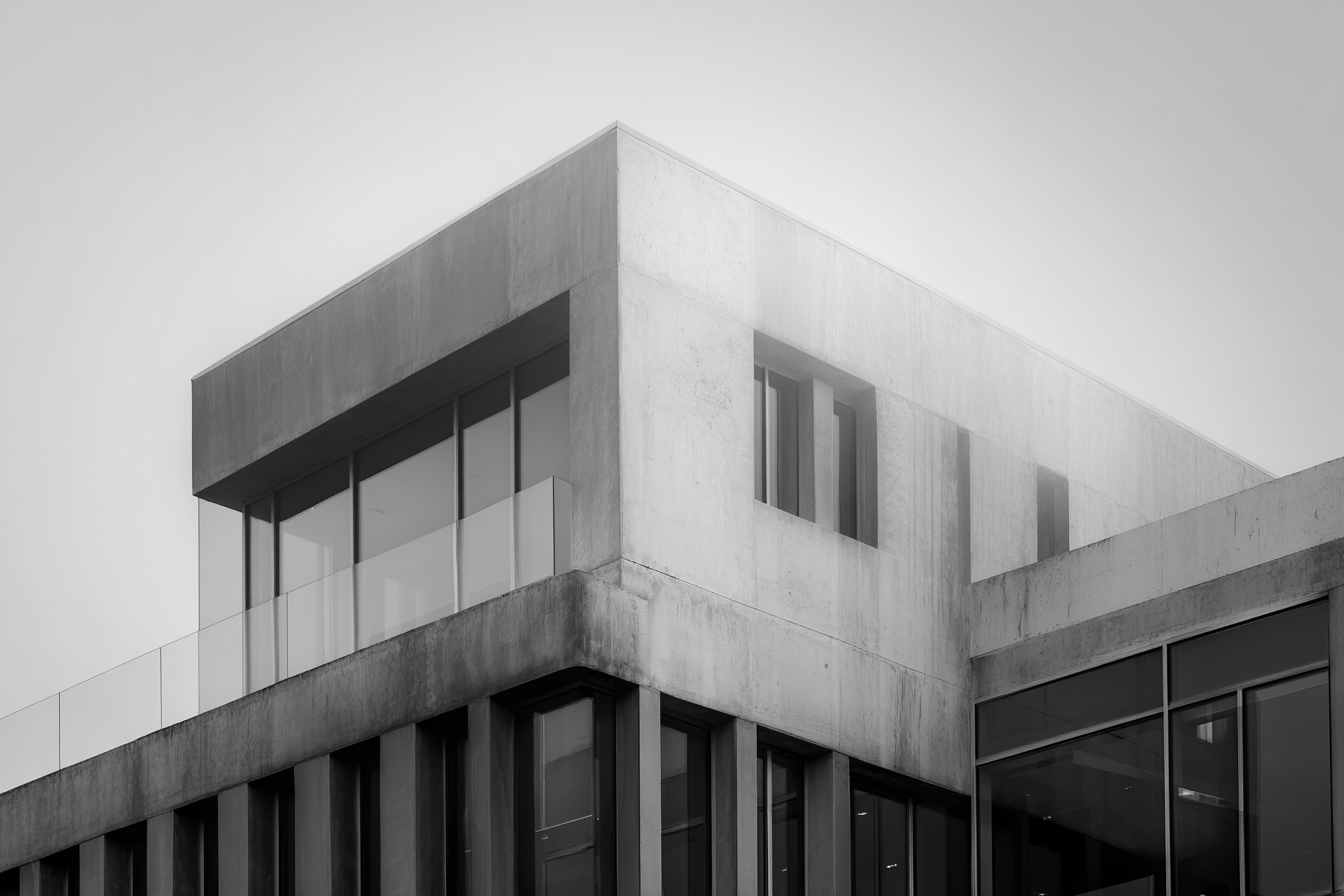
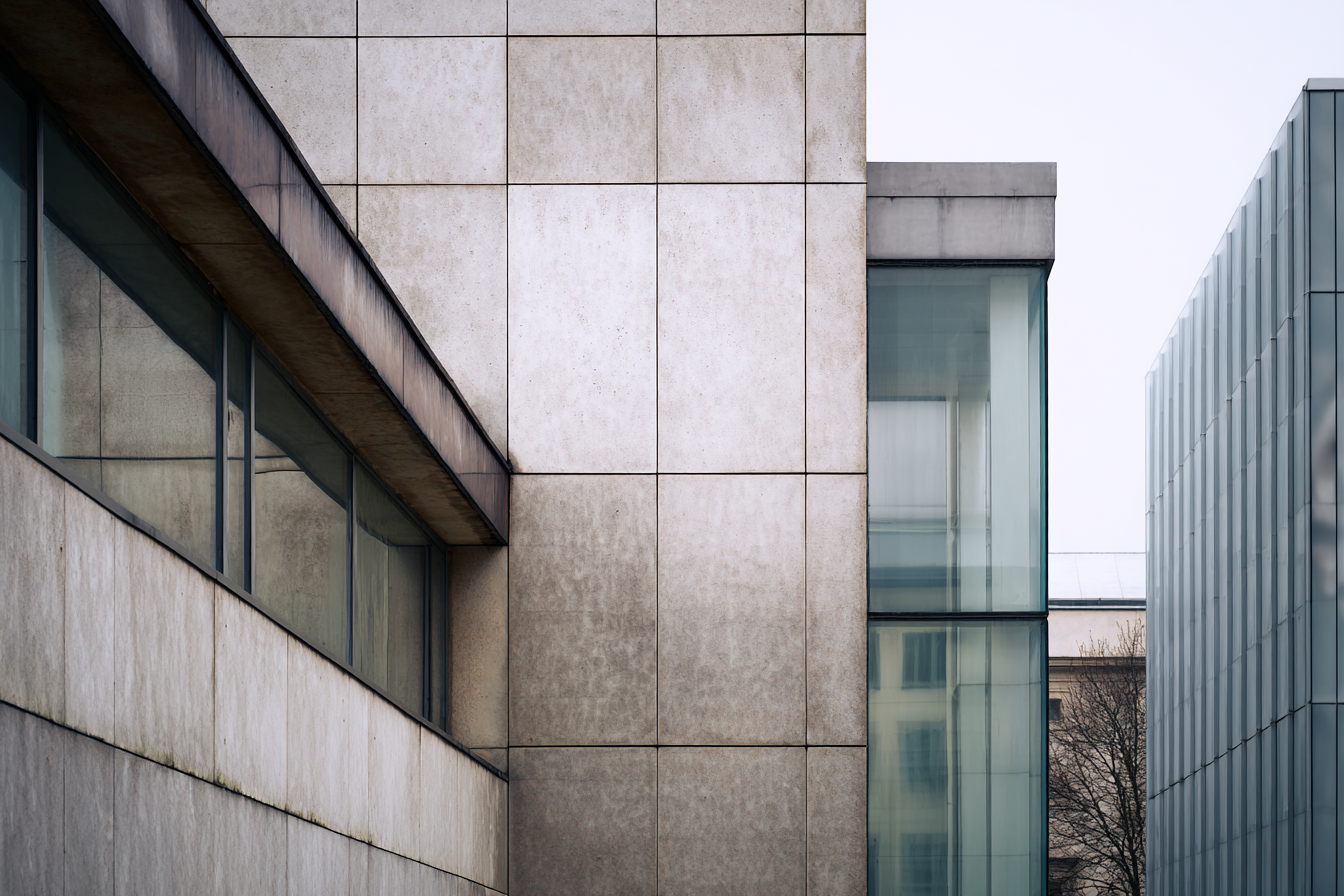
“Ramp through free plan, interior movement, 24 mm, f/5.6, ISO 400, --s 80.” People do not pass through rooms. They pass through ideas.
📸 Midjourney Prompt:Modernist interior featuring a sweeping ramp through an open free plan, captured with a 24mm lens at f/5.6 ISO 400. The design emphasizes fluid spatial movement and the continuity of form and function, where light and structure guide the viewer through space like an unfolding idea. Photoreal composition with soft diffused lighting, architectural depth, and cinematic realism --v 7 --style raw --stylize 80 --seed 1
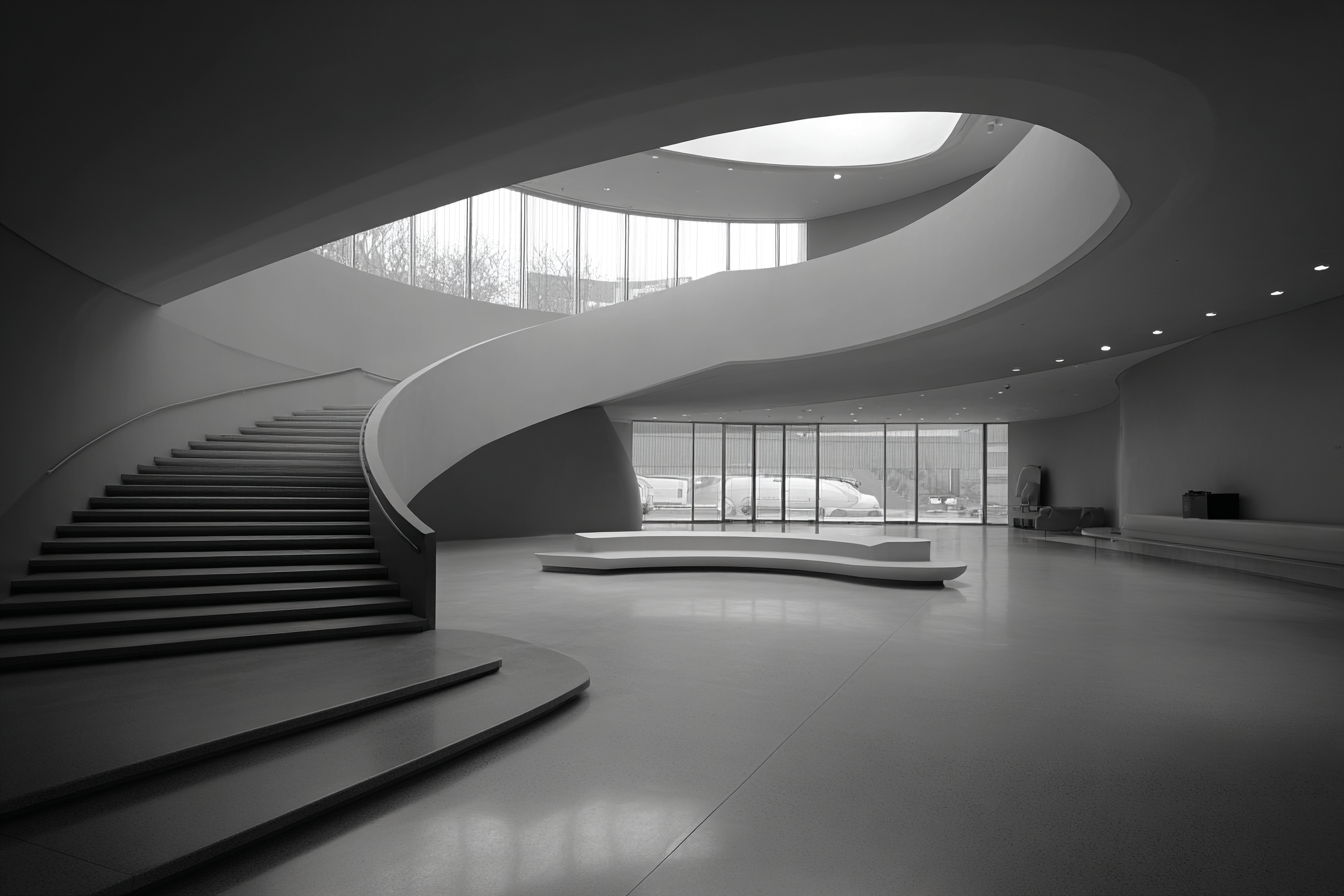
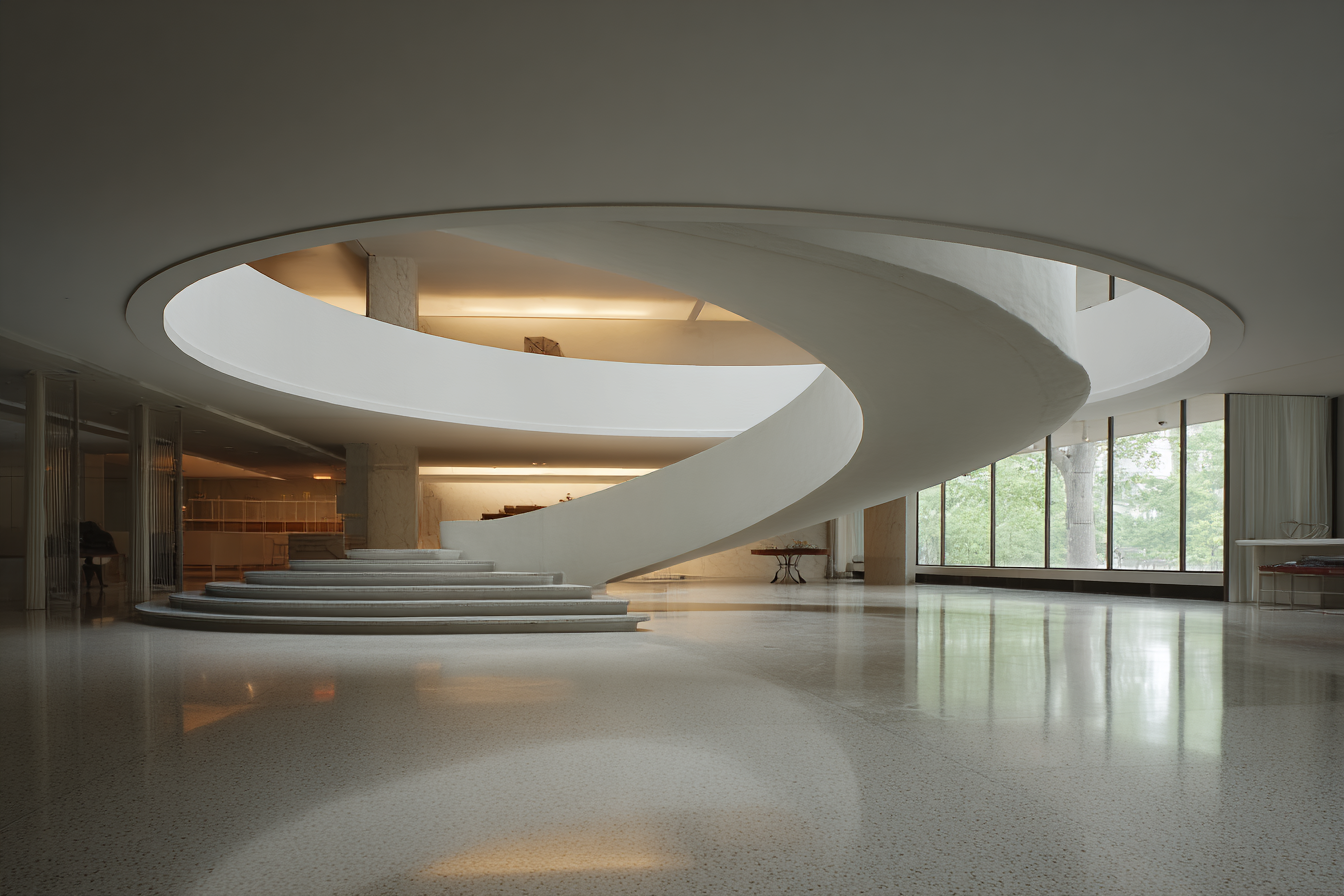
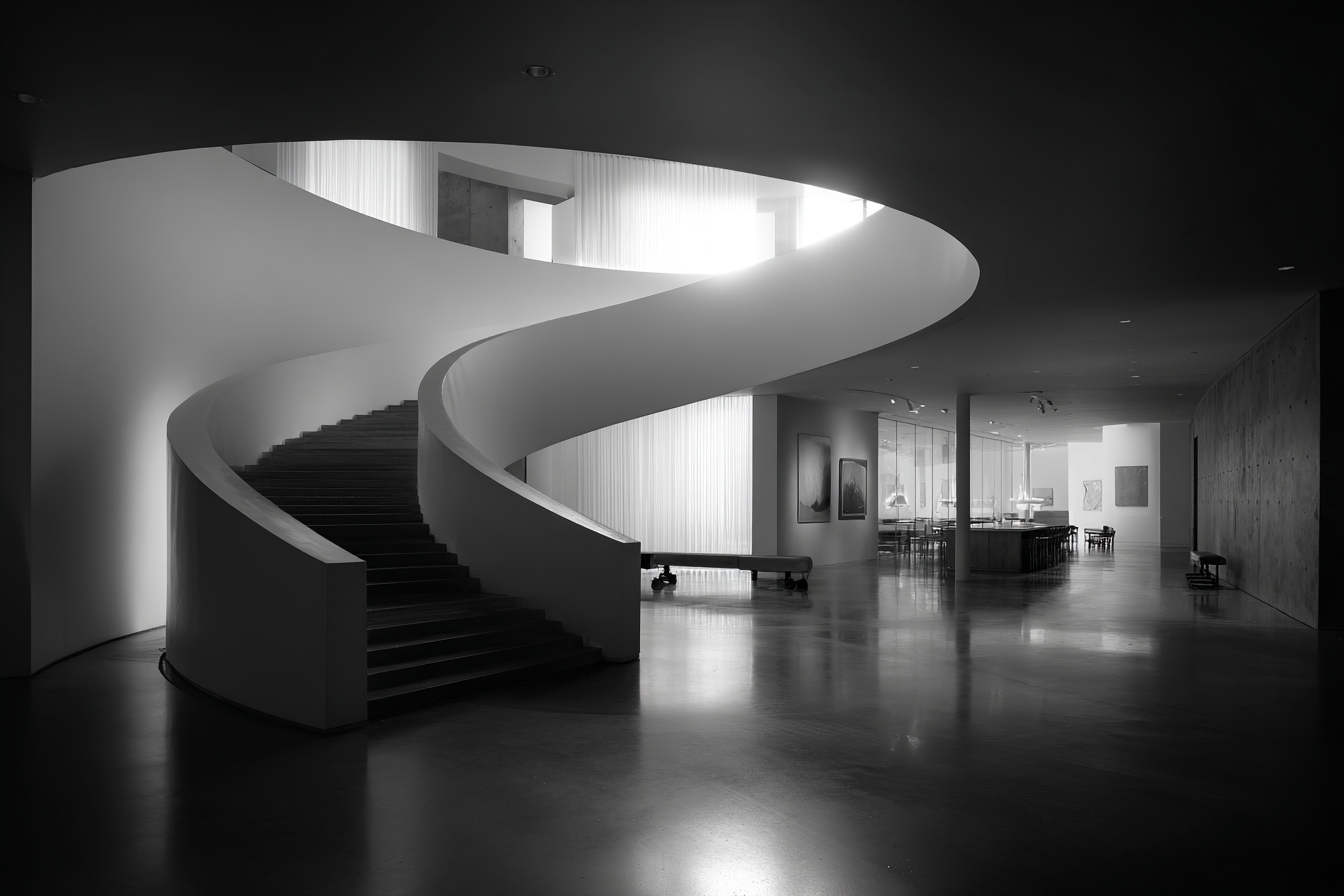
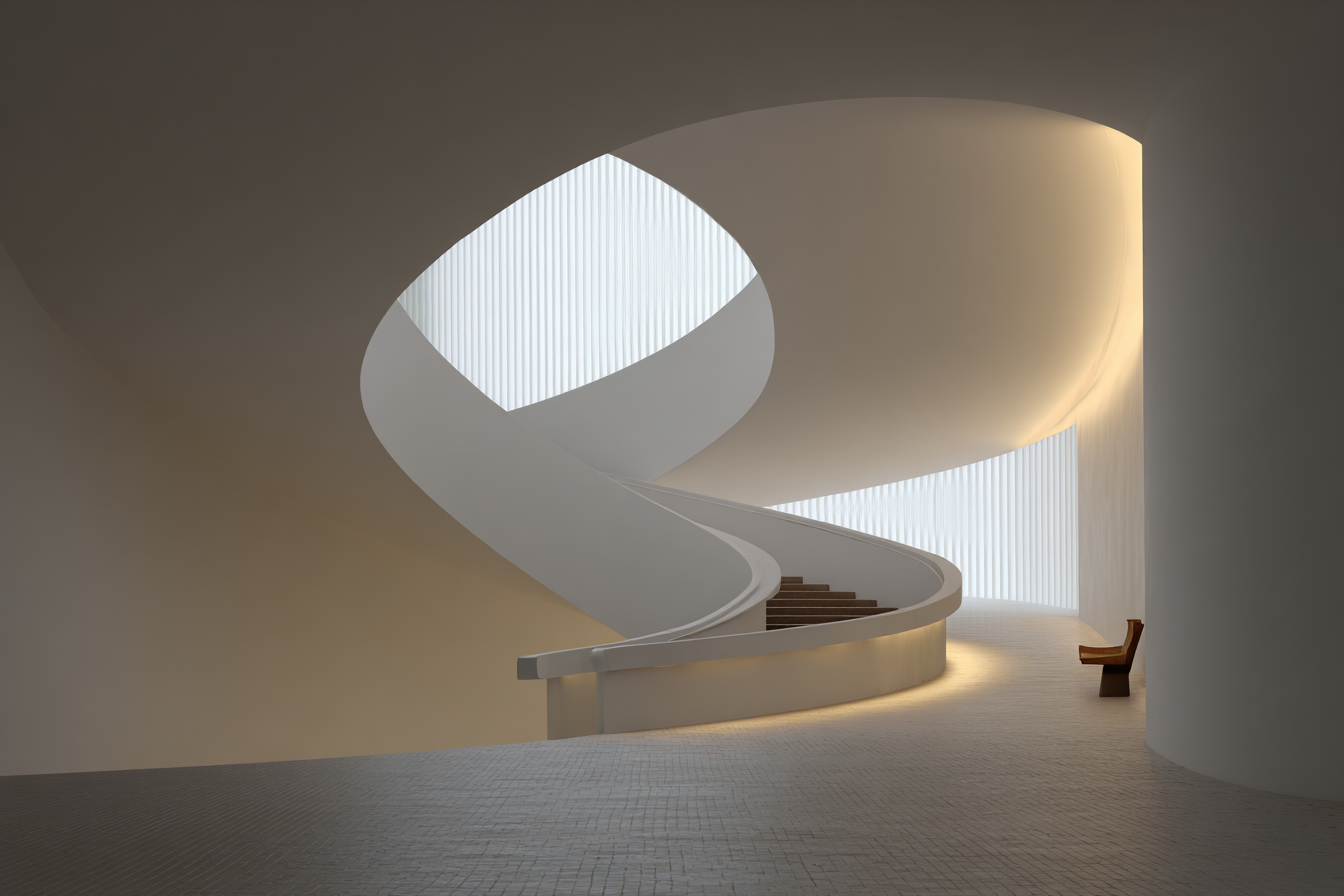
“Ribbon windows at noon, horizon unbroken, 35 mm, f/11, ISO 100, --s 50.” The field becomes a long thought. The sky becomes a page.
📸 Midjourney Prompt:Modernist architecture with continuous ribbon windows under clear noon light, captured with a 35mm lens at f/11 ISO 100. The composition emphasizes unbroken horizontality and the quiet dialogue between structure and landscape, where the open field extends like a long thought beneath an expansive sky. Photoreal clarity with balanced exposure, crisp geometry, and calm atmospheric realism --v 7 --style raw --stylize 50 --seed 1
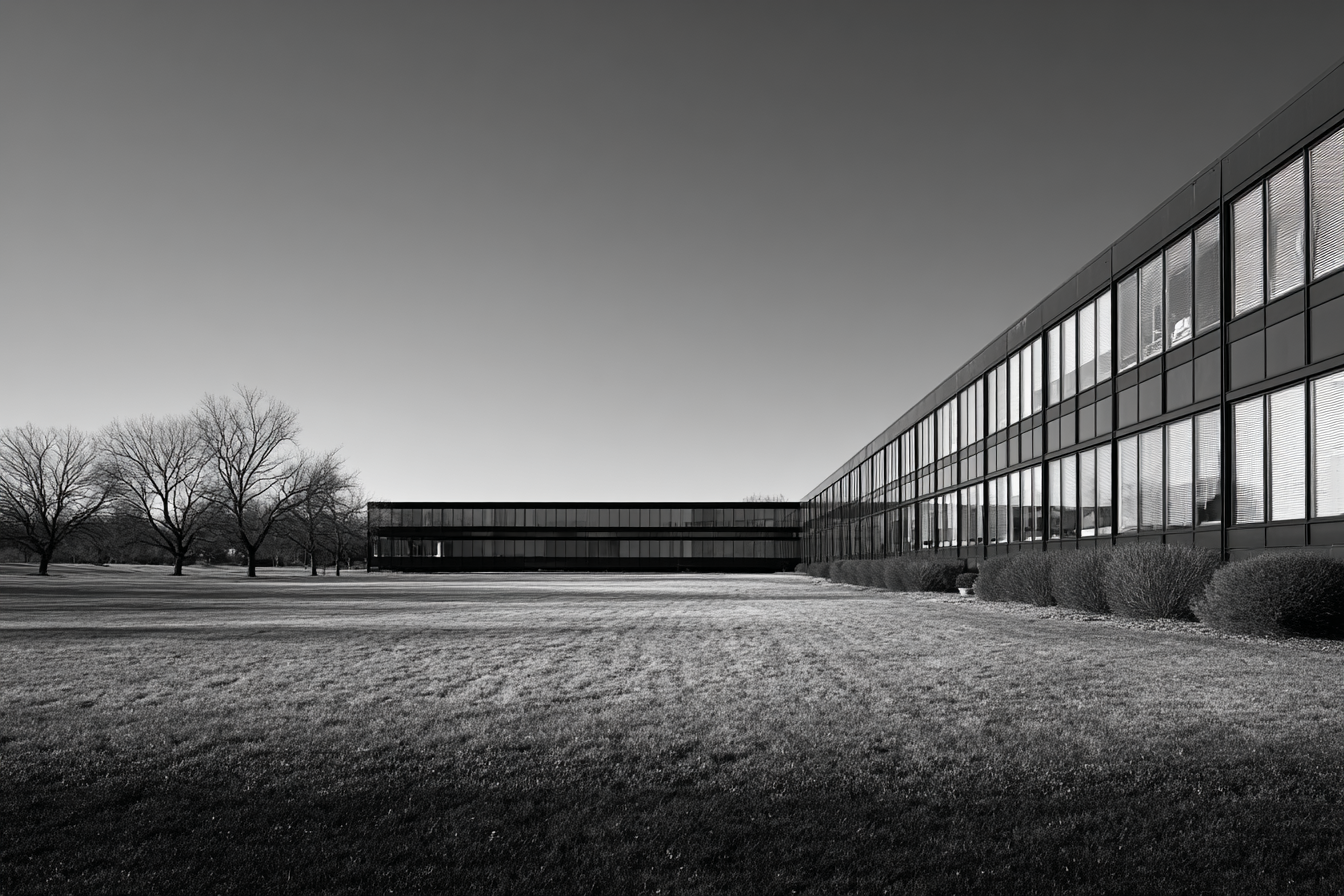
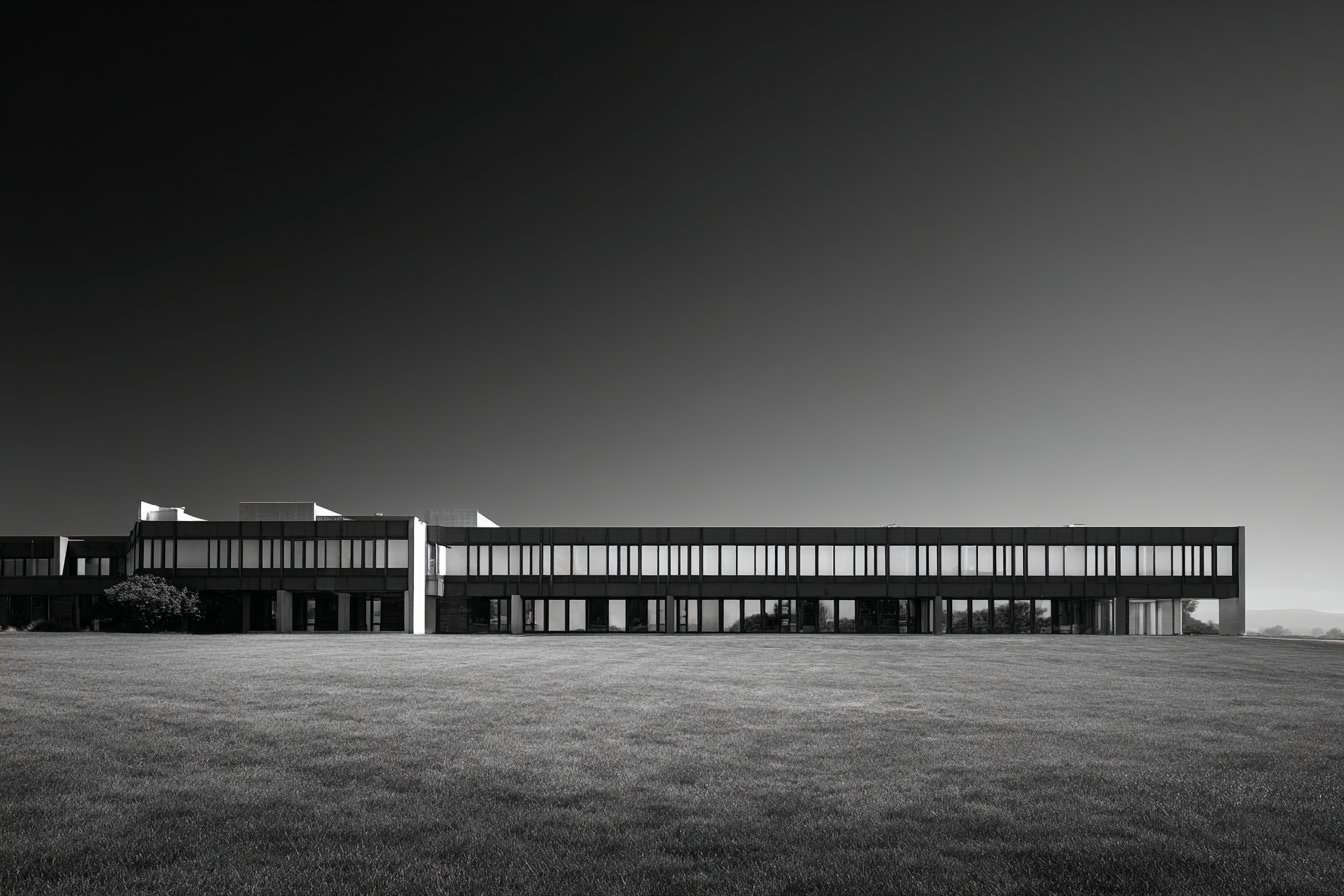
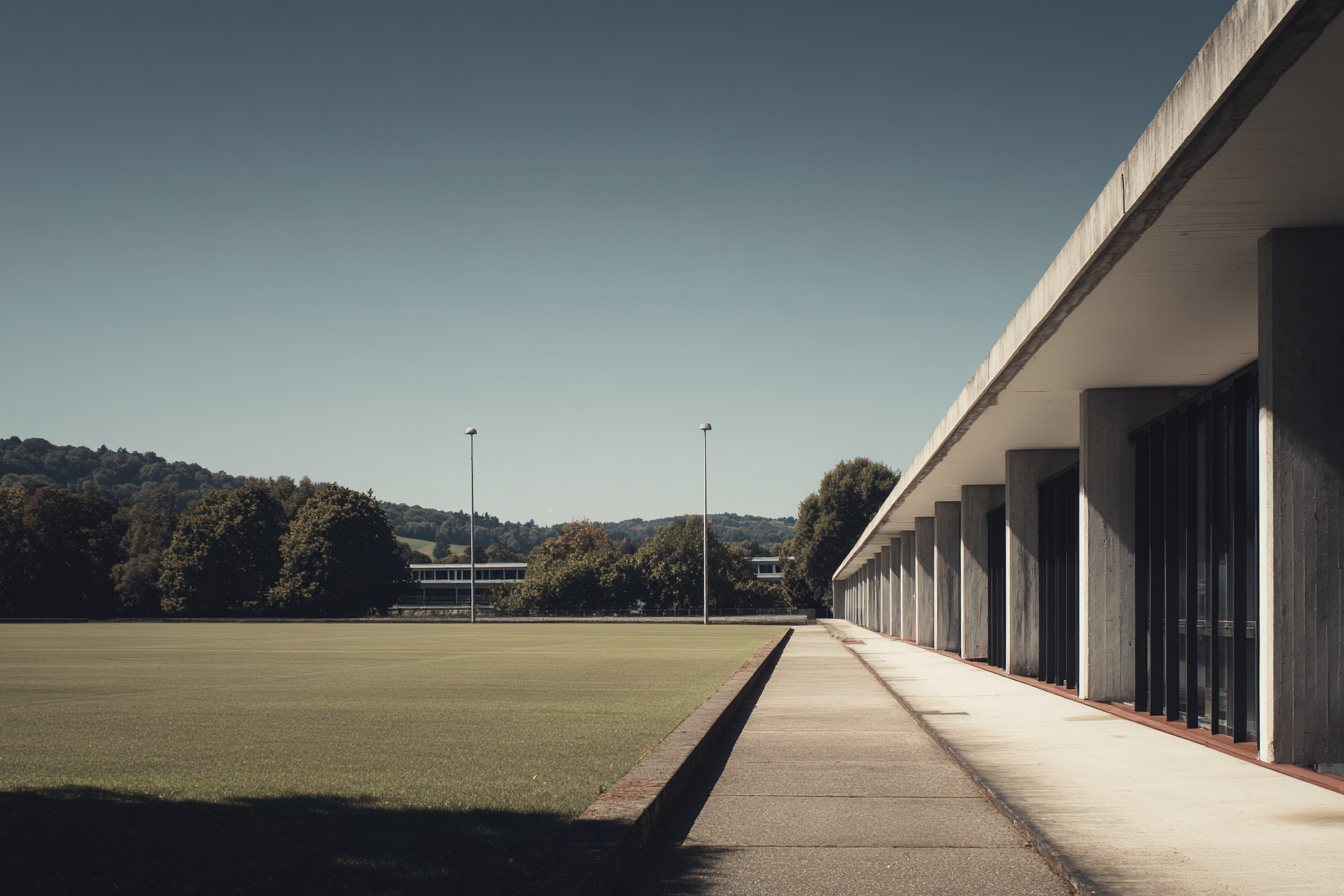
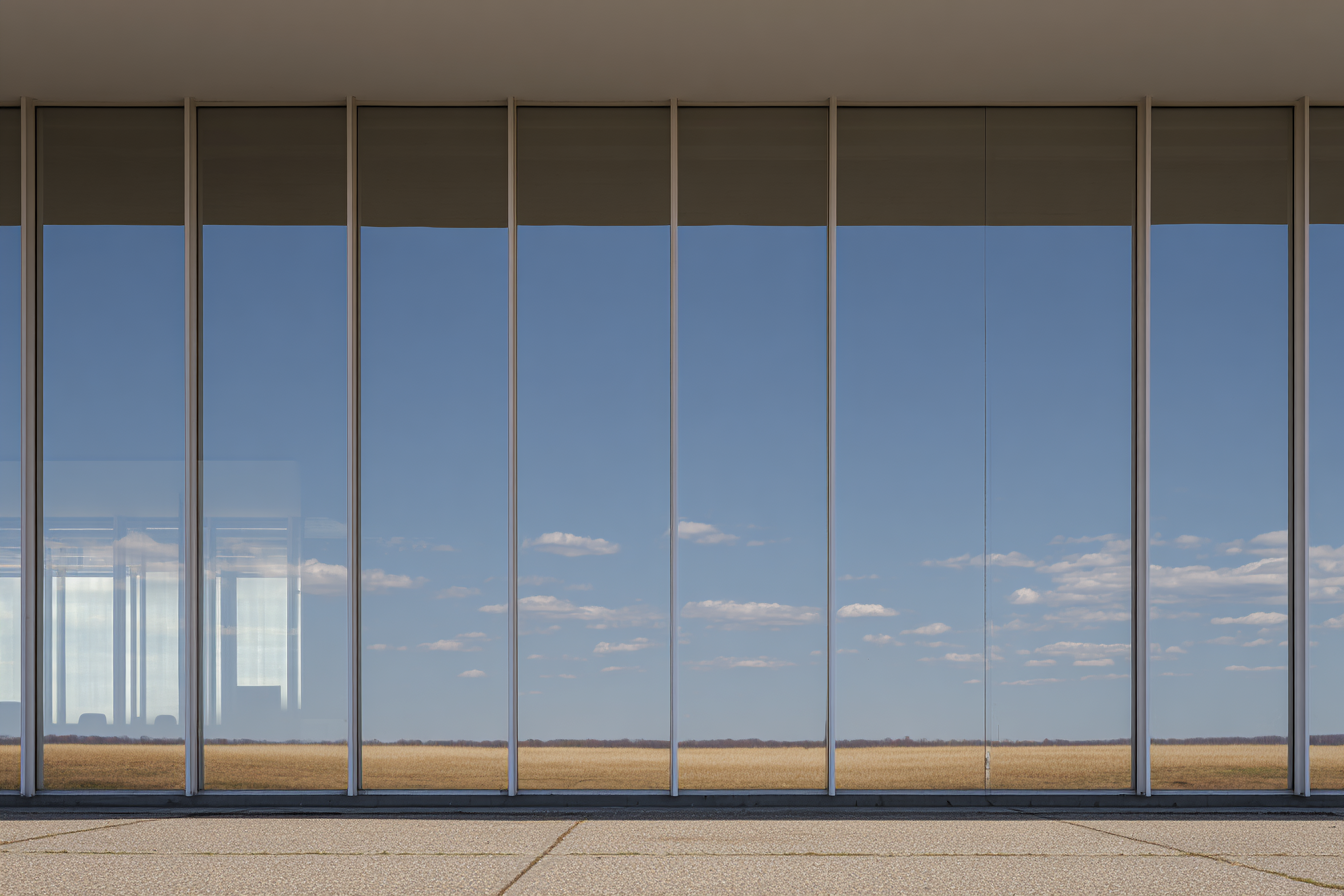
“Roof garden at golden hour, concrete planters, soft wind, 50 mm, f/5.6, ISO 200, --s 90.” The city gives back sky. The house learns to breathe.
📸 Midjourney Prompt:Modernist roof garden at golden hour, concrete planters and soft wind moving through green foliage, captured with a 50mm lens at f/5.6 ISO 200. The design merges architecture and atmosphere, as the city returns its sky and the home opens to light and air. Photoreal composition with warm tonal balance, subtle depth of field, and cinematic natural realism --v 7 --style raw --stylize 90 --seed 1
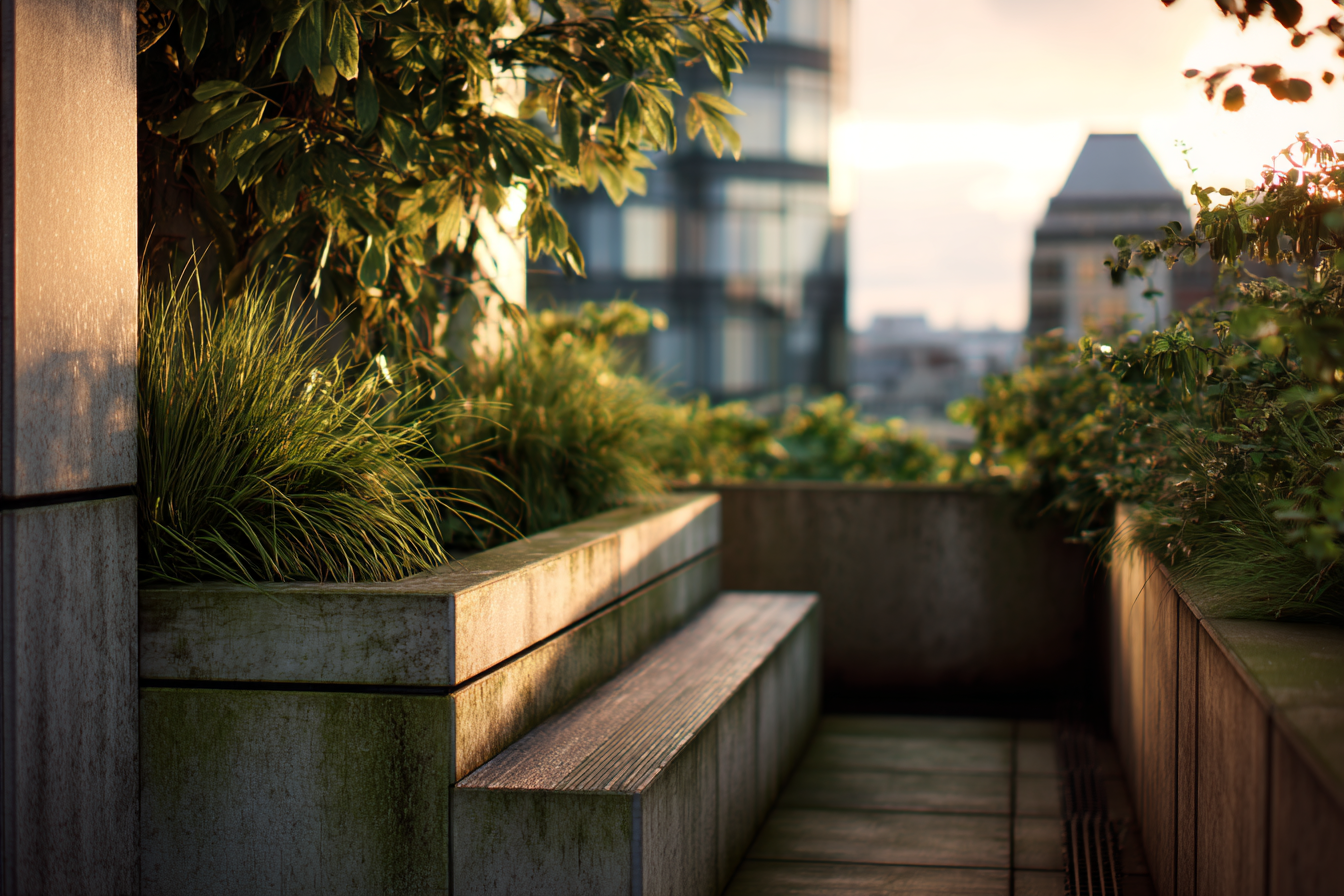
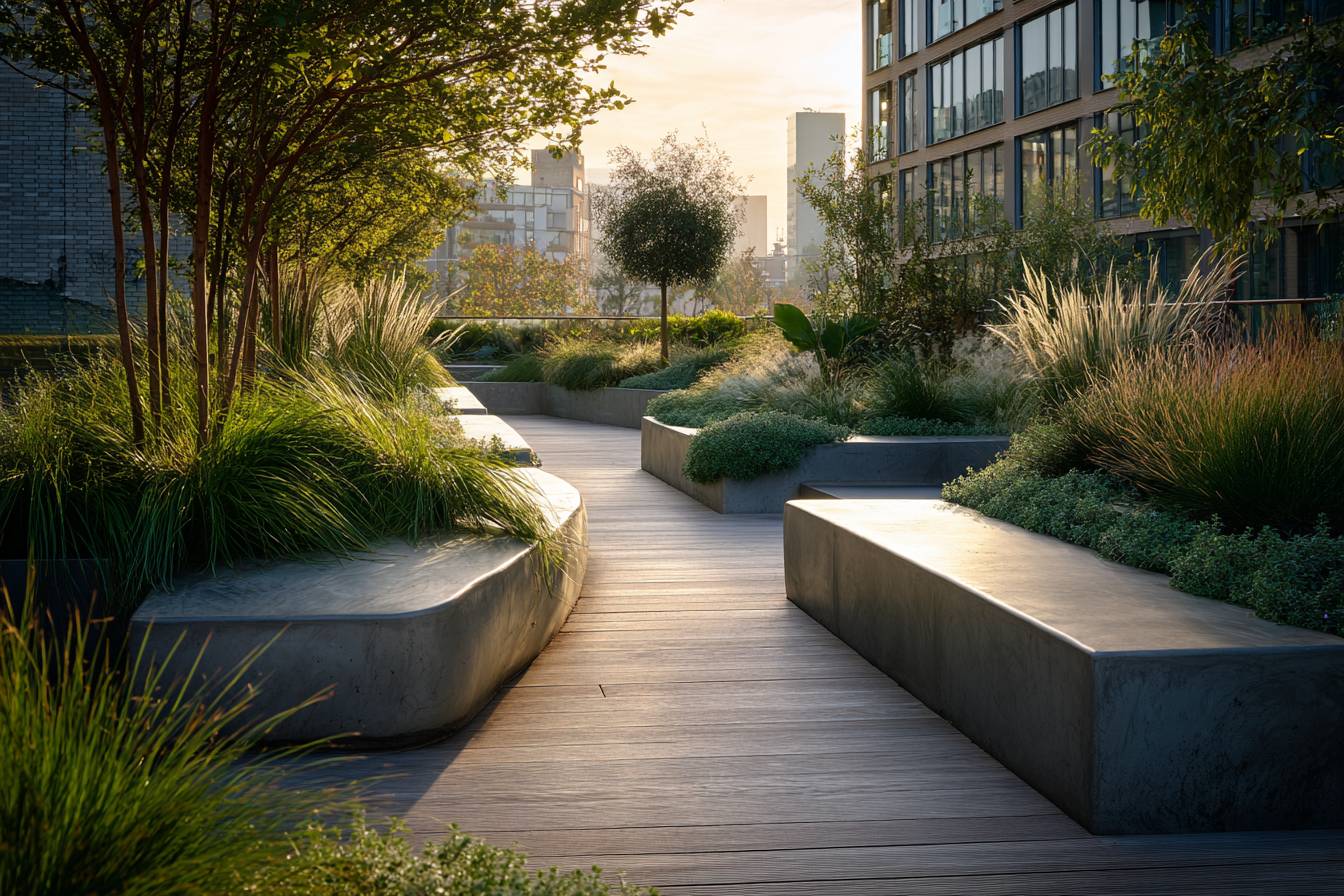
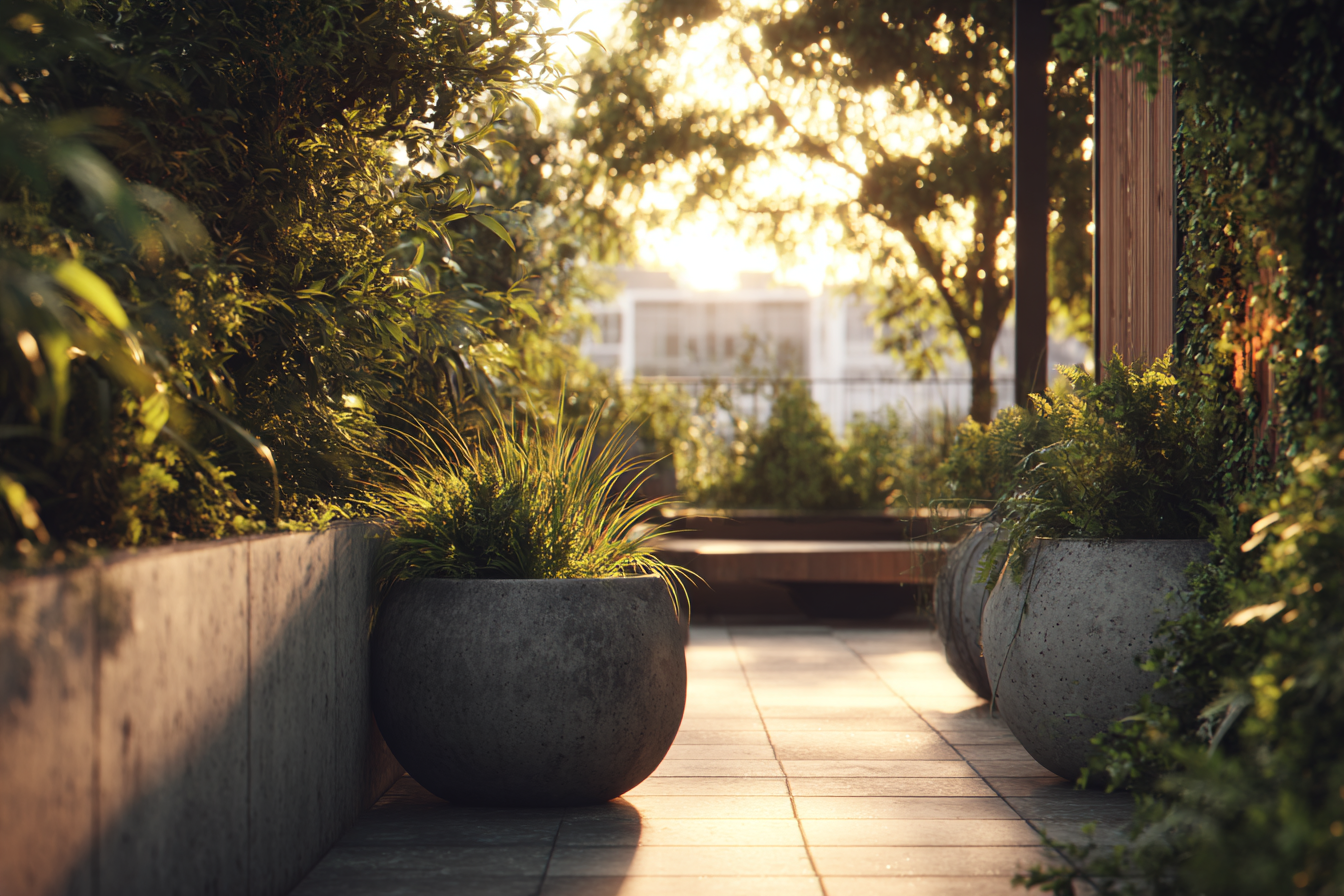
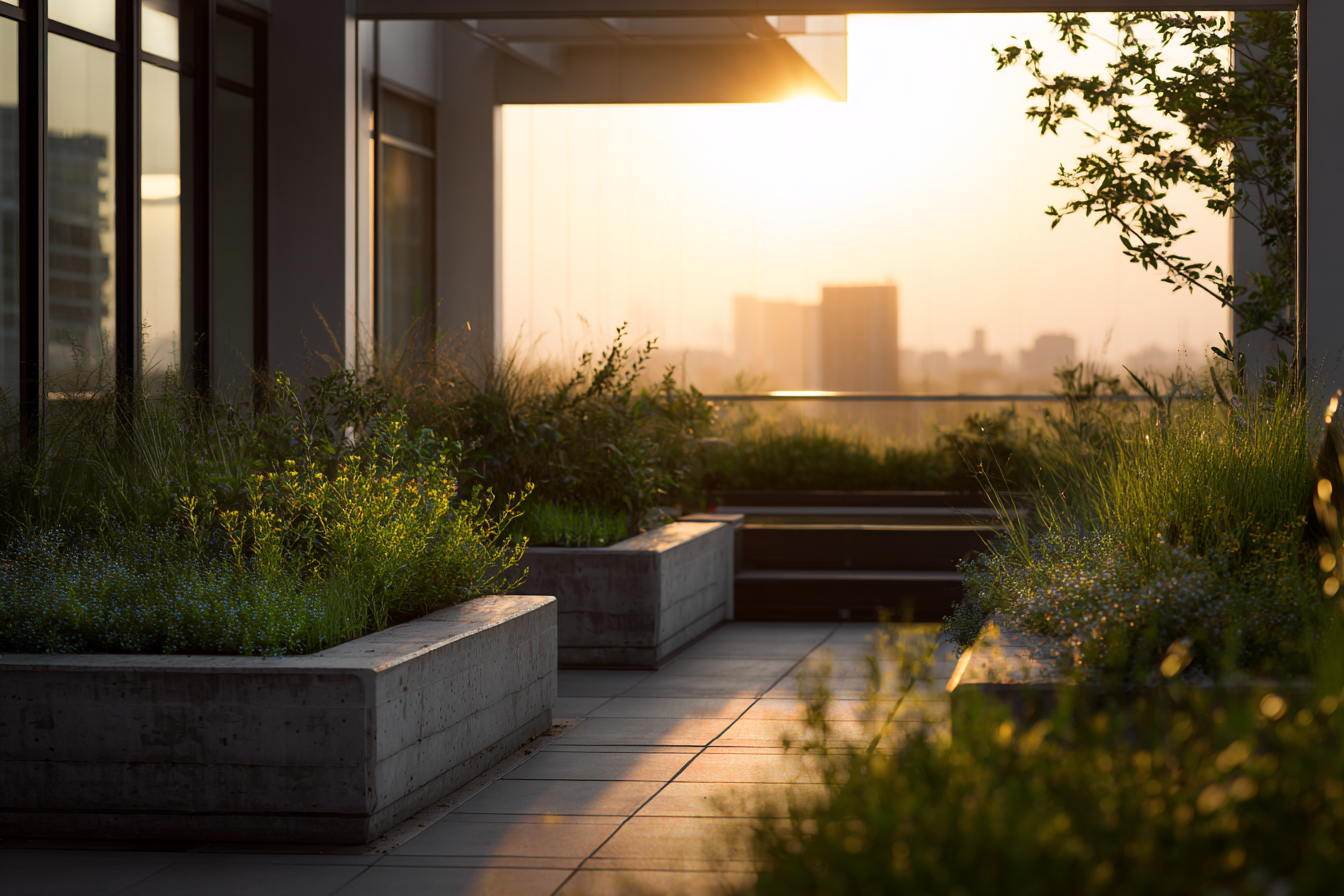
Why the Canon R5 fits his mind
The R5 renders tone with a calm that suits béton brut. Neutrals stay faithful. Edges stay exact. On the Savoye, concrete reads as truth rather than theater. With Neutral picture style and manual Kelvin near 5200, the palette sits where Corbusier placed it, between clinic and compassion.
What the AI hears when we speak like photographers
Midjourney listens to lens, ISO, aperture, shutter the way a draftsman listens to module, axis, proportion, datum. When the language is precise, the image respects use. When the language grows careless, the house forgets how to stand. Speak clearly, and Corbusier’s order returns with warmth instead of frost.
If you want to explore your own concept through this balance of discipline and light, you can collaborate with me on Fiverr. We will shape prompts that honor structure, tune camera language for believable tone, and build images that feel considered, cinematic, and true.
🏢 Adolf Loos and the Nikon Z9, Silence and Surface
Adolf Loos believed that ornament was a crime, but he never declared war on beauty. What he sought was truth, truth in material, truth in proportion, and truth in restraint. Where others filled walls with decoration, he filled them with light and silence. His buildings whispered rather than performed. They taught that a surface, when treated with care, could speak without saying a word.
The Nikon Z9, with its stacked CMOS sensor, 14-bit color depth, and dynamic range that touches shadow like breath, interprets Loos’s philosophy in pixels. Into Midjourney V7 I entered “Viennese townhouse façade, muted winter light, Nikon Z9 50 mm f/1.8 ISO 64, style raw.” The result appeared like a sigh pressed into plaster. Stone turned soft. Reflections from narrow streets bent against windows that refused to glitter. It was quiet and almost humble, the kind of image that feels like thought before speech.
📸 Midjourney Prompt:Viennese townhouse façade in muted winter light, captured with Nikon Z9 50 mm f/1.8 ISO 64, photoreal composition inspired by Adolf Loos’s quiet modernism, soft tonal range and diffused reflections from narrow streets, subtle plaster texture and restrained geometry conveying introspective calm and timeless simplicity, cinematic realism with balanced shadow detail and natural light diffusion --v 7 --style raw --stylize 150 --seed 1
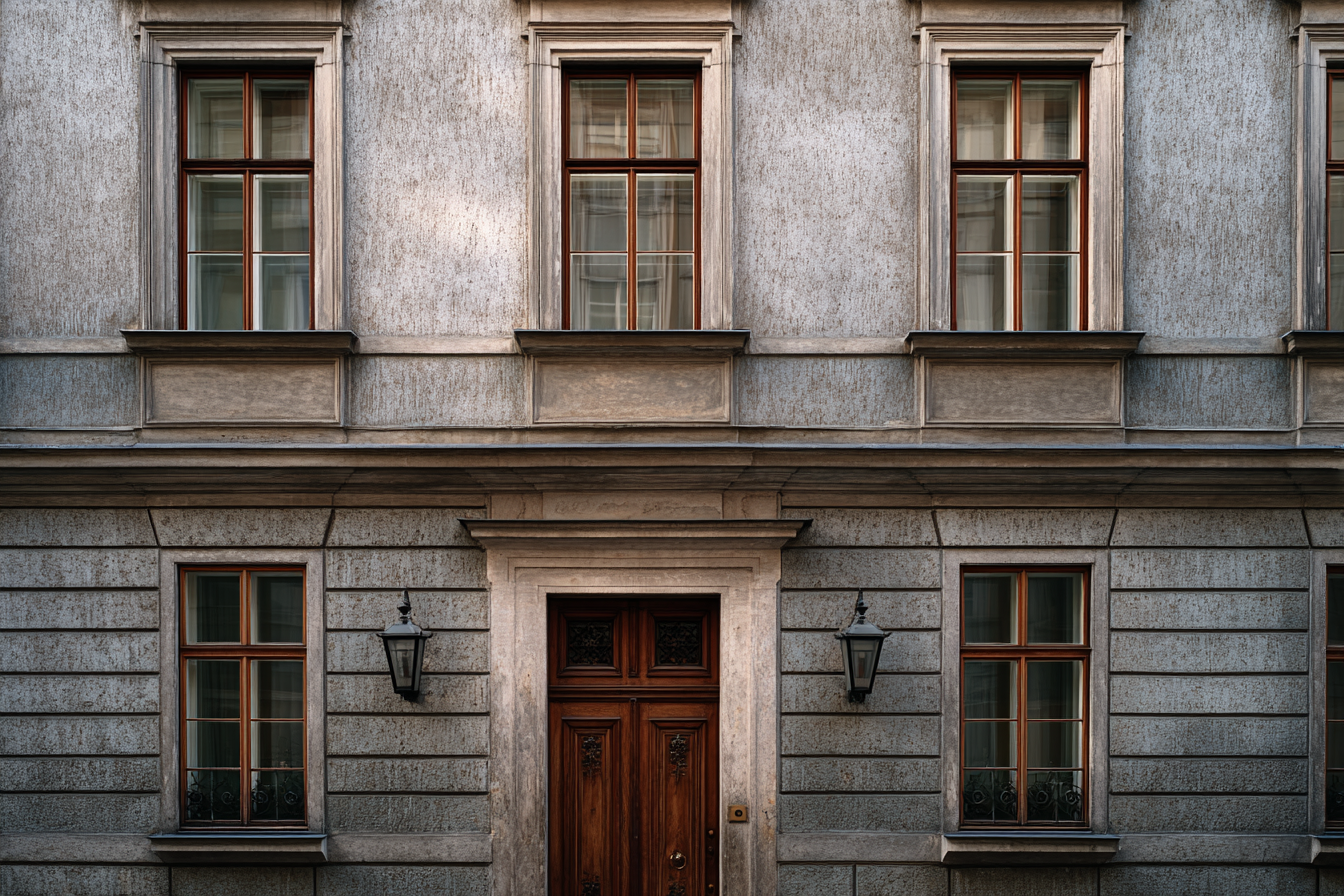
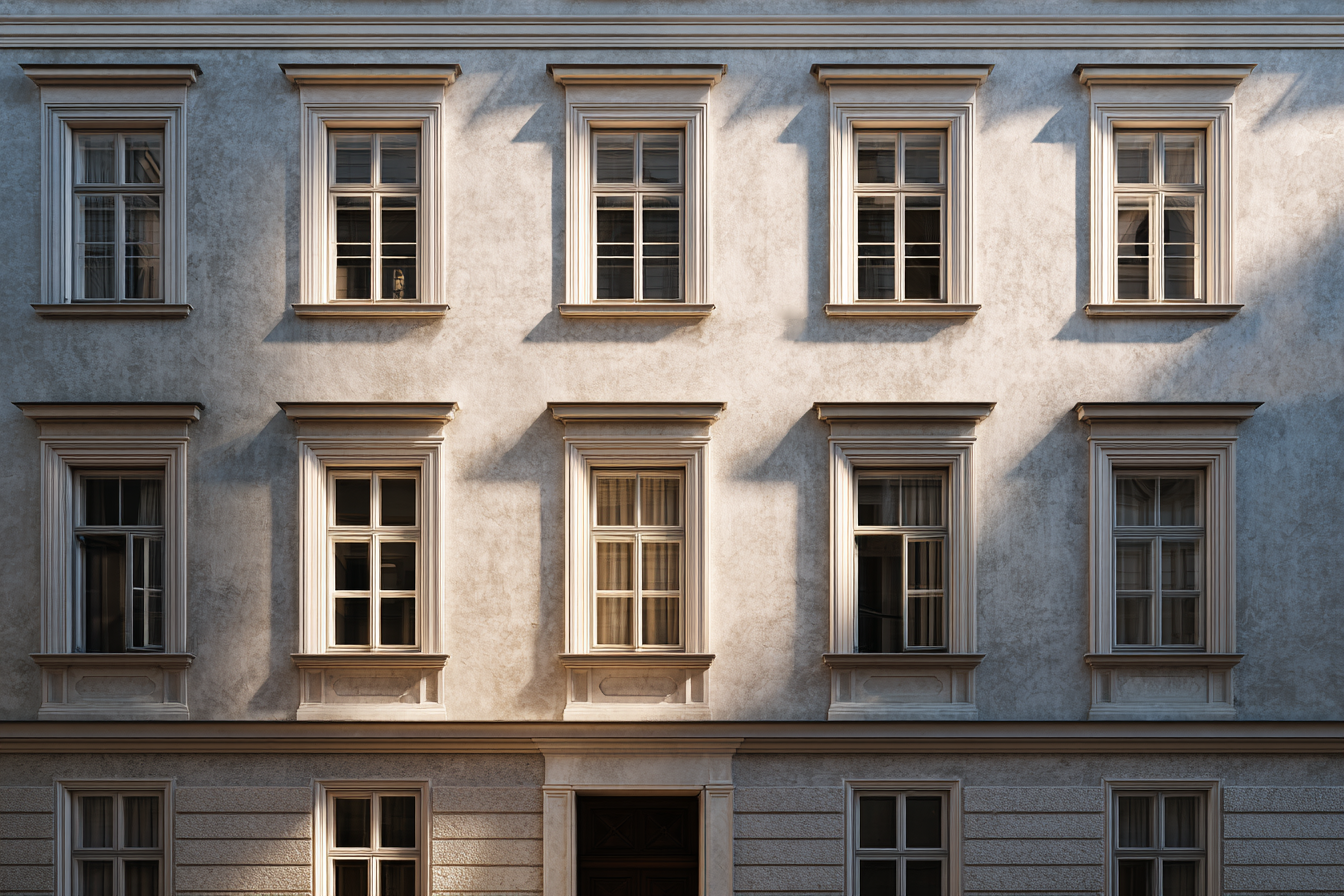
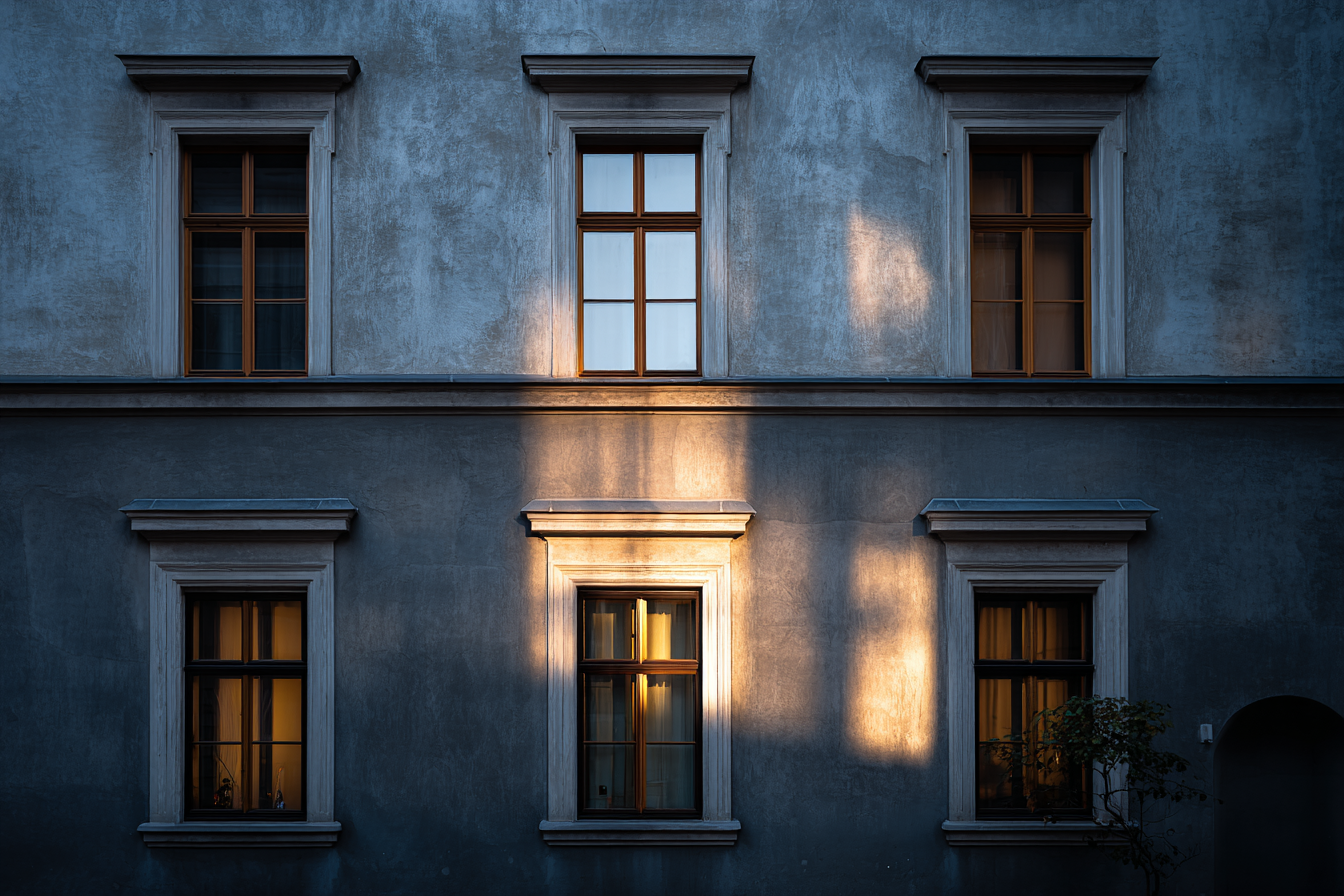
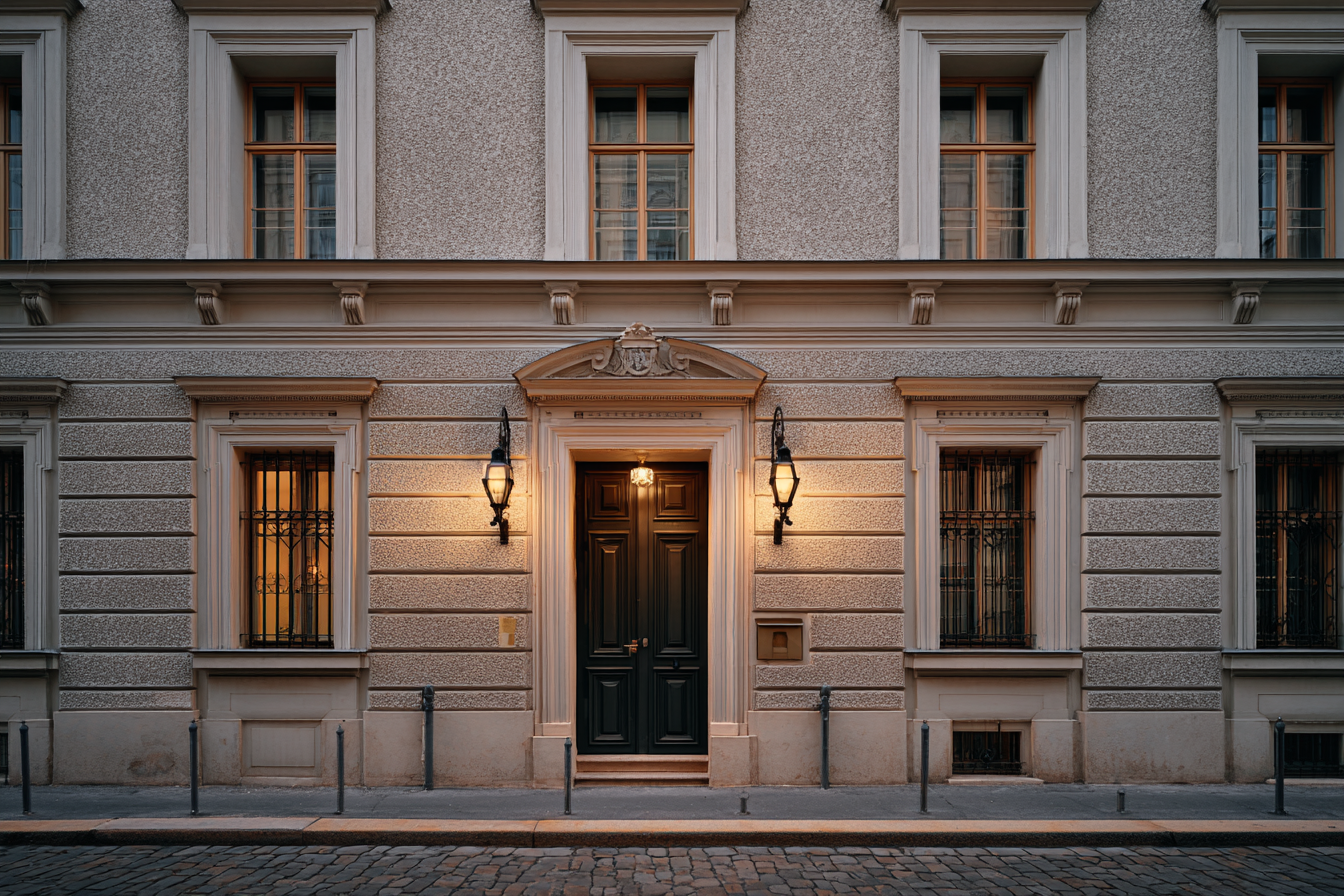
Loos would have approved of the honesty. The AI found texture instead of pattern and discipline instead of decoration. It made marble look as if it remembered being earth. What others call minimalism, Loos called character. Midjourney understood this not through flamboyance but through patience. It rendered stillness as if it were a craft.
Technique for the architecture of silence
Exposure: Underexpose by 0.3 EV to protect highlights and preserve subtle tonal gradations. Loos lived in the half-light between polish and shadow.
Lens and aperture: Use a 50 mm at f/2.8 for intimacy without distortion. The narrow depth of field allows walls to fall gently out of focus and gives surfaces weight without drama.
ISO and tone: Keep ISO at 64 to retain clean neutrality. Loos’s Vienna was not a place of noise. It was a place of measure.
Diffusion and filters: Apply a soft diffusion filter or its digital equivalent to mimic the way his interiors caught daylight through sheer curtains. It calms reflections and restores tactility.
Color: Work within Kelvin 4800 to 5200 for daylight softened by overcast skies. His palette was never bright; it was bone, smoke, and the faint warmth of brass against wood.
Midjourney settings that echo his restraint
Set stylization between s 40 and 75. Anything higher risks false luxury. Loos’s legacy lives in balance, not flourish.
Write your prompt plainly: “natural plaster, soft reflected light, absence of ornament, Nikon Z9 raw realism” and the AI will follow your honesty.
How light becomes morality
In Loos’s world, every line carried an ethic. To lie in architecture was to lie in life. He believed materials should reveal their making. When Midjourney reads these values, it creates surfaces that feel lived in rather than polished. A wall bears its brush marks. Stone remembers its quarry. Even the shadow of a cornice carries a kind of conscience.
When the Z9 interprets this restraint, it captures quiet like music. Its 14-bit tonal gradation lets shadows breathe in steps instead of jumps. The façade looks untouched by ambition. Yet in that restraint there is majesty, the kind that comes from knowing where to stop.
Visual prompts as principle
“Urban townhouse, raw plaster façade, pale winter sky, Nikon Z9, 50 mm f/2.8, ISO 64, muted light, s 60.”
The wall is not empty. It listens.
“Interior study, oak panels and marble stair, Nikon Z9, f/4, ISO 100, early dusk.”
The grain replaces ornament. Space becomes virtue.
Why the Nikon Z9 fits Loos’s temperament
The Z9 is uncompromising in clarity. Its files are honest. It refuses to exaggerate color or contrast, the same way Loos refused to flatter the eye. With neutral picture control, highlight-weighted metering, and a tripod set at 1/60 second, it produces the architectural equivalent of quiet truth.
Loos’s spirit lingers in those frames. You do not look at them for surprise. You look for recognition, for the moment when simplicity feels inevitable. That is his form of poetry.
If you want to explore the discipline of minimalism and see how light can become meaning inside Midjourney, you can collaborate with me on Fiverr. Together, we can build prompts that capture silence, translate restraint into tone, and let simplicity speak with quiet confidence.
🏭 Walter Gropius and the Leica SL2, The Precision of People
Walter Gropius believed that machines could serve humanity without erasing its soul. He did not see technology as cold or inhuman. He saw it as a means of unity, a bridge between hand and mind, between craft and industry. His Bauhaus was not only a school. It was a workshop where art and labor stood as equals. Every chair, every wall, every lamp was a shared act of faith that design could build a better world.
With the Leica SL2, that same faith feels renewed. I entered into Midjourney V7 the words “Bauhaus Dessau courtyard, students in motion, Leica SL2 Summicron 35 mm f/2 ISO 400, style raw, motion blur.” The AI responded with a scene alive with movement and intention. Light caught faces mid-laughter. Shadows stretched across the rational geometry of the courtyard. The structure seemed to breathe in rhythm with its people.
📸 Midjourney Prompt:Bauhaus Dessau courtyard with students in motion, captured with Leica SL2 Summicron 35 mm f/2 ISO 400, motion blur conveying rhythm and energy within precise modernist geometry, soft directional light catching faces mid-laughter, long shadows across concrete and glass, atmosphere alive with collaboration and purpose, photoreal composition balancing human warmth and architectural clarity, cinematic realism with tactile depth and tonal harmony --v 7 --style raw --stylize 200 --seed 1
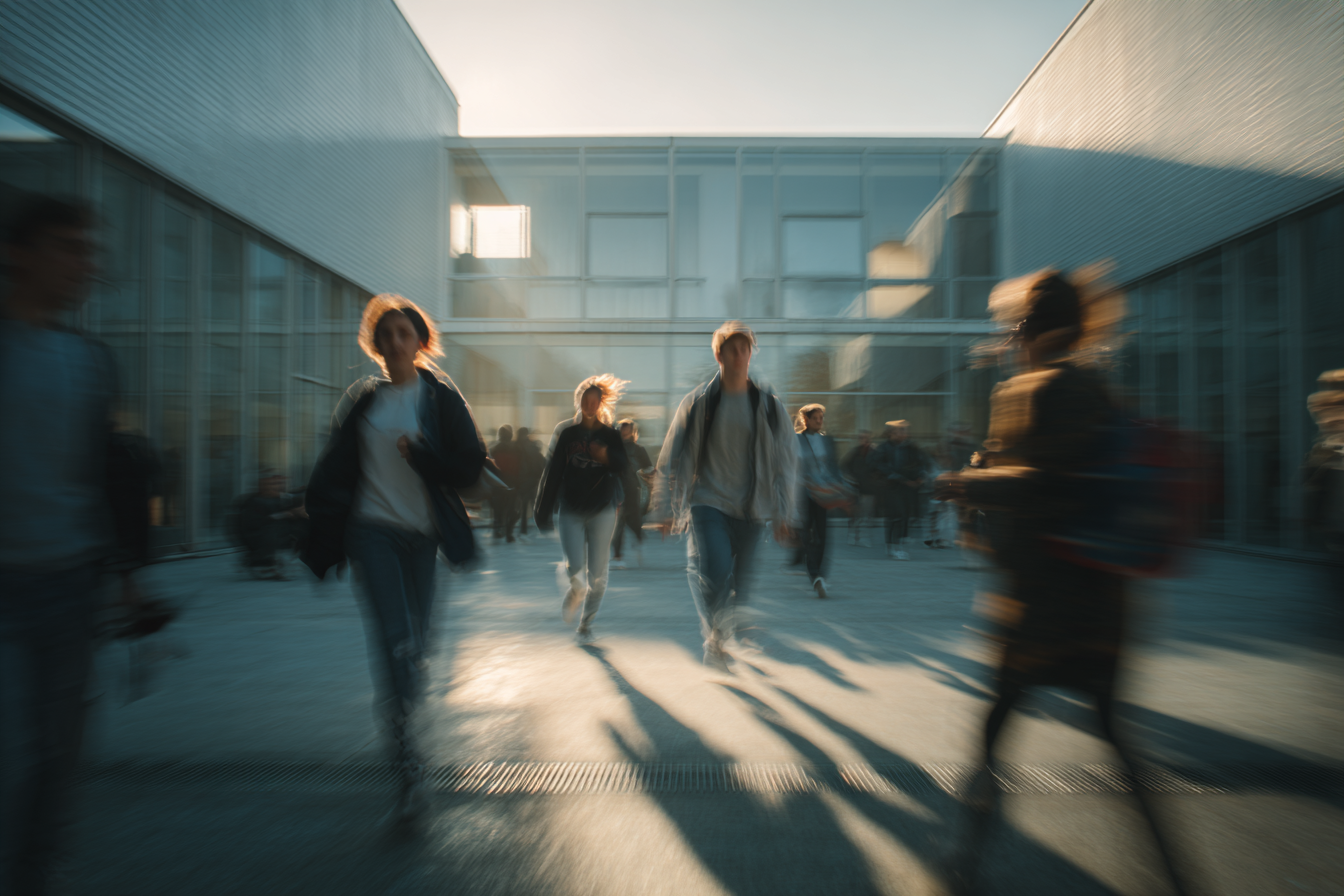
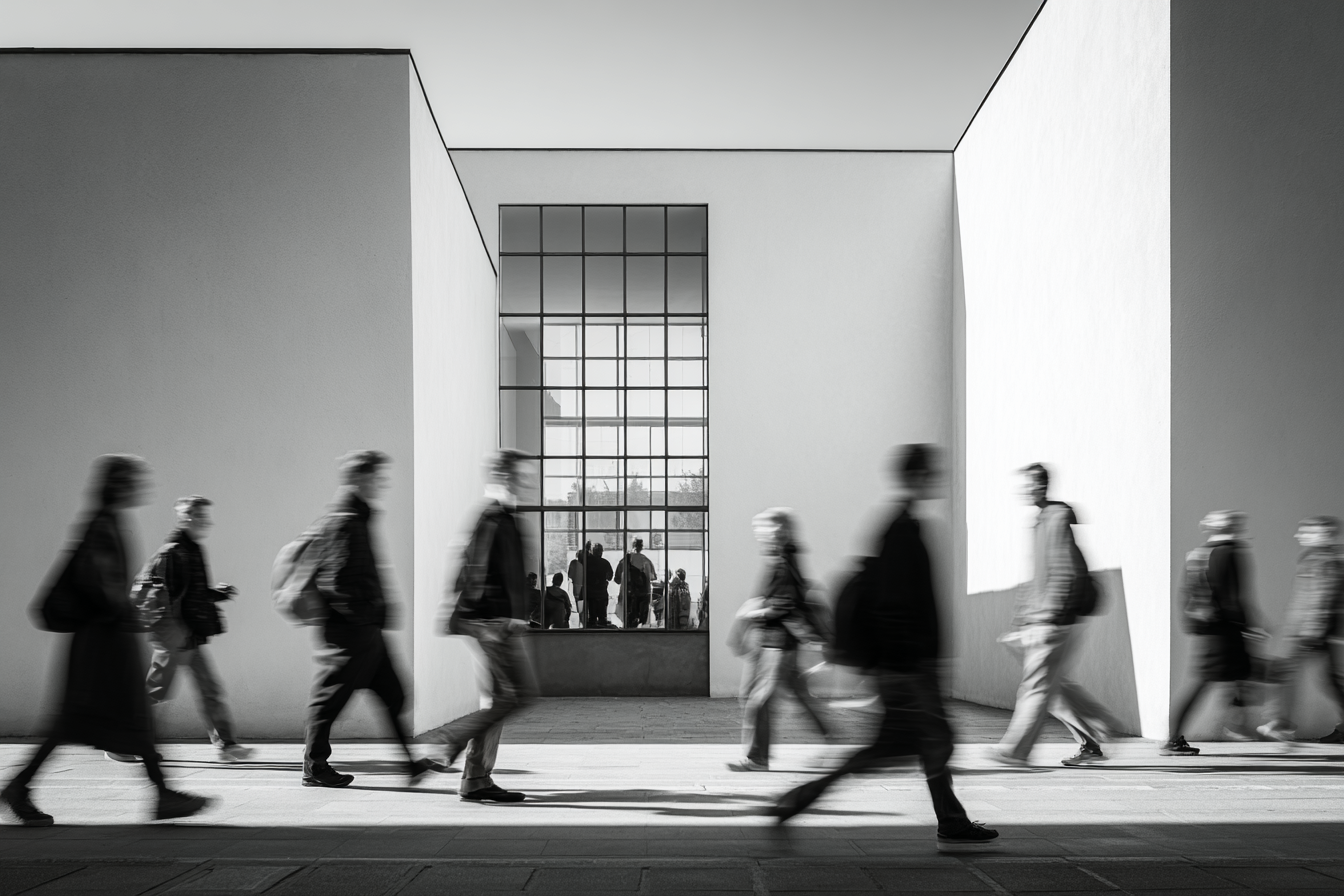
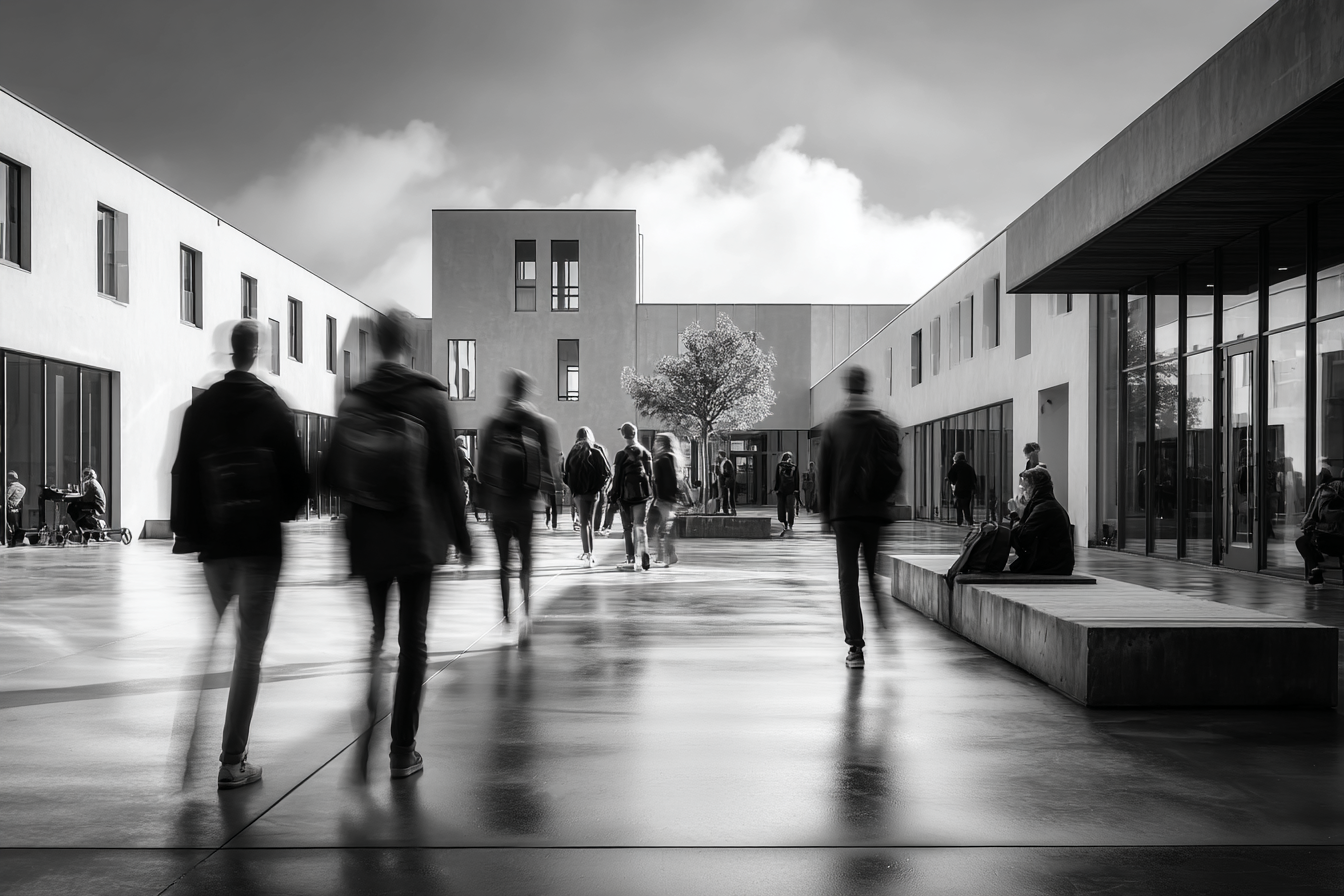
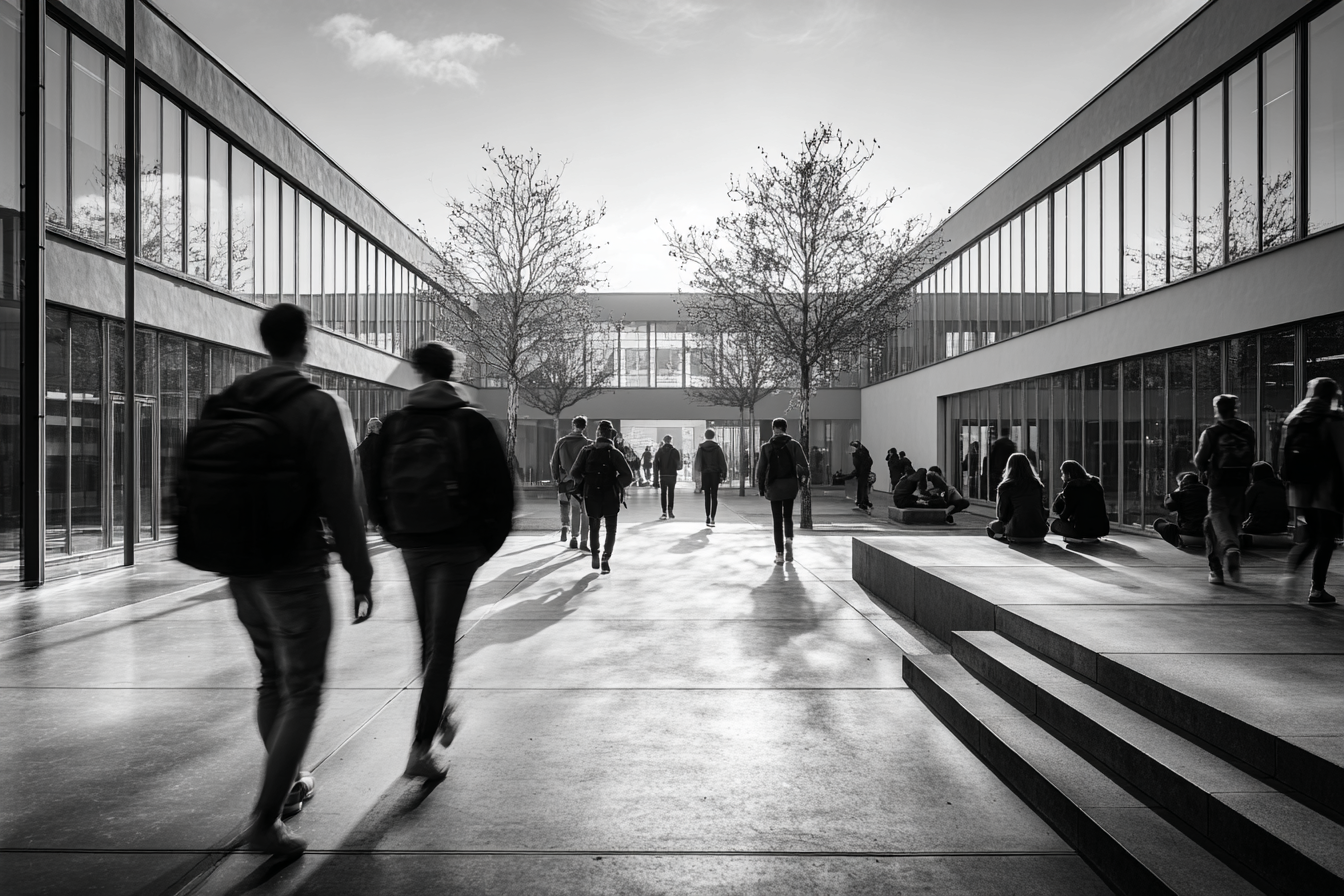
What emerged was not just a building but a conversation between precision and life. Gropius once said that architecture should grow from the collective effort of all the arts. In that prompt, Midjourney seemed to remember. It balanced glass, concrete, and motion the way an orchestra balances strings, brass, and percussion. The image felt like collaboration captured in stillness.
Technique for human precision
Shutter speed: Use 1/30 second to allow motion blur that feels intentional rather than accidental. Gropius believed in the human trace within mechanical order, and that blur preserves it.
Aperture: Use f/2 to keep figures soft while the structure stays clear, giving depth without hierarchy.
ISO: Keep around 400 to maintain the texture of daylight and movement. It adds a gentle grain that feels lived in rather than polished.
White balance: Leave on auto. The goal is honesty, not dramatization. The Leica sensor interprets tone with restraint, similar to how Gropius approached design.
Composition: Frame at human height, about 1.6 meters. The Bauhaus was built for people, not spectacle.
Midjourney settings that echo the Bauhaus spirit
Keep stylization between s 60 and 100 to preserve geometry while allowing fluidity in figures and light. Avoid heavy stylization. Gropius’s work lived in clarity and precision. Use soft morning light or overcast conditions in your prompts to let materials express themselves without distraction.
Write simply:
“Bauhaus Dessau courtyard, students crossing, Leica SL2 35 mm, f/2, ISO 400, motion blur, early morning light, style raw.”
The AI reads this restraint as purpose.
Why the Leica SL2 fits his philosophy
The Leica SL2 embodies the kind of precision Gropius admired. Every line is deliberate and every function direct. It sees without spectacle. Its color science produces truth rather than drama. When used to interpret modernist forms, it renders steel and skin with the same quiet respect. The 50 megapixel sensor translates shadow into understanding rather than ornament.
Light as structure, structure as humanity
At the Bauhaus, light was never just illumination. It was communication. It carried purpose across corridors and workshops. Midjourney seems to understand that, painting reflections on windows that hint at movement inside. You can almost sense the hum of students shaping ideas, the blend of play and precision that defined Gropius’s world.
There is no hero here, only harmony. The courtyard becomes a living grid where people and proportion share the same breath. It feels almost cinematic, not because of motion, but because of empathy.
If you want to see how architecture and humanity can coexist through AI’s quiet precision, you can work with me on Fiverr. Together, we can shape Midjourney prompts that find the poetry in structure, tune light to reveal collaboration, and render the spaces where people and design meet as one.
🏙️ Ludwig Mies van der Rohe and the Hasselblad X2D, Less as Infinity
Ludwig Mies van der Rohe sought perfection in stillness. His architecture was an act of reduction, a slow stripping away until only essence remained. Where others decorated, he distilled. His phrase “less is more” was not a slogan. It was a belief that clarity could be sacred, that simplicity could hold infinity inside it.
The Hasselblad X2D 100C feels like the tool Mies had been waiting for. Its medium format sensor captures light with an honesty that borders on reverence. Each pixel appears carved rather than recorded. When I entered into Midjourney V7 the words “Barcelona Pavilion, reflective floor, Hasselblad X2D 45 mm f/4 ISO 100, midday neutral light, style raw”, the result was a space suspended between photograph and meditation.
📸 Midjourney Prompt:Barcelona Pavilion interior with reflective marble floor, captured with Hasselblad X2D 45 mm f/4 ISO 100, midday neutral light, minimalist modernist composition inspired by Ludwig Mies van der Rohe, emphasizing clarity, balance, and stillness. Polished stone surfaces reflecting soft daylight, slender steel columns in precise alignment, glass and water merging in quiet equilibrium. Photoreal rendering with serene atmosphere, clinical yet gentle tonal range, and contemplative spatial rhythm --v 7 --style raw --stylize 150 --seed 1
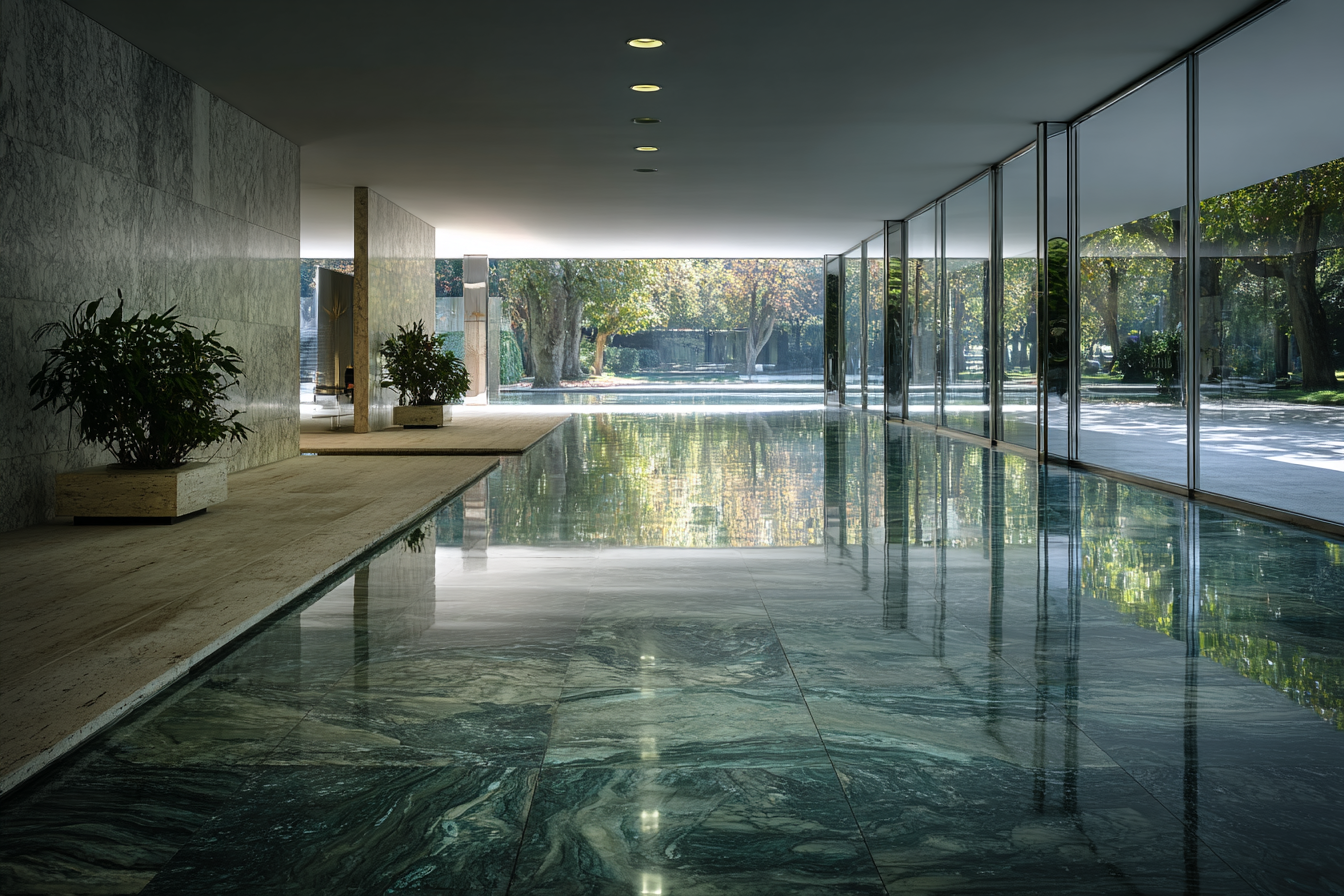
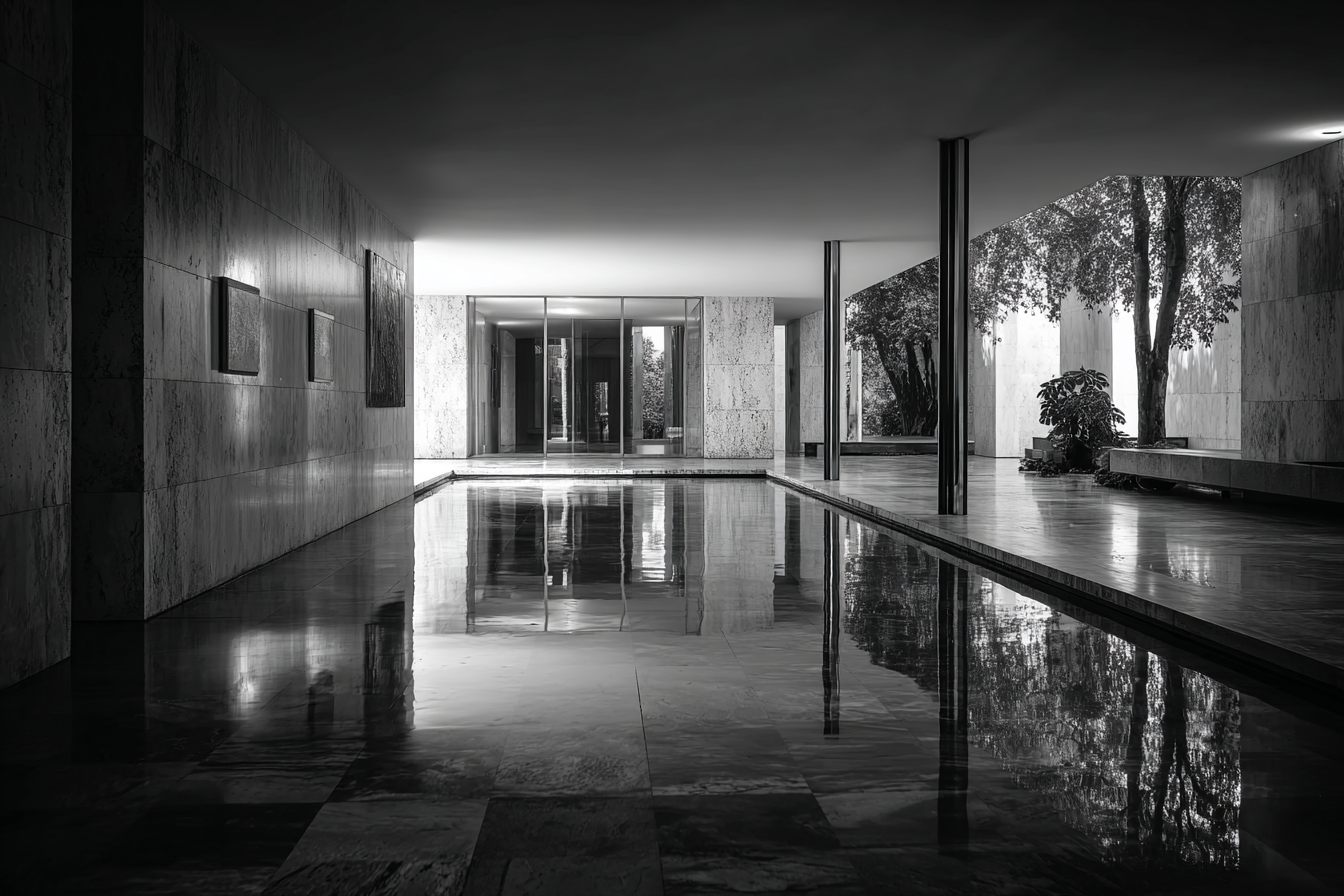
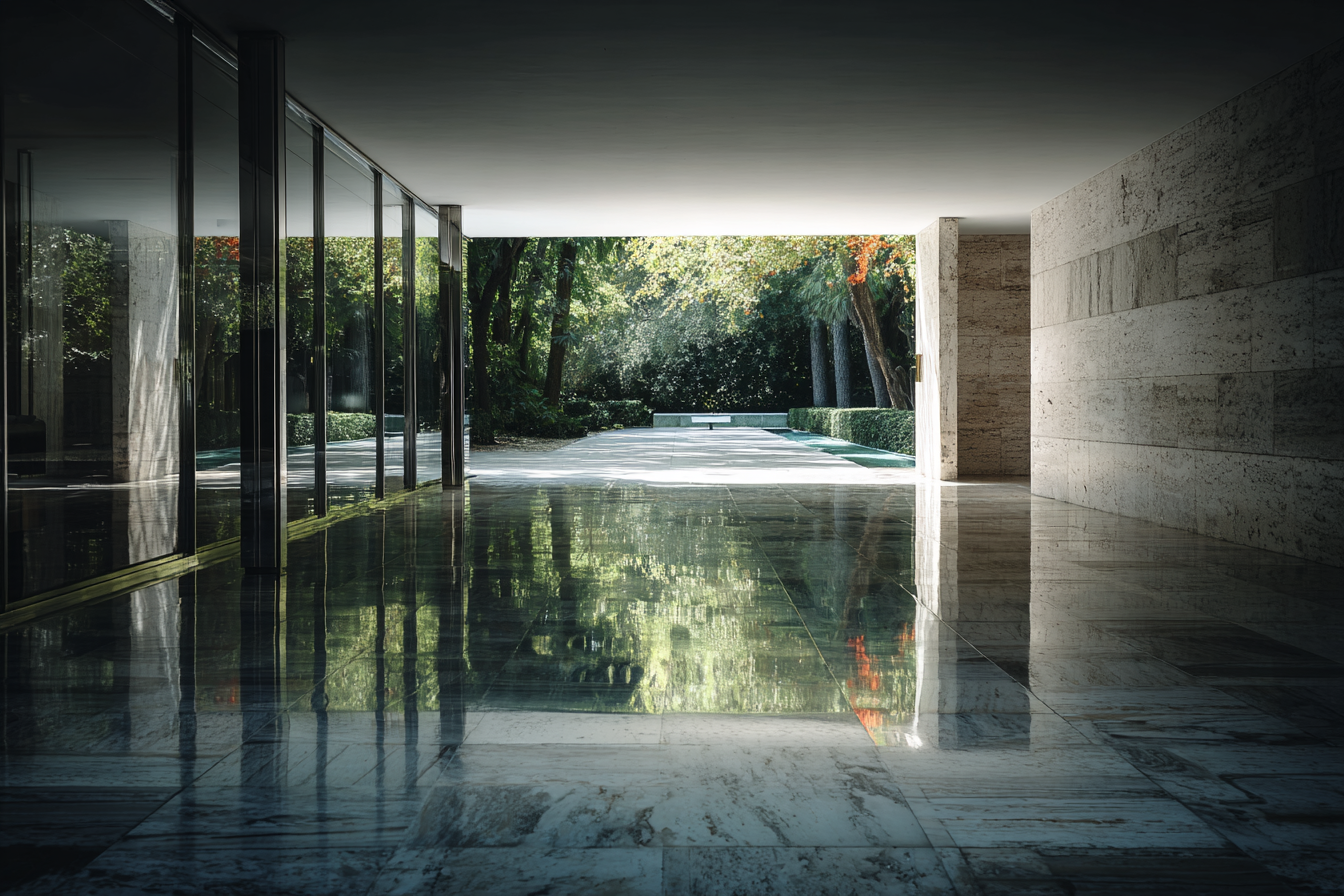
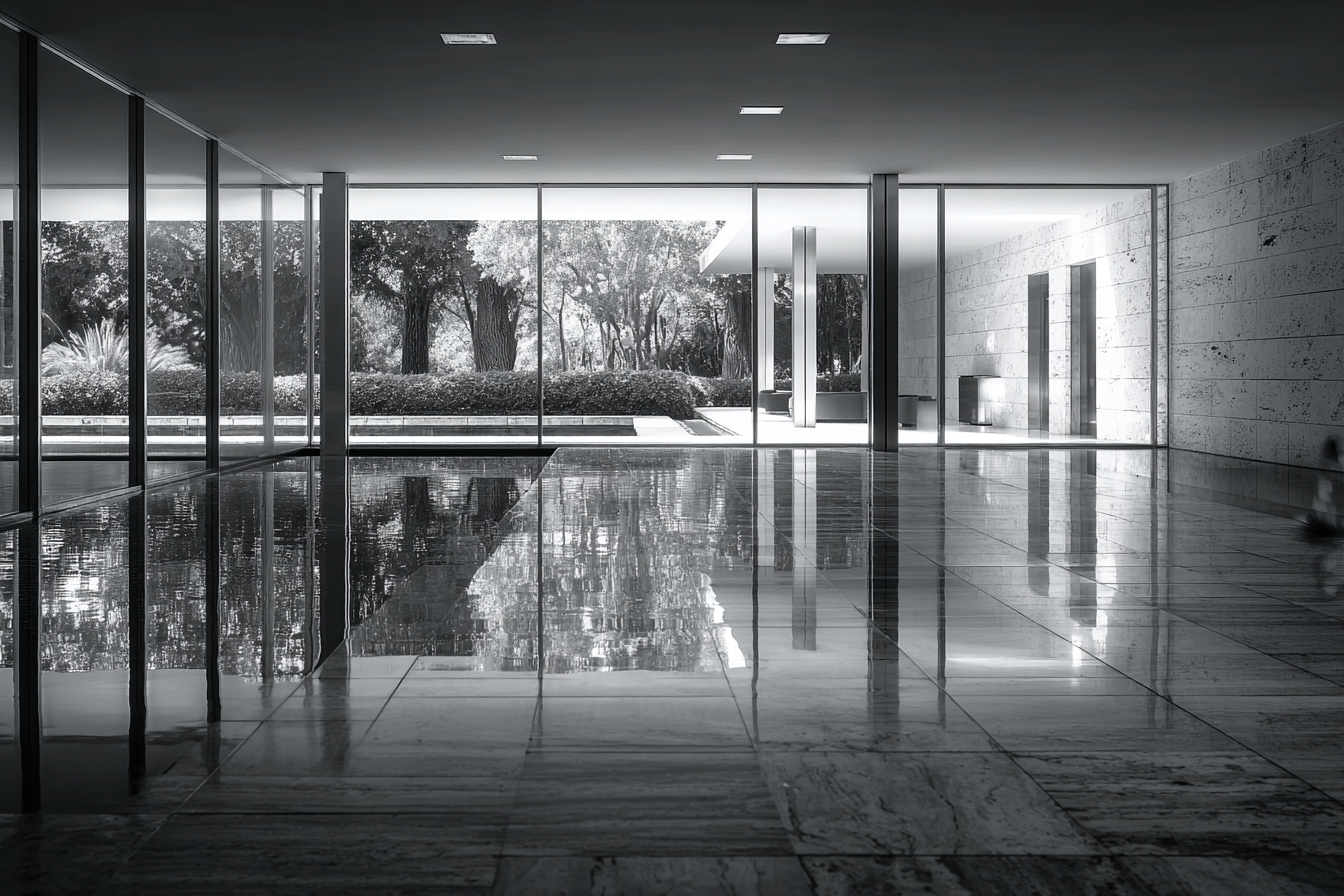
What emerged was not an image of a building. It was a study in silence. The marble reflected sky like water. Steel columns stood with the discipline of monks. Even the shadows behaved. The AI rendered the Barcelona Pavilion as Mies might have imagined it on his calmest day: perfect balance, no gesture wasted.
The light felt clinical yet kind, the way Mies might have spoken to a student. Every surface was measured. Every edge was patient. In the reflection of stone, I could see what he meant when he said that architecture is “the will of an epoch translated into space.”
Technique for clarity that breathes
- Tripod mount for absolute precision. Mies built from the ground up and every image deserves the same foundation.
- Aperture f/4 to keep structure sharp but allow the background to soften into stillness.
- ISO 100 for the purest tonal range, no digital grain, only quiet.
- White balance at Kelvin 5200 for chromatic neutrality. This keeps marble white, glass honest, and reflections clean.
- Shutter 1/60 second to let light find its rhythm without rush.
Midjourney settings that reflect discipline
Keep s set between 40 and 80 for architectural fidelity with a touch of atmosphere. Write prompts with care, avoiding adjectives that add drama. Use words like neutral, minimal, reflective, balanced, and quiet. Mies believed restraint was not limitation. It was freedom.
Example Prompt:
“Barcelona Pavilion interior, reflective onyx wall, minimalist modernism, Hasselblad X2D 45 mm, f/4, ISO 100, neutral daylight, style raw, s 60.”
Here, every word functions like material: clean, ordered, complete.
Why the Hasselblad X2D belongs to Mies’s vision
The Hasselblad X2D is an instrument of truth, not embellishment. Its files feel clinical yet filled with emotion. The dynamic range handles transitions from glass to marble to water with steady calm. Where other cameras search for story, the X2D listens for silence. It understands Mies’s belief that structure is not a frame for life but life itself.
Through Midjourney, that silence becomes visible. The AI reads every beam and plane with the patience of an architect tracing proportion by hand. Light moves across the Pavilion like time passing over thought. You begin to understand that less is not merely aesthetic. It is an act of faith, in order, in space, and in humanity’s ability to pause.
If you want to see your own architectural ideas expressed in this language of restraint and clarity, you can work with me on Fiverr. Together, we will shape prompts that render stillness with precision, light with empathy, and design with purpose. Every project, no matter how simple, deserves its own light, one that speaks softly and lasts.
🧱 The Evolving Language of Modernism: A Century Reimagined Through Midjourney V7
The first generation of modernists gave the world a new alphabet of architecture, but the second wave turned that alphabet into poetry. Between 1910 and 1920, form began to breathe. Concrete softened into curve. Steel reached toward the light. Function started to flirt with feeling. What began as rebellion matured into reflection, and architecture learned to whisper instead of shout.
Through the evolving lens of Midjourney V7, that transformation feels alive again. Each image becomes a quiet collaboration between human intuition and machine interpretation, a shared gaze that stretches across a century. The AI does not simply copy form. It interprets intent. It reads rhythm, proportion, and light as if studying the ghosts of the past through the glass of the present.
Modernism, as presented in the MoMA Collection: Modern Architecture 1900 to 1940, was never only about design. It was a philosophy of honesty, a belief that space could speak its own truth without the costume of ornament or nostalgia. To these architects, form was not decoration. It was dialogue. A column carried not just weight but purpose. A window opened not only to air but to meaning.
As Midjourney reimagines their legacy, it gives us more than nostalgia. It offers a new grammar for the old language of form. Light becomes syntax. Shadow becomes punctuation. What the early modernists once expressed with steel and stone now unfolds in pixels and code, yet the message remains the same: build with clarity, think with integrity, and let beauty emerge from purpose.
When we prompt these digital visions, we are not creating imitations. We are extending a conversation. We are standing in the place where Le Corbusier’s geometry, Aalto’s warmth, and Mies’s silence still meet. Through these images, modernism escapes the confines of archives and textbooks. It becomes a living dialogue, written again in light, proportion, and restraint.
If the first modernists sought to free architecture from ornament, this new collaboration between art and algorithm seeks to free imagination itself. The machine learns from us, and in return, it reminds us what it means to see.
Because every era, no matter how advanced, still returns to the same question that haunted the modernists a century ago:
How do we build with both reason and soul?
🌲 Alvar Aalto and the Fujifilm GFX100 II, Nature in Human Form
Alvar Aalto believed that architecture should feel alive. His buildings did not stand still. They breathed. Walls curved like rivers turning through forests. Ceilings opened like leaves reaching toward light. Every material he touched, wood, glass, and copper, carried a quiet pulse, a memory of nature translated into human space.
When I entered “Paimio Sanatorium interior, morning sunlight across birch walls, Fujifilm GFX100 II 45 mm f/2.8 ISO 200, style raw” into Midjourney V7, the result felt less like a render and more like a moment remembered. The birch grain shimmered with warmth. The air glowed as if touched by recovery itself. The Fujifilm GFX100 II, with its large medium format sensor, translated texture into empathy. Every pixel carried softness, as though the camera itself could feel the heartbeat of the building.
📸 Midjourney Prompt:Paimio Sanatorium interior bathed in gentle morning sunlight, birch wood walls glowing with natural warmth, captured with Fujifilm GFX100 II 45 mm f/2.8 ISO 200. Scandinavian modernist composition inspired by Alvar Aalto, expressing organic form, soft curvature, and healing light. Warm tonal palette with diffused highlights across wood, pastel surfaces, and glass reflections, evoking tranquility and care through human-centered design. Photoreal rendering with tactile texture, atmospheric calm, and poetic realism --v 7 --style raw --stylize 180 --seed 1
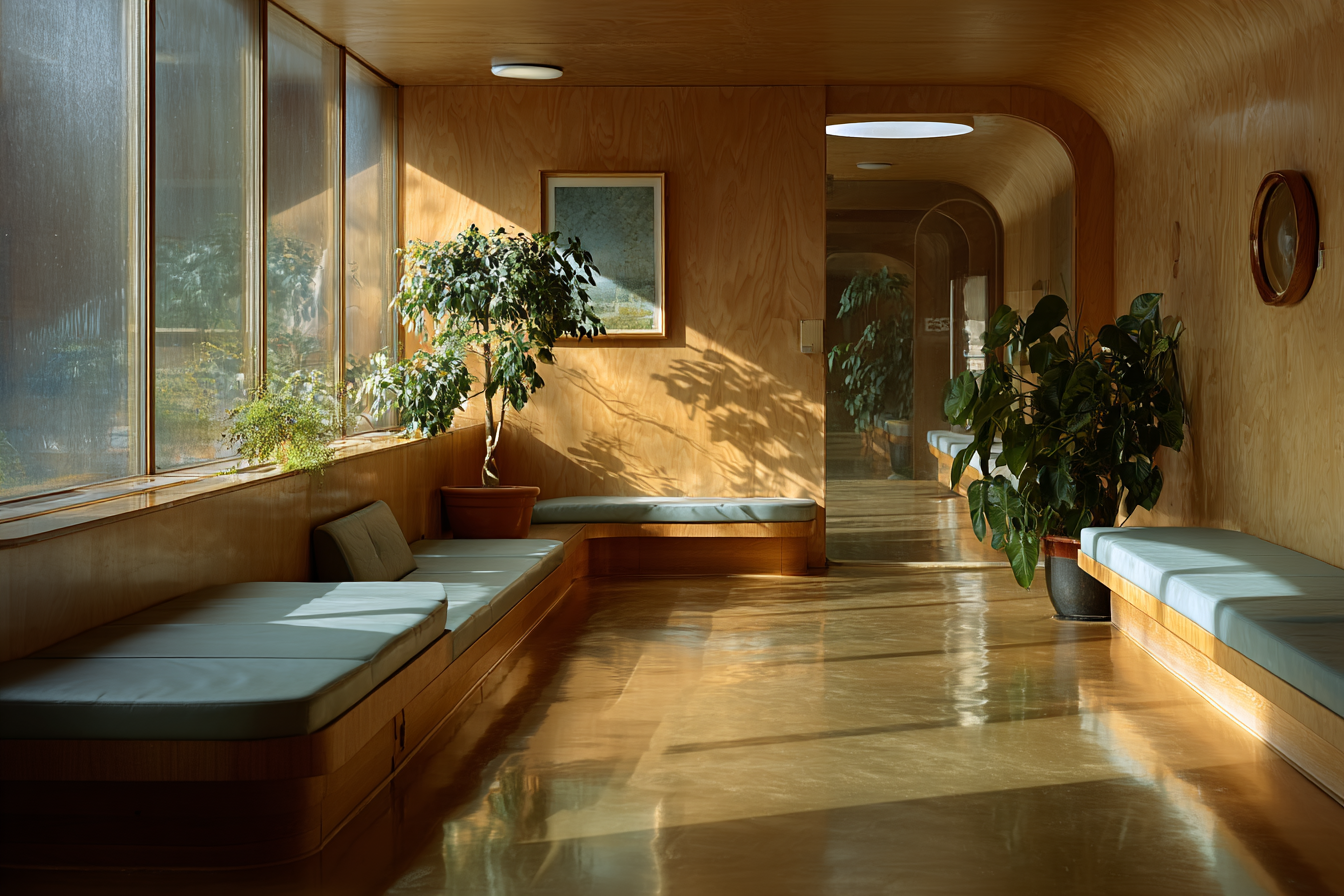
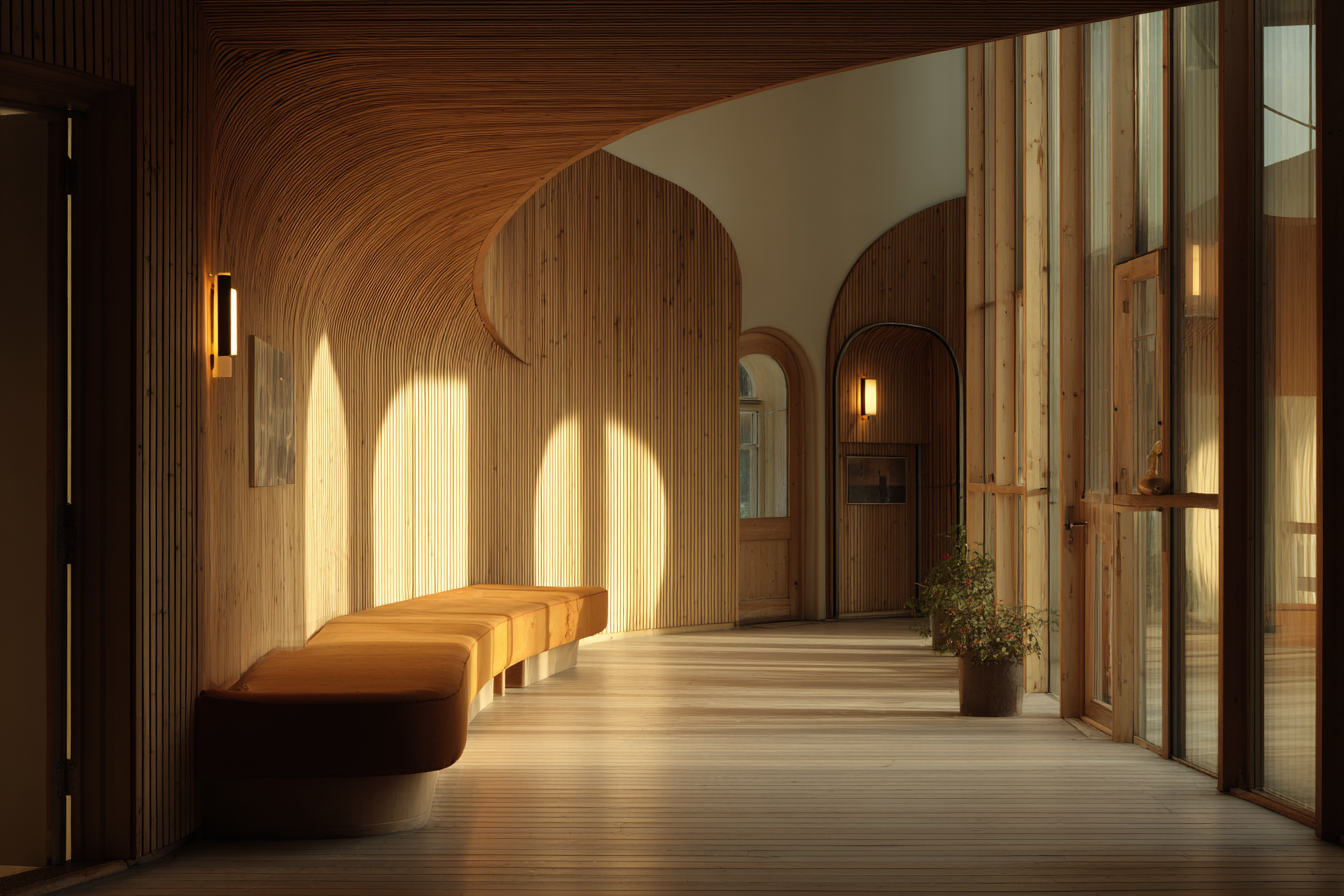
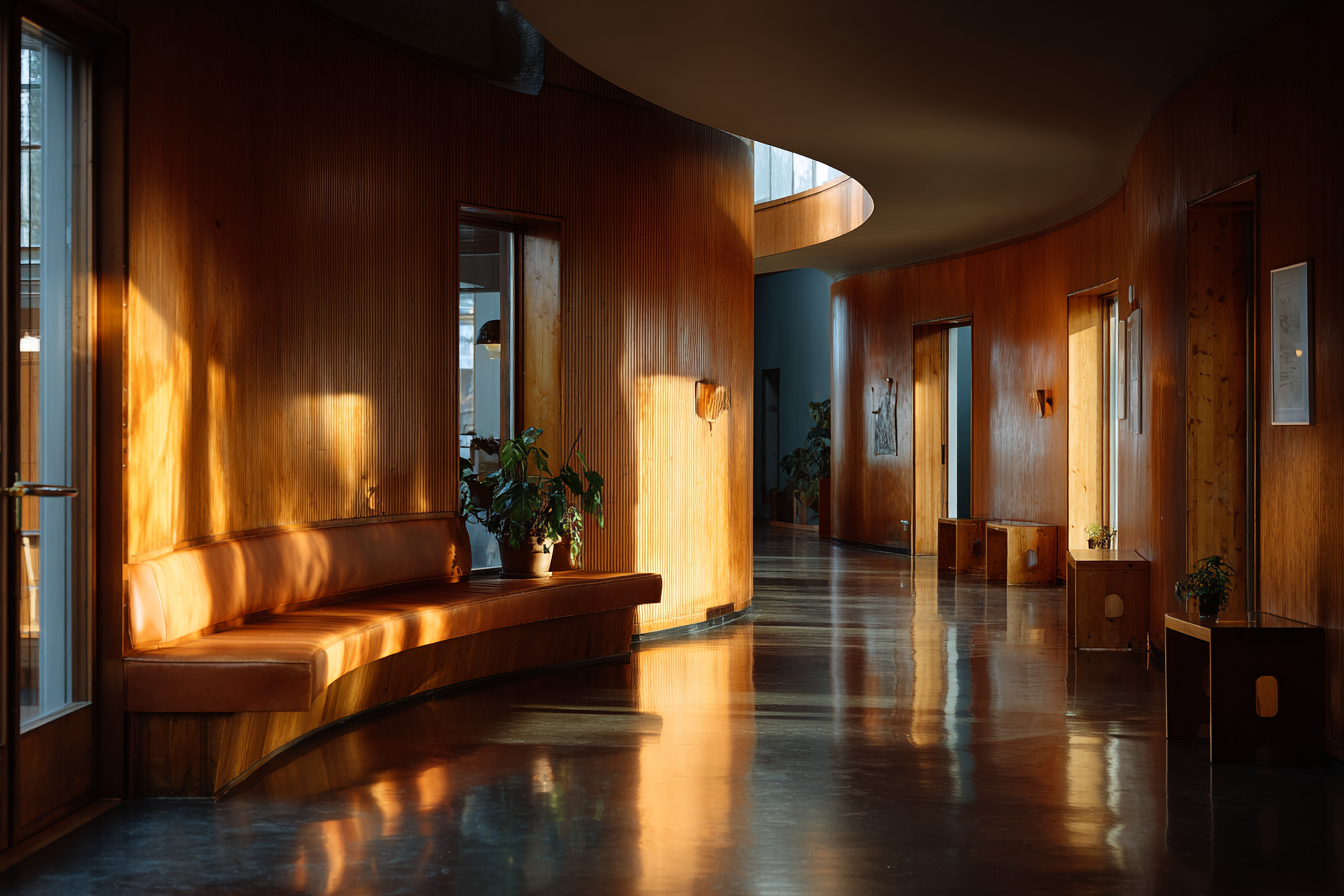
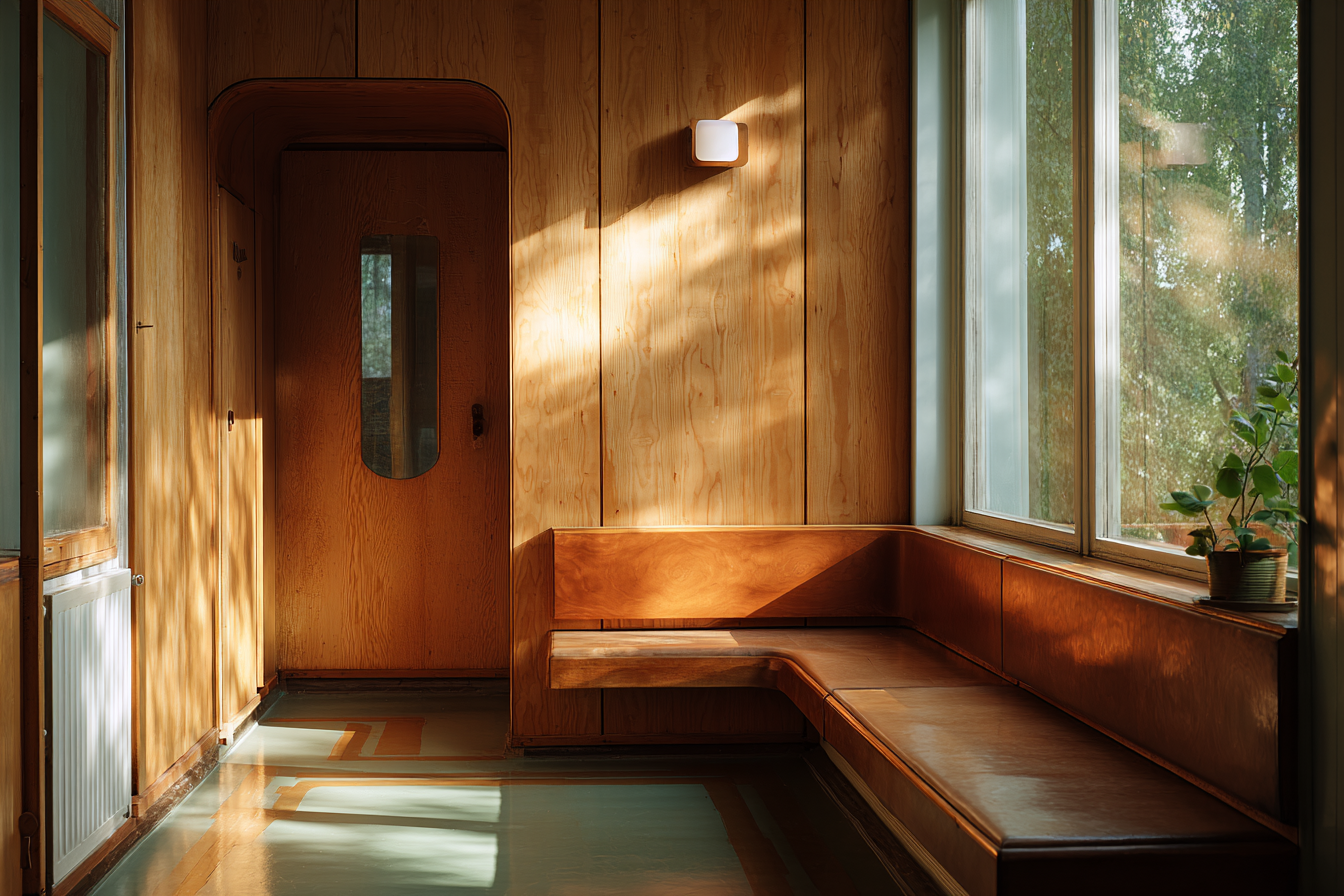
Aalto designed the Paimio Sanatorium as a place of healing rather than simple treatment. Light entered as medicine. Color spoke in whispers instead of commands. His design philosophy, as documented in Britannica: Modernism in Architecture, was grounded in humanity and restoration. He believed that spaces should care for their occupants as much as they sheltered them.
Technique for translating emotion into light
- Aperture f/4 for softness that feels alive without losing clarity
- Tripod stability to let morning light unfold slowly across the frame
- Kelvin 5200 to preserve natural birch tones and gentle daylight
- ISO 200 for clean texture that maintains warmth and breath
How to speak Aalto’s language in Midjourney
Use gentle cues such as “morning light,” “soft birch reflection,” “subtle warmth,” or “natural grain.”
Aalto’s architecture thrives on restraint. When you prompt Midjourney, write as if describing memory instead of measurement. Let the words evoke feeling before form.
Example prompt:
“Paimio Sanatorium, warm morning light across birch interior, Fujifilm GFX100 II, 45 mm lens, f/4, ISO 200, style raw, soft daylight tones.”
Midjourney responds not only with accuracy but with tenderness, echoing the rhythm of Aalto’s organic modernism, a movement built on balance, care, and human warmth.
The Fujifilm GFX100 II mirrors that philosophy. It is precise but never harsh. Its tonal range feels human. Its colors are rich yet humble. The sensor captures every shade of birch and every breath of light with compassion. It sees as Aalto saw: not structure alone, but the spirit that lives inside it.
If you want to explore how your own architectural vision could carry this same sense of human warmth and organic light, you can work with me on Fiverr. Together, we will shape images that breathe rather than perform, images that tell stories of material and light the way Aalto once did. Every project deserves to feel alive, and I would love to help you find that living rhythm within your design.
🏰 Josef Hoffmann and the Panasonic S1R, Ornament Reimagined
Josef Hoffmann lived in the space between logic and lyricism. Where Adolf Loos condemned ornament as crime, Hoffmann treated it as choreography. Every curve, every tile, every glint of brass carried intention. His geometry was never decoration for its own sake. It was rhythm and reason performing in harmony.
When I entered into Midjourney V7 the prompt “Stoclet House dining room, golden lamplight on mosaic surfaces, Panasonic S1R 50 mm f/1.8 ISO 400, style raw”, the result felt like a quiet symphony of precision and grace. The AI rendered gold against marble, mosaic against air, each line repeating like a refrain. It was less about ornament and more about order made human.
📸 Midjourney Prompt:Stoclet House dining room illuminated by golden lamplight reflecting across mosaic walls and marble surfaces, captured with Panasonic S1R 50 mm f/1.8 ISO 400. Art Nouveau and Vienna Secession inspired composition in the spirit of Josef Hoffmann, emphasizing geometric ornament, disciplined symmetry, and handcrafted detail. Warm tonal palette with soft specular highlights on brass and stone, quiet atmosphere of order and refinement rendered in photoreal clarity, balancing logic and lyricism --v 7 --style raw --stylize 220 --seed 1
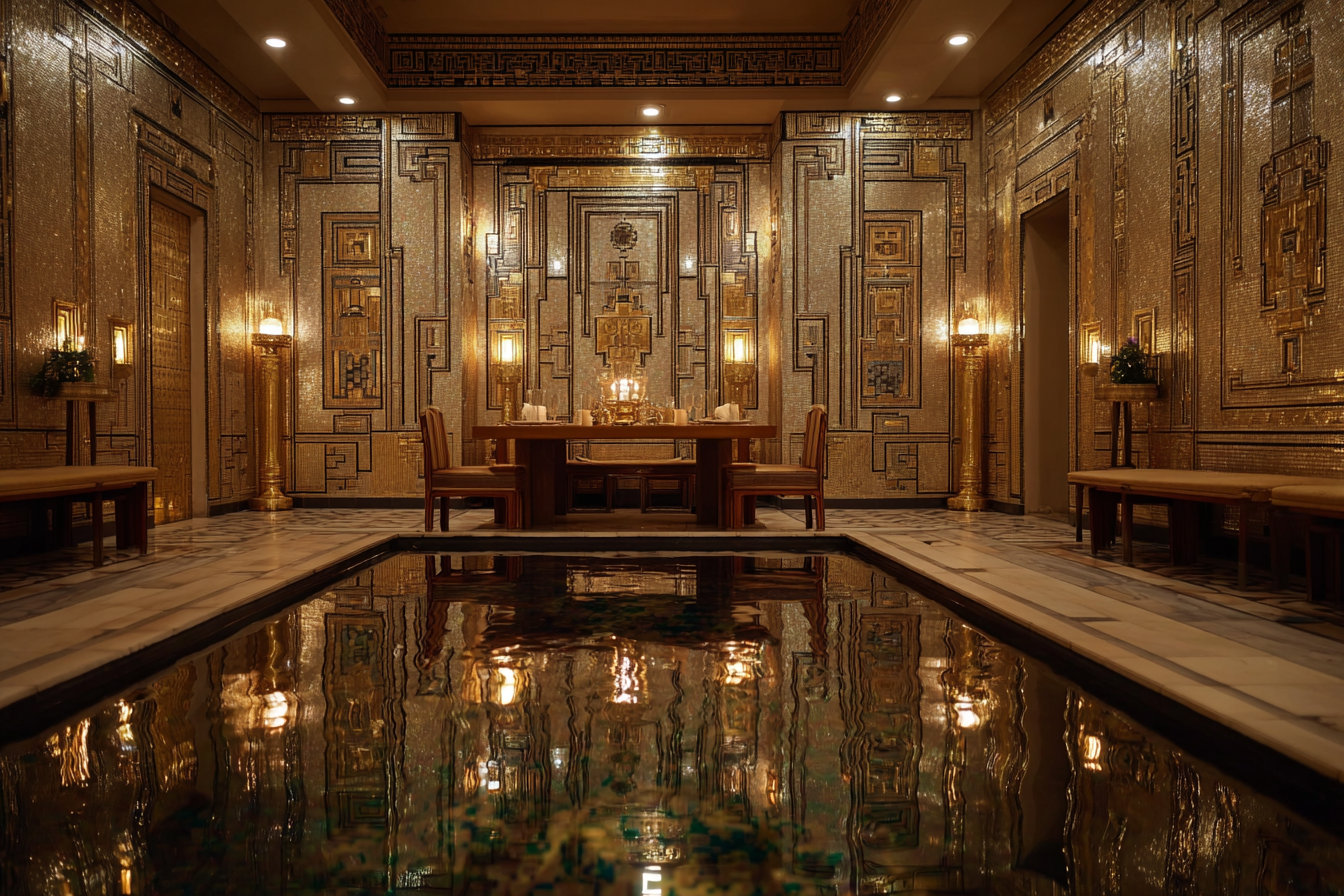
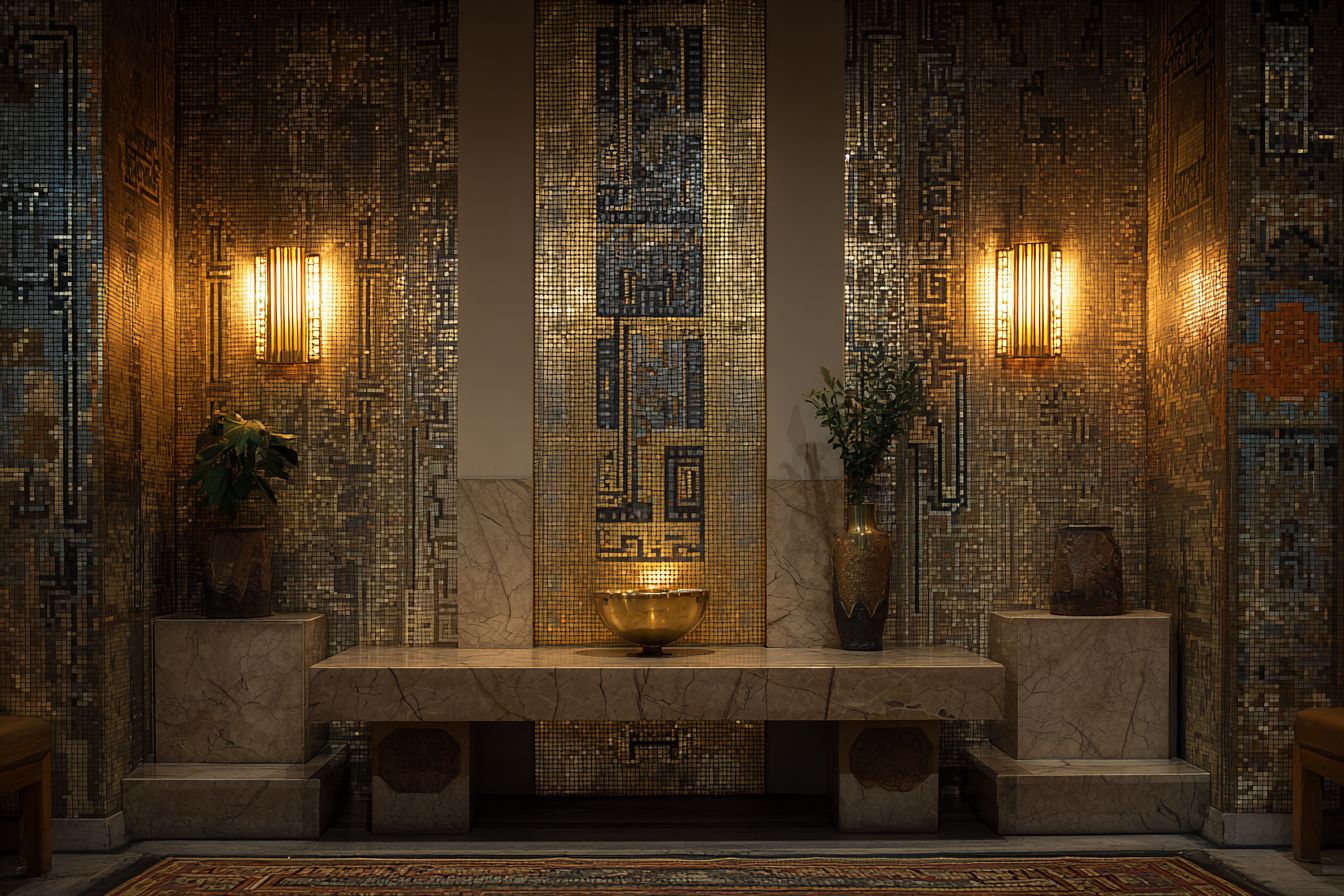
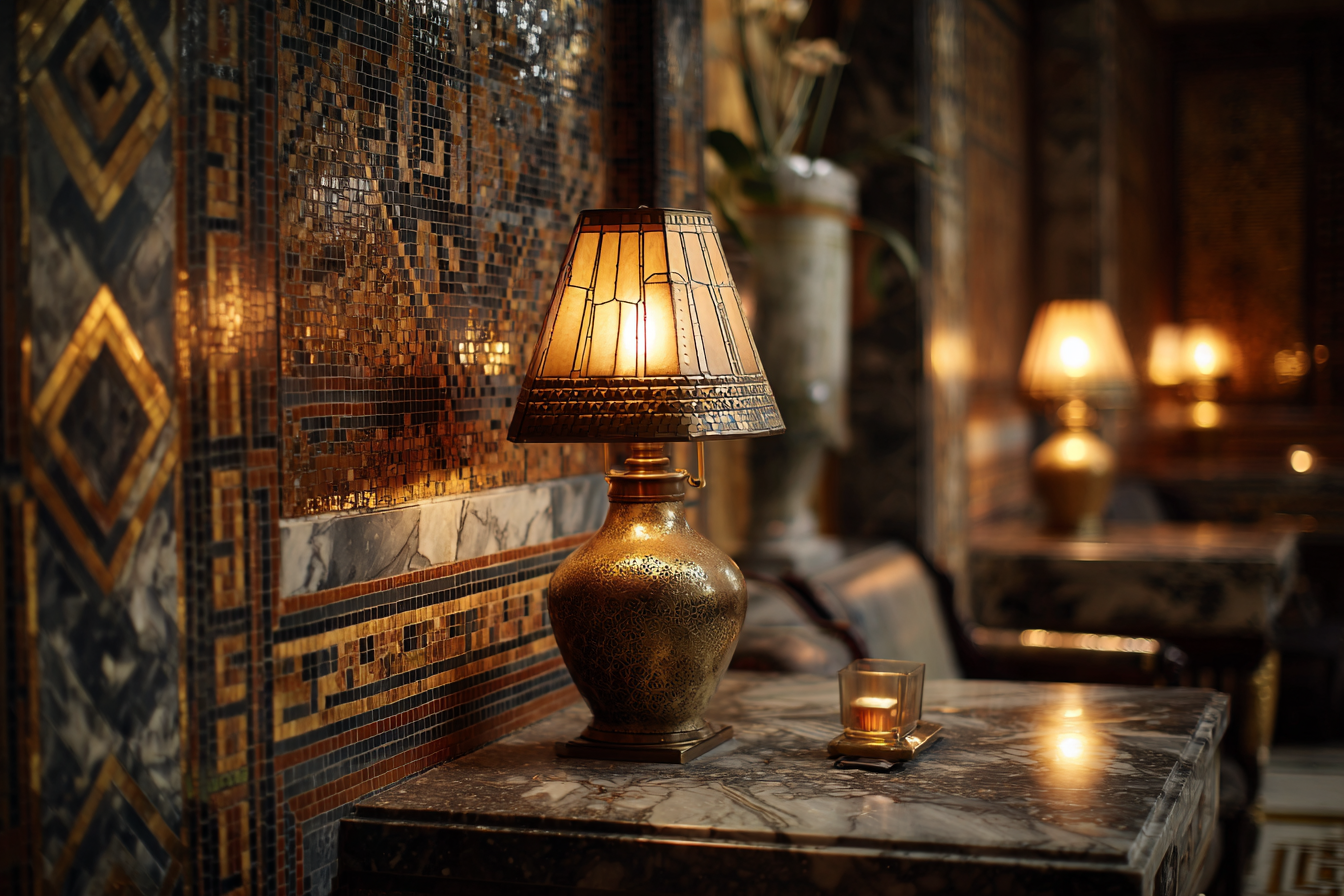
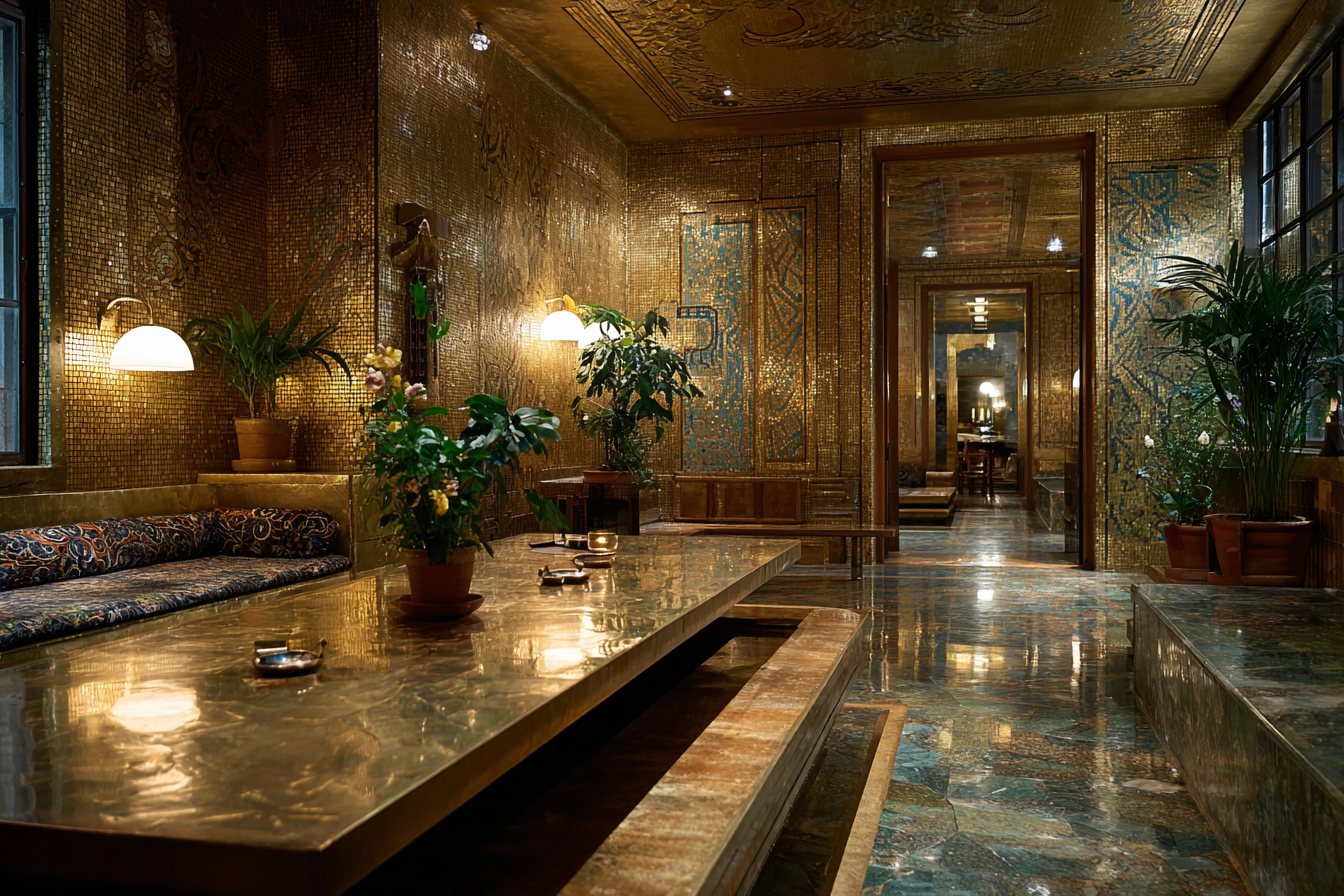
The Panasonic S1R, with its remarkable tonal range and microcontrast, interprets Hoffmann’s world as a study in patience. Each surface glows with measured warmth. Each reflection hums with restraint. The camera does not exaggerate. It listens. It translates the shimmer of craft into something that feels timeless and tactile.
Hoffmann’s patterns reflected the spirit of the Vienna Secession, where art and architecture shared a single purpose, to bring intellect and emotion into balance. His rooms did not shout with color or opulence. They whispered with proportion. Even within ornament, there was discipline that felt almost mathematical. The beauty lived not in excess but in equilibrium.
Technique for ornament that breathes
- Manual white balance 4800 K to hold warmth without glare
- Shutter 1/60 second handheld to let lamplight flicker naturally
- Aperture f/1.8 for intimacy so each mosaic tile feels alive with depth
- Slight contrast reduction to soften brass reflections and protect highlights
Speaking Hoffmann’s language in Midjourney
Use phrasing that blends structure with intimacy. Cues such as “golden lamplight,” “geometric ornament,” “soft glass reflection,” and “Viennese dining room at dusk” encourage the AI to create design rather than decoration.
Example Prompt:
“Vienna Secession interior, golden light over mosaic panels, Panasonic S1R 50 mm, f/1.8, ISO 400, soft reflections, style raw.”
The AI responds with balance rather than flourish. It understands what Hoffmann understood, that pattern is not clutter but cadence.
The Panasonic S1R becomes an ideal interpreter of his legacy. Its color depth respects nuance, its sensor finds detail in restraint, and its tones reveal beauty within order. Through its lens, Hoffmann’s rooms recover their quiet dignity and their dialogue between craft and clarity.
If you want to explore how ornament and rhythm can merge in your own creative work, you can collaborate with me on Fiverr. Together, we can shape AI-driven architectural imagery that finds harmony between pattern and purpose, between light and structure. Every project deserves to shine with intention rather than excess.
✈️ Eliel Saarinen and the Sigma fp L, Motion in Stillness
Eliel Saarinen designed architecture that seemed to lean toward the future. His buildings did not simply stand. They seemed prepared to move. The Helsinki Central Station, with its long horizontal pulls and measured symmetry, felt like a train paused in the quiet moment before departure. Even its granite surfaces carried a sense of momentum, a gentle forward tilt that suggested readiness. According to the Museum of Finnish Architecture, the station is recognized as an early study in architectural rhythm, its pylons, arches, and tower forming a mass that appears poised rather than static, a composition shaped by balance, motion, and intention.
When I entered into Midjourney V7 the prompt “Helsinki Central Station exterior, early evening snow, Sigma fp L 35 mm f/2 ISO 800, style raw”, the scene emerged like a breath held between stillness and journey. Snow drifted through thick twilight air. Light pooled softly on the granite façade, gathering where footsteps might soon pass. It felt as if the world itself were waiting.
📸 Midjourney Prompt:Helsinki Central Station exterior in early evening snowfall, captured with Sigma fp L 35 mm f/2 ISO 800, cinematic twilight atmosphere with soft snow drifting through quiet air. Granite façade illuminated by warm light pooling across steps and arches, architectural rhythm inspired by Eliel Saarinen’s early modern design, expressing balance, motion, and calm anticipation. Photoreal composition with delicate highlight roll-off, subtle shadow depth, and restrained color palette conveying stillness within movement --v 7 --style raw --stylize 200 --seed 1
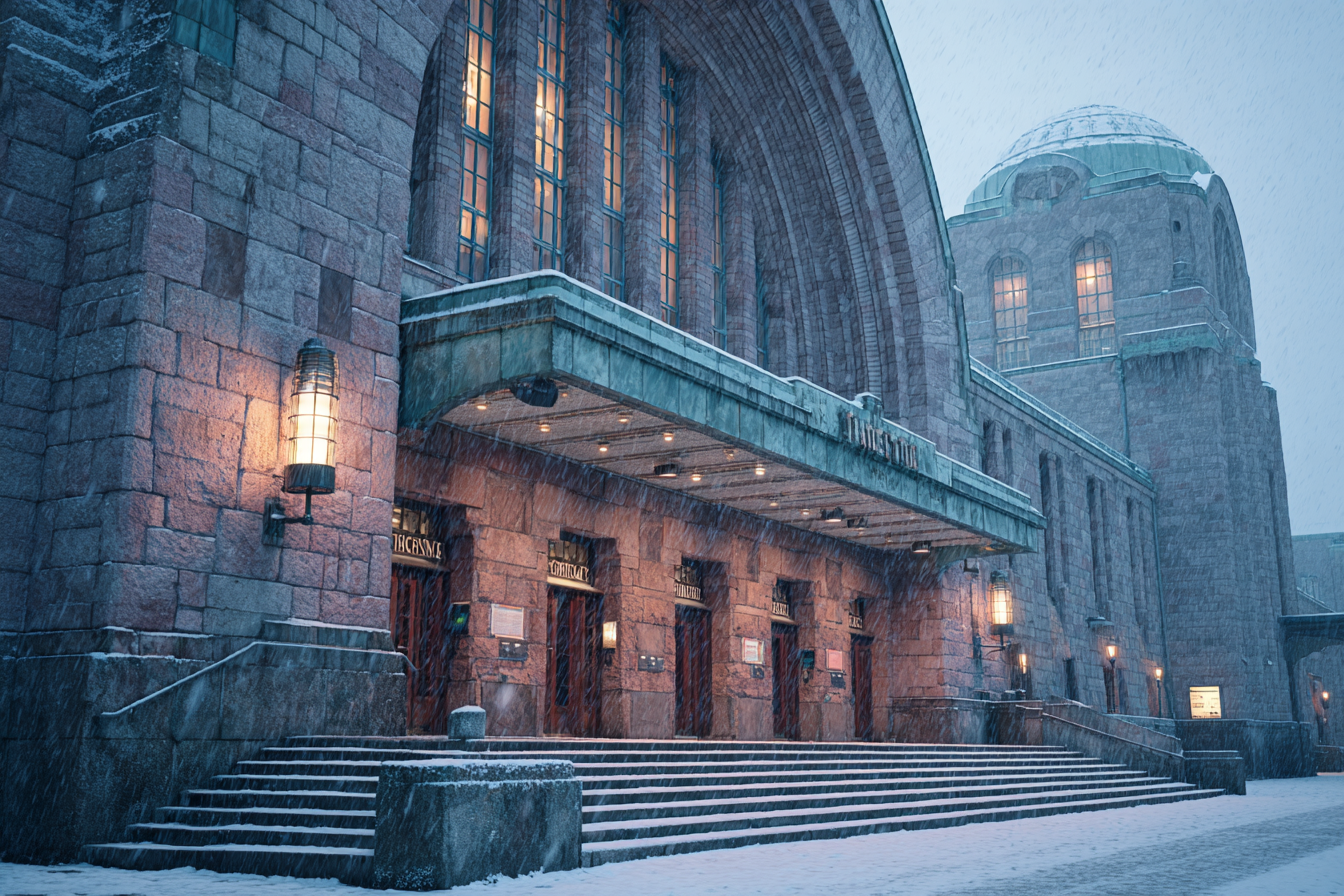
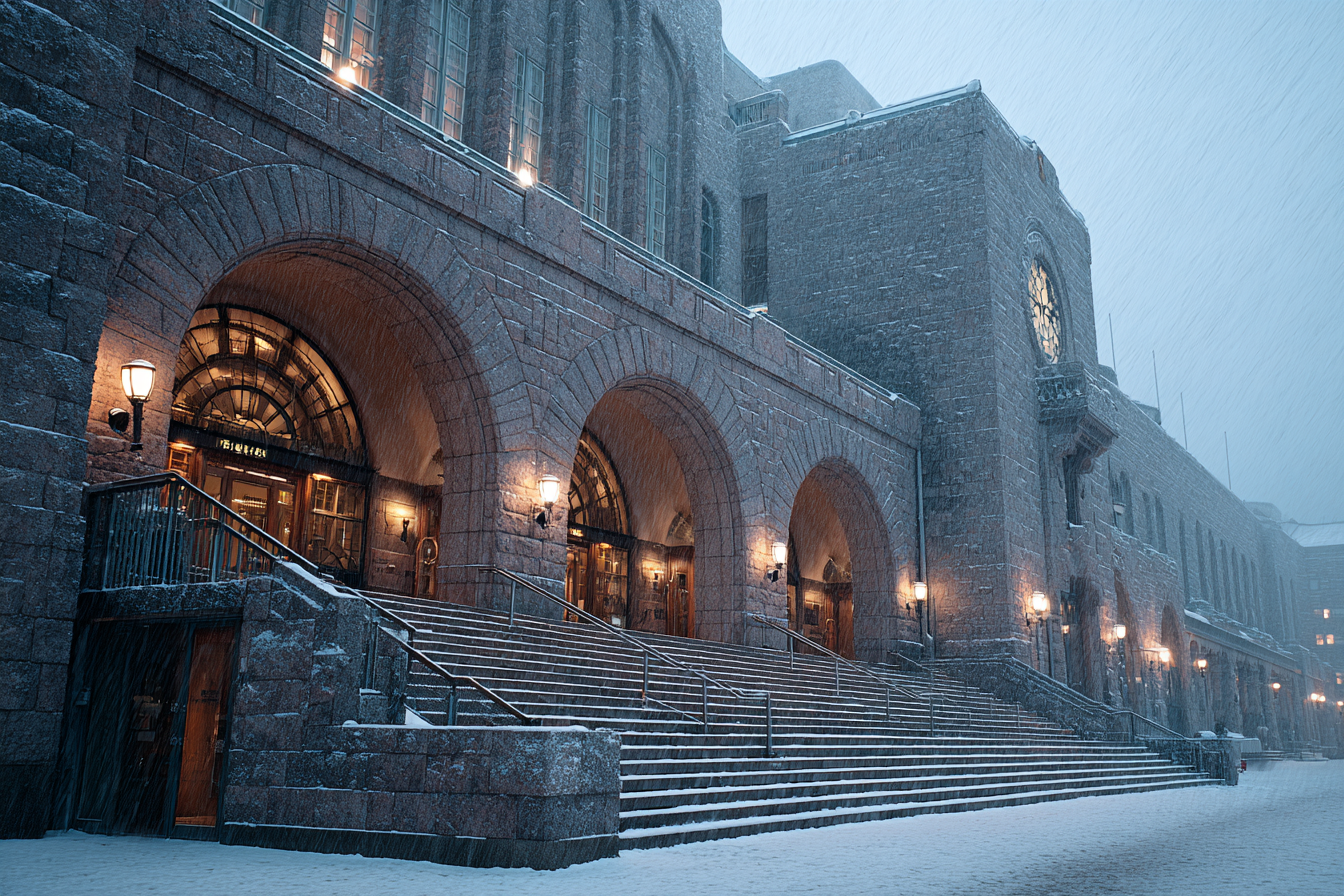
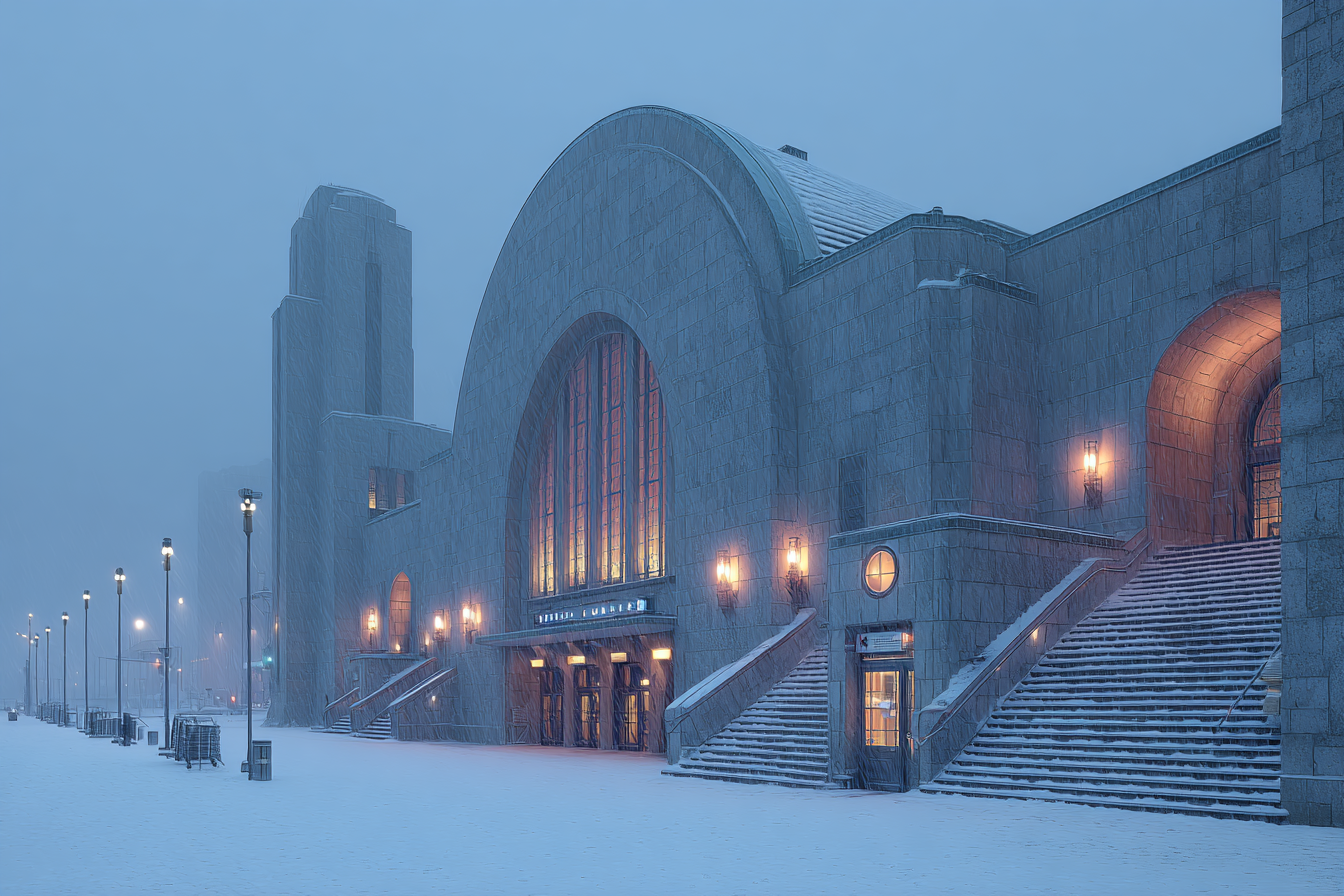
The Sigma fp L, with its cinematic color science and delicate highlight roll off, understands this tension. Its sensor captures subtle movement inside frozen time. Shadows stretch forward with intent. Snowflakes hang midair, suspended between frame and flight. The result is not simply an image of a building. It is a portrait of motion disguised as calm.
Saarinen’s genius was his ability to make architecture feel alive. His lines did not end. They paused. Even in AI reinterpretation, that rhythm remains. The fp L carries this quality with its gentle contrasts, restrained saturation, and a soft atmospheric sensitivity that turns structure into feeling.
Technique for quiet movement
- Shutter 1/250 second to freeze snowflakes while preserving atmosphere
- Aperture f/3.5 for a balance of clarity and softness
- ISO 800 to hold twilight luminance without losing texture
- White balance 5000 K to keep snowlight natural rather than blue
Midjourney guidance for Saarinen’s motion and mood
In prompts, combine precision with poetry. Saarinen’s architecture thrives in tension and anticipation, so use cues like “early evening snow”, “motion in stillness”, “architectural rhythm”, or “twilight geometry”.
Example prompt:
“Helsinki Central Station at dusk, falling snow, Sigma fp L 35 mm, f/3.5, ISO 800, cinematic mood, soft twilight reflection, style raw.”
Midjourney will read these cues the way Saarinen read movement. The building becomes part of the weather, and the weather becomes part of the story.
Saarinen’s architecture as suspended motion
Completed in 1919, the Helsinki Central Station is often cited as a study in poised dynamism. Its sculptural pylons, monumental clock tower, and repeating arch forms give the impression of mass leaning gently into time. According to the Museum of Finnish Architecture, its composition is a masterclass in controlled momentum, a structure that evokes transit even when absolutely still.
In AI reinterpretation, that same kinetic grace returns. Midjourney captures what Saarinen implied rather than what he declared. Snow drifts across granite. Light trails along the platform. Figures dissolve into soft silhouettes. The still frame does not simply record architecture. It inhales and exhales, holding motion just long enough for us to see it.
The Sigma fp L is perfectly suited to this vision. Its lightweight body and cinematic tonal character speak the same language Saarinen used, minimal yet expressive, precise yet emotional. It captures the beauty of anticipation, the quiet breath before movement, the architecture of waiting.
If you want to explore how movement, architecture, and emotion can converge through AI and cinematic design, you can work with me on Fiverr. Together, we will create AI driven architectural studies that feel like living frames, where form, light, and atmosphere hold their breath just long enough to tell a story.
🪞 Peter Behrens and the Pentax K-1 II, Industry as Cathedral
Peter Behrens was one of the first architects to show that machines could embody beauty. His AEG Turbine Factory treated turbines, girders, and steel frames not as tools of production but as structural sculpture. The factory was not simply a power plant. It was a statement that framed steel as sanctuary.
Using the Pentax K-1 II, I entered into Midjourney V7 the prompt “AEG Turbine Factory interior, morning light through steel girders, Pentax K-1 II 28 mm f/3.2 ISO 200 style raw.” What returned felt devotional. Light poured through the space. Dust drifted through golden beams. Steel and concrete glowed with reverence. Metal softened. The hall felt sacred.
📸 Midjourney Prompt:AEG Turbine Factory interior illuminated by morning light streaming through steel girders, captured with Pentax K-1 II 28 mm f/3.2 ISO 200, shafts of sunlight cutting through warm industrial air, dust particles glowing in golden atmosphere. Early modernist composition inspired by Peter Behrens, emphasizing structure as sacred form, balance of engineering precision and poetic calm. Photoreal rendering with deep shadow gradients, tactile metal textures, and cinematic reverence for industrial space --v 7 --style raw --stylize 180 --seed 1
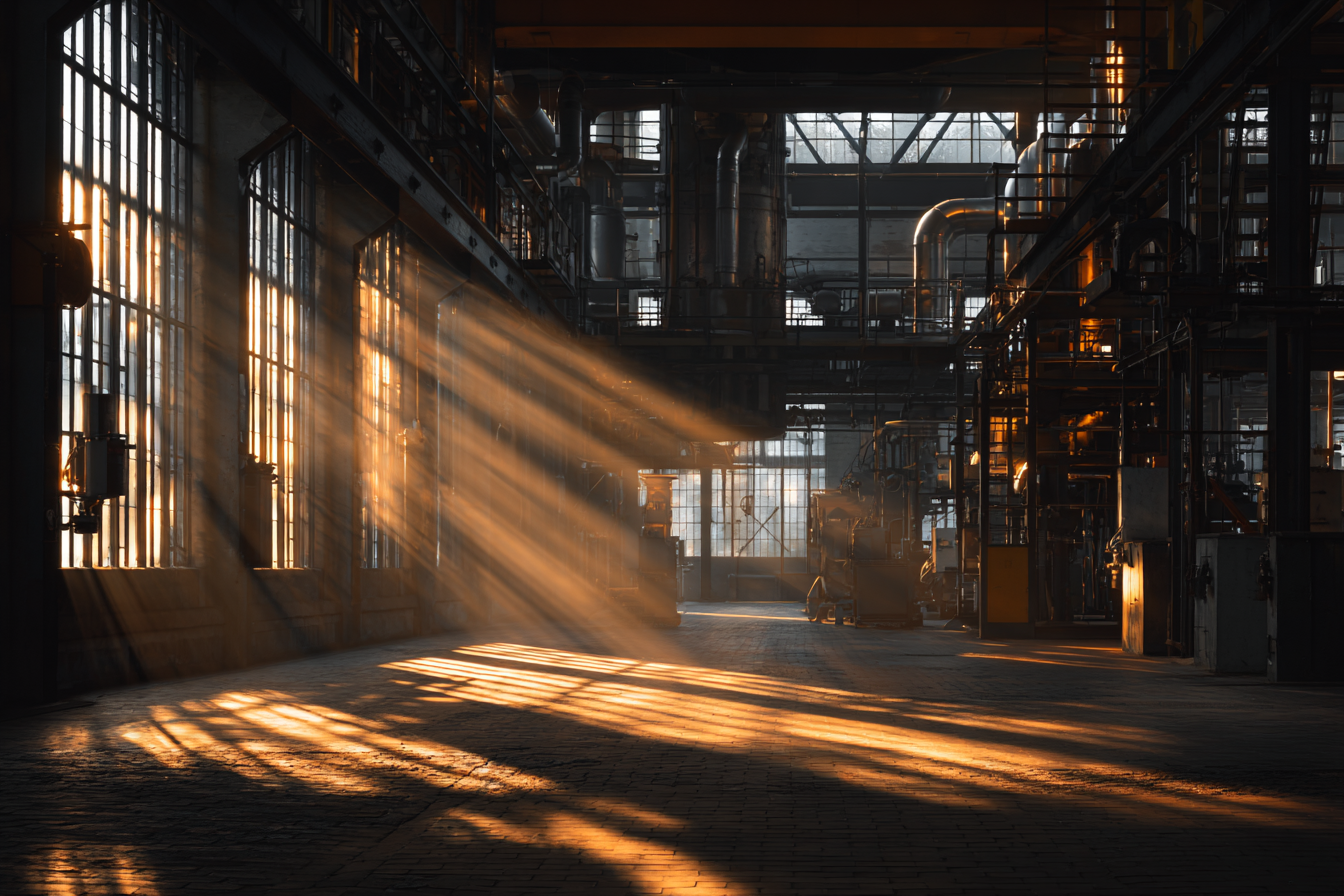
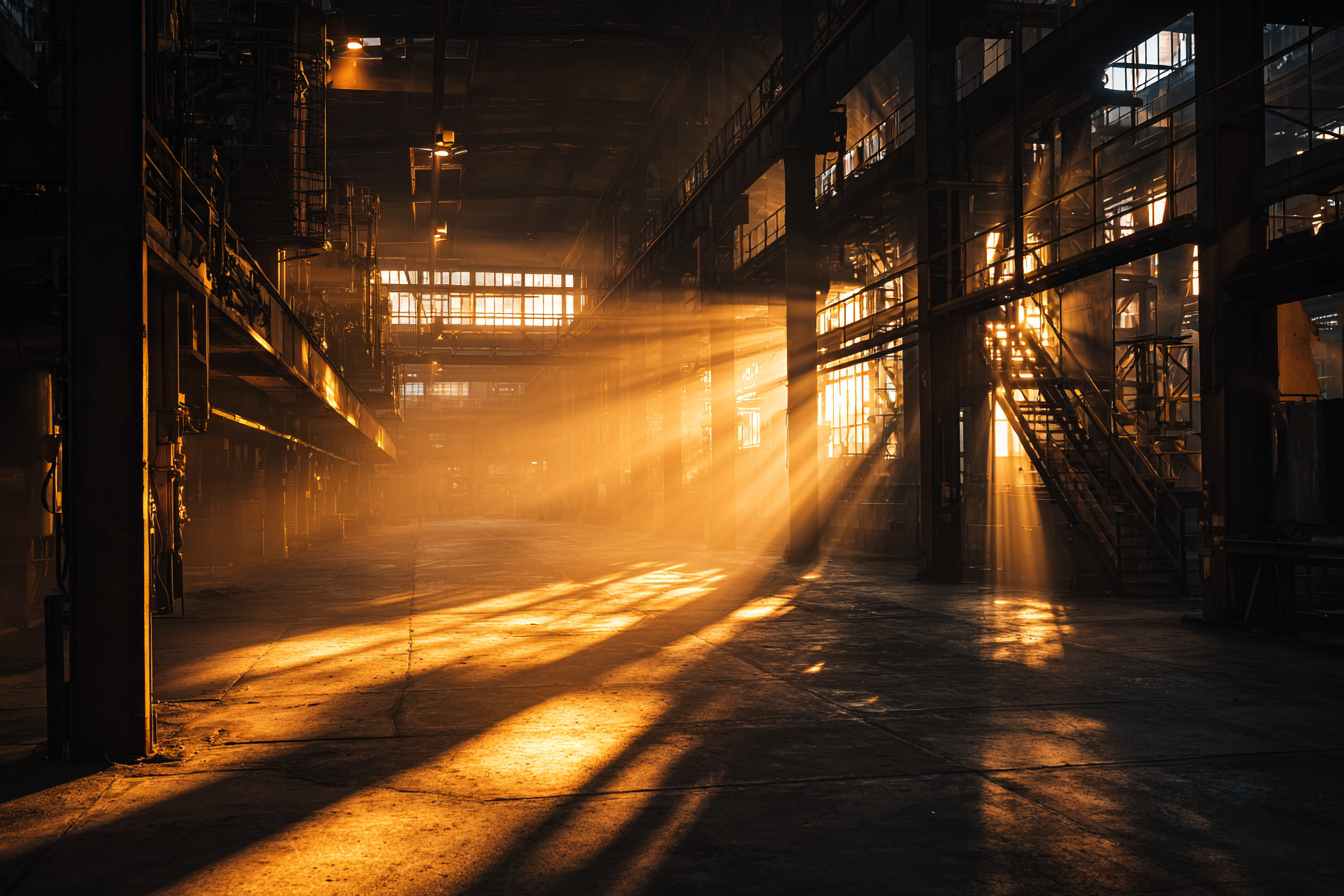
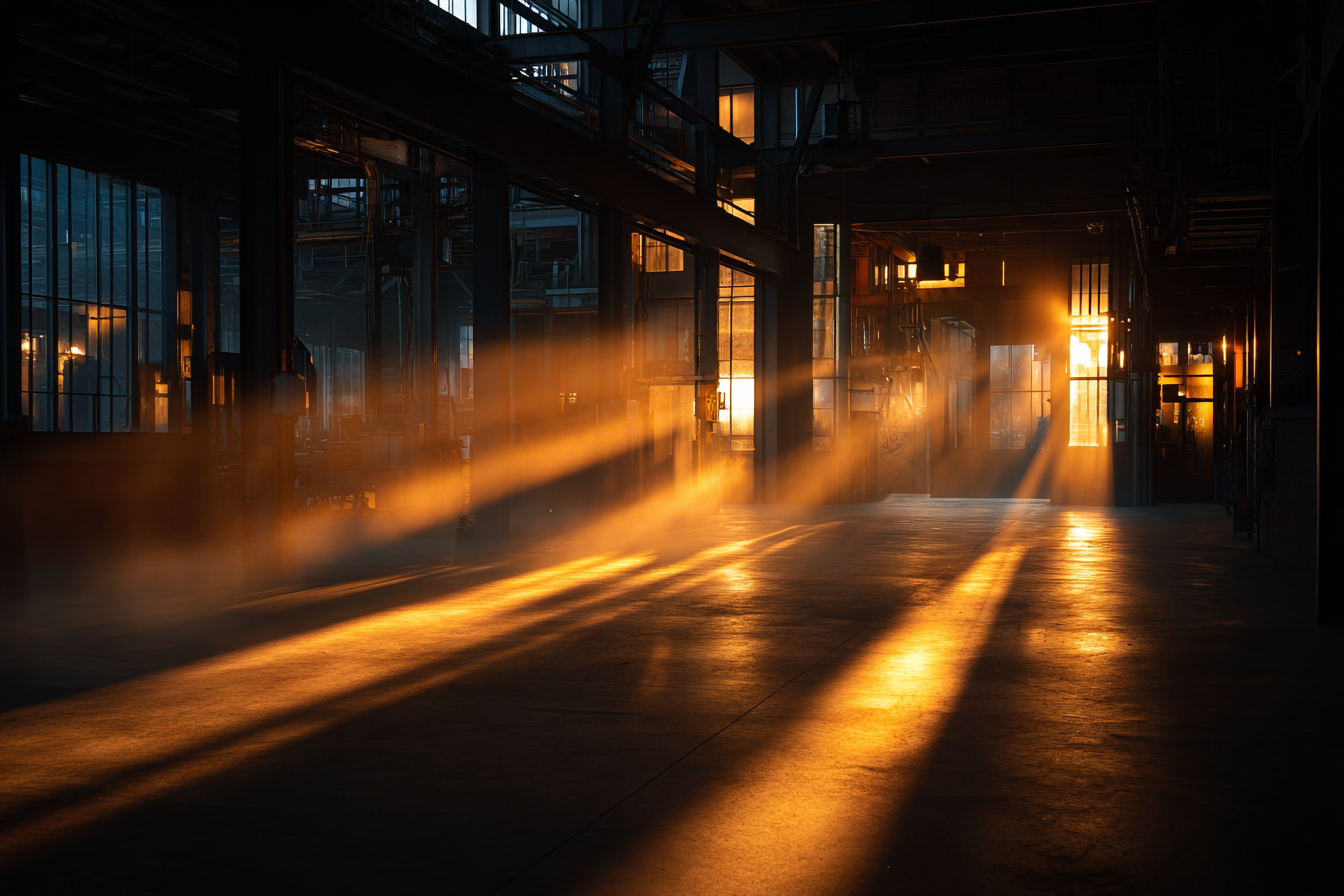
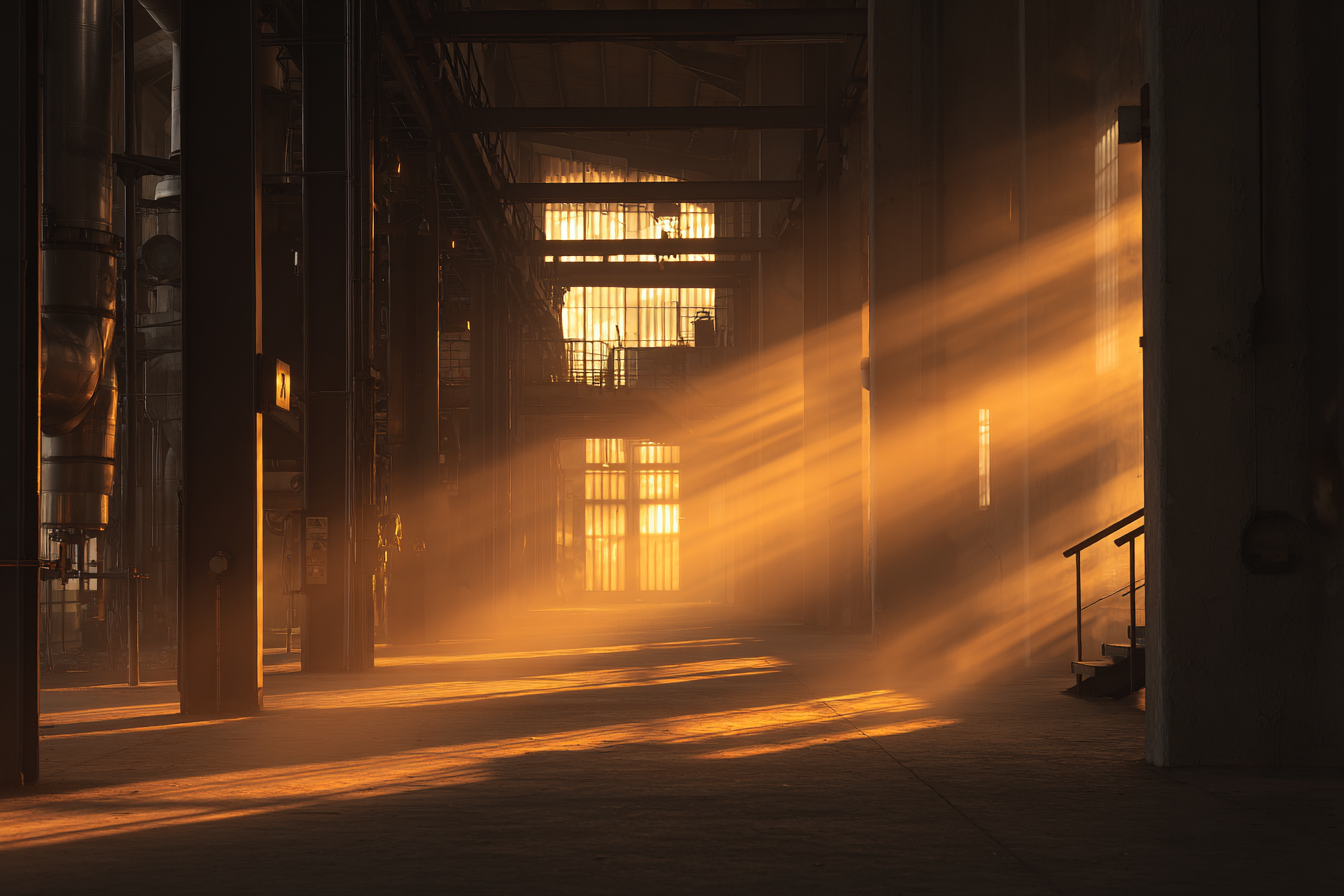
Midjourney translated that reverence into form. It painted shafts of sunlight cutting across girders like rays through stained glass. Concrete, glass, and steel seemed to hold their own presence. Rivets, joints, and structural seams appeared as if carefully chosen. The interplay of beams and shadow gave the interior a sense of dignity and weight. The building felt alive.
The AEG Turbine Factory, completed in 1909, is recognized by historians and institutions such as visitBerlin as one of the earliest examples of modern industrial architecture. Its design aligned function with aesthetic restraint and structural honesty, proving that engineering could also be expressive.
Technique for industrial grace
- Aperture f/8 to keep every seam, rivet, and girder sharp
- ISO 200 for highlight purity and realistic metal texture
- Manual focus to align structural geometry
- Low, wide framing to emphasize vertical rhythm and give light the gravity it deserves
Prompt guidance for Midjourney
Speak of presence rather than polish. Use phrasing such as “morning light,” “steel rhythm,” “light shafts,” “industrial calm,” or “echoing expanse.” These cues help Midjourney express not only form but also atmosphere, the quiet dignity within structure.
Example prompt:
“AEG Turbine Factory interior, steel girders, light shafts, concrete floor, Pentax K-1 II 28 mm, f/8, ISO 200, soft natural light, style raw.”
Midjourney will respond with weight that feels earned and with reverence that feels human.
Why the Pentax K-1 II suits Behrens’s vision
The Pentax K-1 II is a camera built for truth. Its sensor captures subtle gradations in steel, delicate transitions in shadow, and the reflective shimmer of glass. It does not seek gloss. It seeks honesty. Through tonal depth and restraint, it hears what Behrens intended, which is clarity without excess and precision without coldness.
Through this quiet collaboration between camera, algorithm, architecture, and human intention, the AEG Turbine Factory becomes sacred again. Light becomes a silent sermon, and steel becomes scripture.
If you want to bring your own sense of space and light into Midjourney’s world, you can work with me on Fiverr. Together, we will create AI driven visual studies inspired by modernism, images that feel lived in, rich with story and light, and guided by purpose rather than ornament. Each project will be crafted to feel alive.
🏠 Rudolf Schindler and the OM System OM-1, Intimacy in Concrete
Rudolf Schindler saw the home not as a monument but as an experiment, a place meant to live, breathe, and adapt. His Kings Road House, often described as the first truly modernist house in California, felt more like a workshop for living than a conventional residence. It was open, flexible, and deeply human. The project redefined how architecture could express the flow of daily life rather than simply contain it, a philosophy preserved today by the MAK Center for Art and Architecture.
With the OM System OM-1, that same intimacy seems to return. I entered into Midjourney V7 the prompt “Kings Road House courtyard, late afternoon, OM-1 17 mm f/1.8 ISO 160 style raw”. The AI responded with a vision of stillness. Shadows folded like linen. Walls glowed with warmth. Concrete edges softened under the low sun. The OM-1, with its compact body and responsive sensor, pulls the viewer closer. The frame feels human. The view feels honest.
📸 Midjourney Prompt:Kings Road House courtyard in late afternoon light, captured with OM System OM-1 and 17 mm lens at f/1.8 ISO 160, soft sun filtering across concrete walls and wood panels, warm shadows folding gently over textured surfaces. Modernist residential composition inspired by Rudolf Schindler, expressing intimacy, openness, and human scale. Photoreal rendering with quiet spatial rhythm, tactile materials, and cinematic natural calm --v 7 --style raw --stylize 170 --seed 1
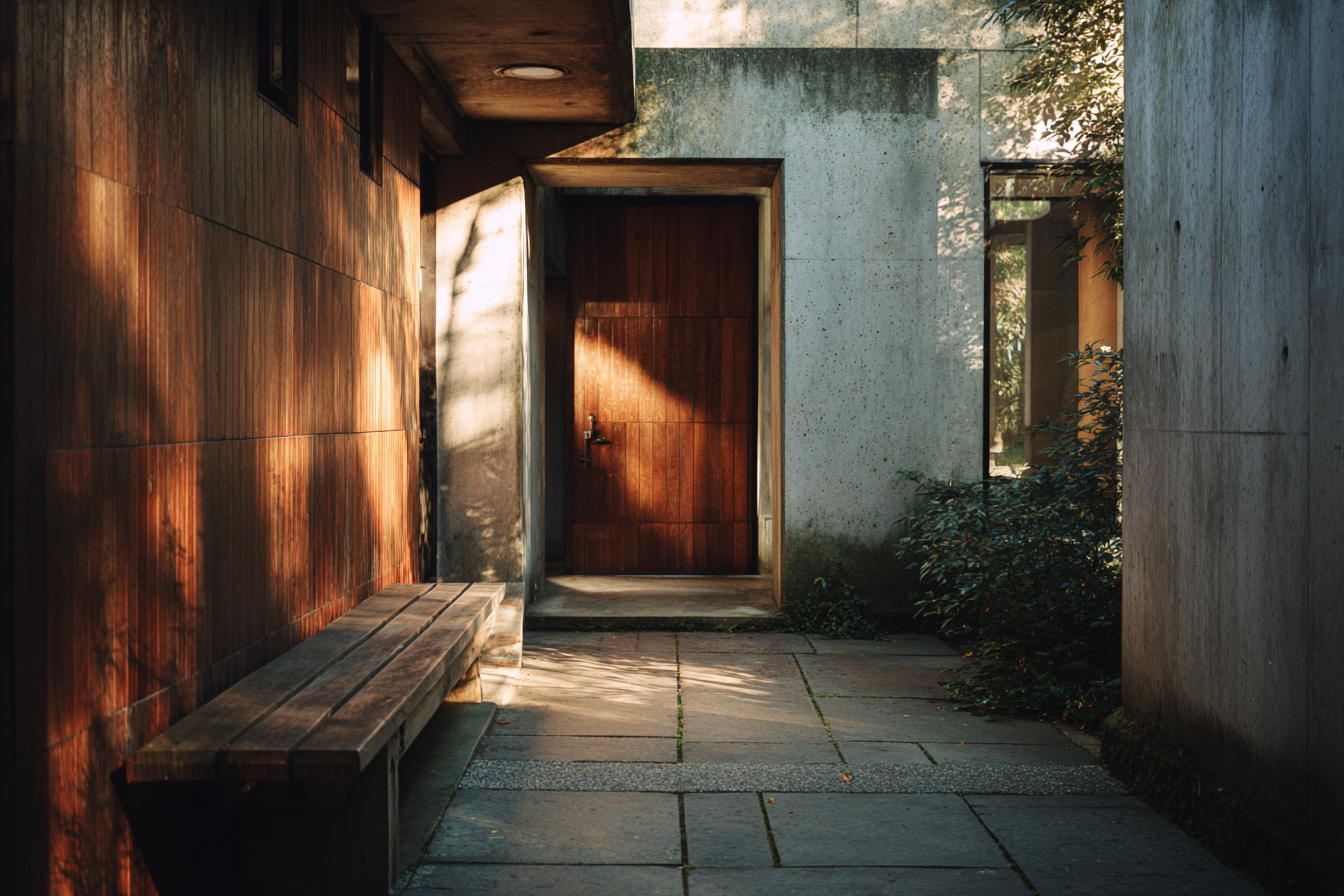
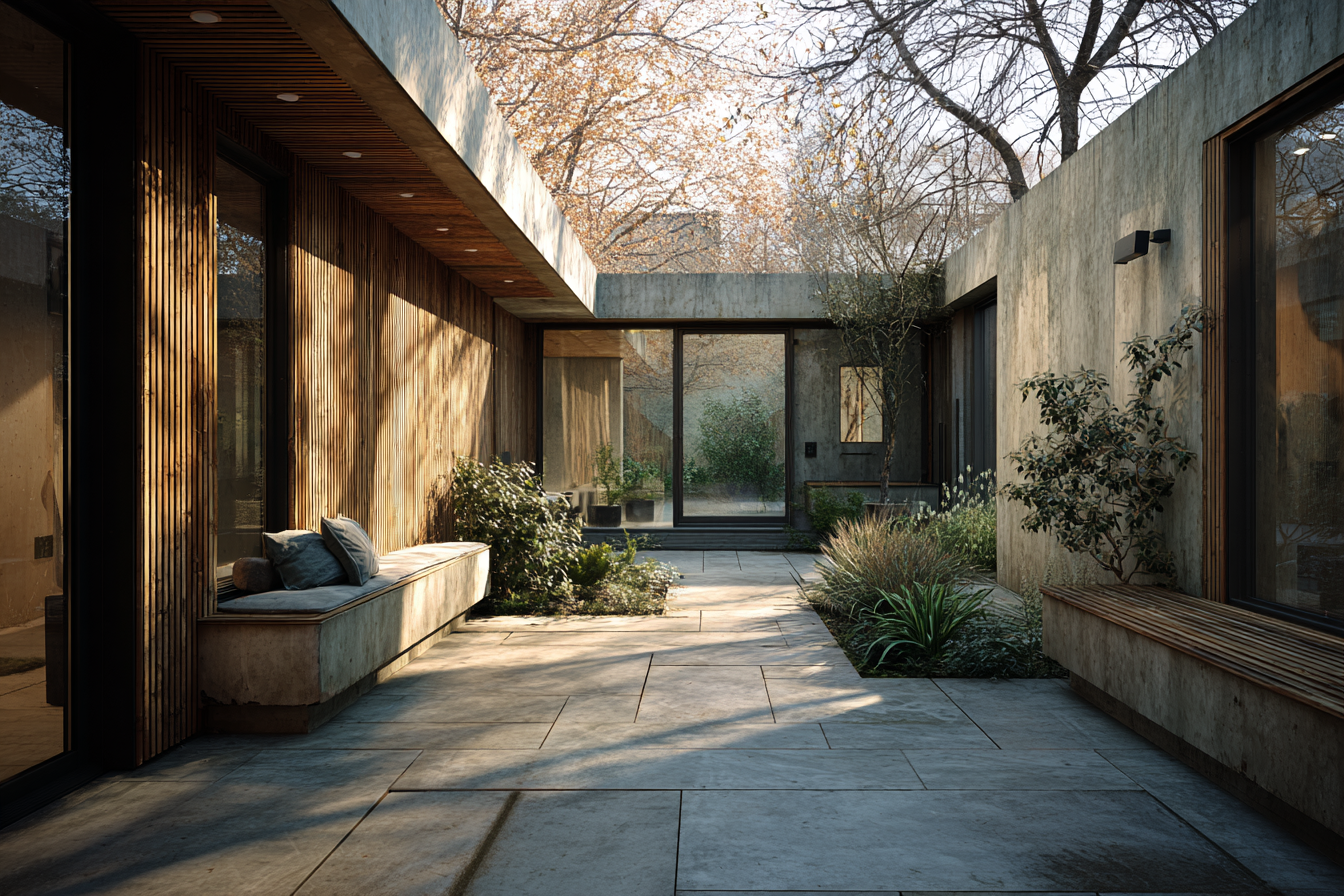
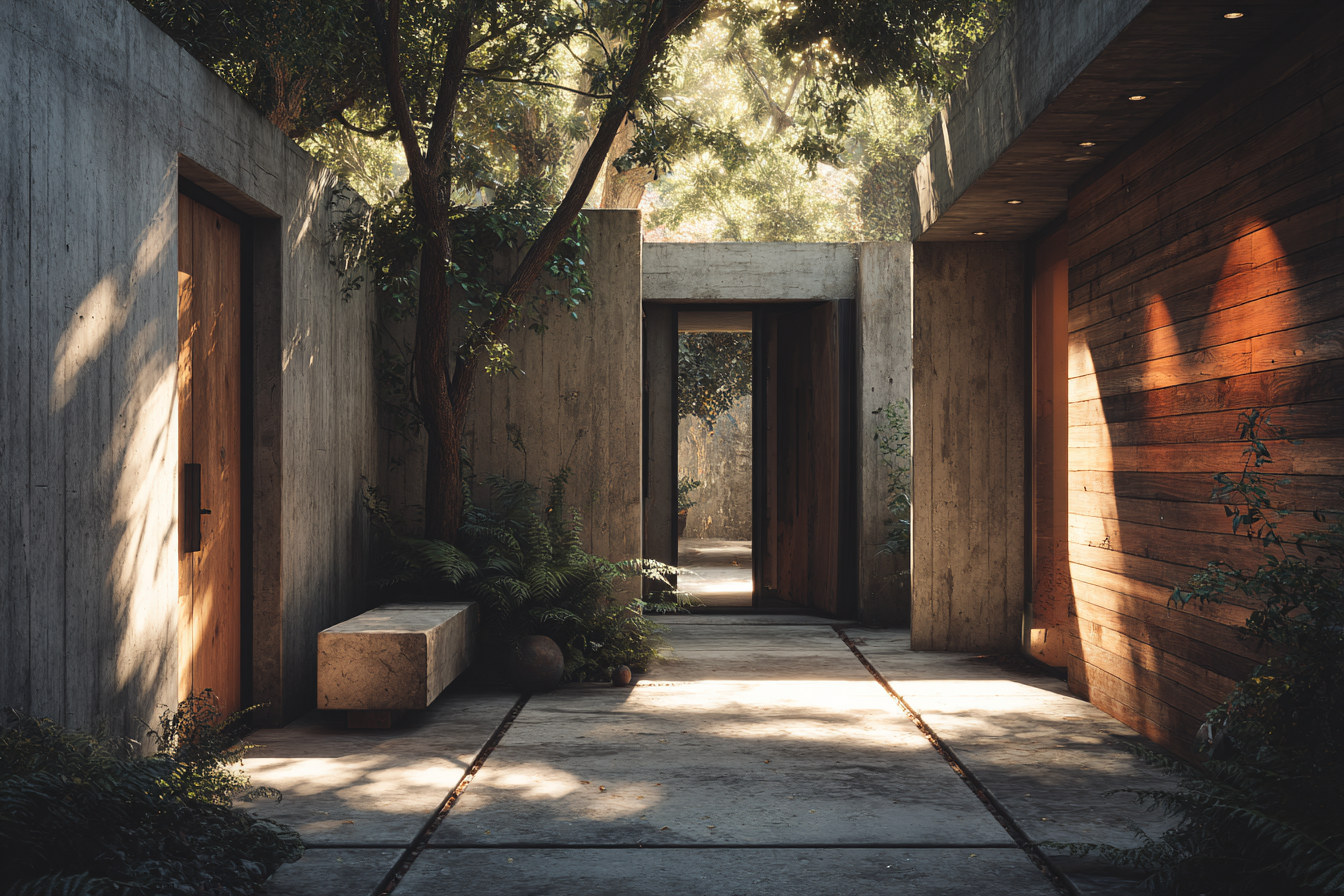
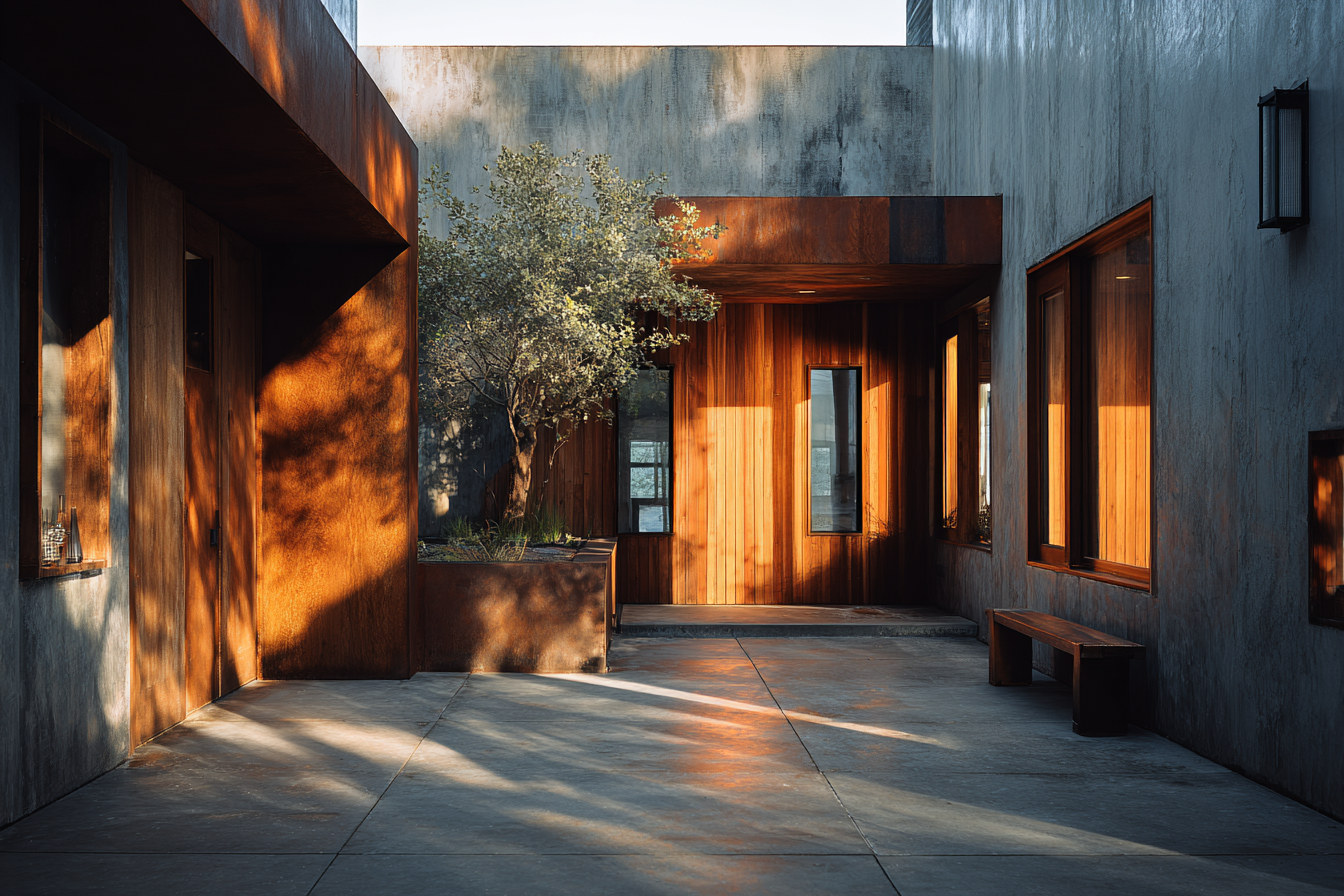
Schindler rejected rigidity and decoration. He designed with fluid boundaries, using poured concrete walls, sliding wood and canvas panels, and open studio spaces that dissolved the line between indoors and outdoors. His ideas, recorded in Wikipedia, were revolutionary yet humble. A home, he believed, should be a framework for life, not a monument.
Technique for quiet domestic feeling
- Aperture f/2 for gentle depth and tactile concrete
- ISO 160 to preserve subtle tonal detail and natural warmth
- Shutter 1/100 second handheld for slight organic motion
- Natural late afternoon light for soft edges and emotional clarity
Prompt guidance for Midjourney
Use language that invites calm. Schindler’s work thrives in atmosphere, not spectacle. Cues such as “late afternoon light,” “warm concrete walls,” “sliding wood panels,” “quiet courtyard,” and “soft shadow play” guide Midjourney to interpret intimacy instead of precision.
Example prompt:
“Kings Road House courtyard, warm late afternoon light, concrete walls, sliding wood panels, 17 mm lens, OM System OM-1, ISO 160, f/2, soft natural light, style raw.”
Midjourney reads this as an invitation to pause. The result feels lived in and timeless, a visual meditation rather than a photograph.
Why the OM System OM-1 resonates with Schindler’s vision
The OM-1 is small, agile, and unpretentious. It does not dramatize light. It listens to it. Its sensor captures texture with humility and tone with honesty. It sees the way Schindler built, with restraint, human warmth, and affection for authentic material.
If you want to explore how light, material, and memory can meet through the language of AI, you can work with me on Fiverr. Together, we will shape Midjourney prompts that transform architecture into quiet storytelling, creating images that feel lived in, intimate, and alive. Every project deserves its own warmth, and I would love to help you find yours.
🎨 The Light That Connects Them
Across all these lenses, from Sony to Canon, Nikon to Leica, Hasselblad, Fujifilm, Panasonic, Sigma, Pentax, and OM System, one truth remains constant: light carries intention. It is the element that binds the philosophy of every architect and the sensitivity of every camera.
In Midjourney V7, this light becomes more than illumination. It becomes conversation. The AI interprets our words as a form of visual empathy, an attempt to see through the eyes of those who once designed space as language. It does not imitate the past through nostalgia. It listens.
When we prompt carefully, when our phrasing carries both clarity and emotion, Midjourney responds not with calculation but with feeling. A building becomes an atmosphere, a shadow becomes thought, and each frame becomes a quiet meditation on how form and function meet under light.
This synthesis of architecture and technology reveals something timeless. Every architect, whether Wright, Le Corbusier, Aalto, or Schindler, pursued a truth that was not purely visual. They sought light as meaning. Now, through the lens of AI, that same light continues to shape stories. It becomes the bridge that carries a century of vision forward.
Light, in this context, is not only physical. It is conceptual. It is the link between vision and realization, between structure and soul. Through Midjourney’s eyes, we are reminded that every composition, whether drawn, built, or rendered, begins with a simple act of illumination.
🌅 Beyond the Frame
To move beyond the frame is to step from image into idea. Architecture has always been more than geometry. It is the choreography of emotion, proportion, and memory. Through Midjourney, that choreography becomes visible again, not as simulation but as interpretation.
When you collaborate with AI, you are not just producing a render. You are translating imagination into light. You are teaching the machine how to feel structure, how to understand balance, and how to echo the human touch through lines of code. The act becomes dialogue. The result becomes story.
If you are ready to see your own architectural imagination expressed through this lens, you can connect with me on Fiverr. Together, we can build AI visual stories that merge design intent with photographic precision. Each prompt becomes a brushstroke. Each image becomes a reflection of your creative voice.
Every space begins as an idea, a fragment of light, a contour of thought, a spark waiting to be shaped. What Midjourney offers is not replacement but revelation. It lets us see how vision grows, how structure speaks, and how imagination takes form.
Every idea deserves the light that reveals it. Let us shape yours together with intention, empathy, and artistry.
🕯️ Modernism Reimagined: Light, Form, and Memory through Midjourney V7
By the time the 1920s arrived, the language of modernism had matured into clarity. The world was rebuilding from loss, and architecture became one of its most poetic answers. Factories pulsed with rhythm. Cities shimmered with electric light that turned glass into sculpture and shadow into texture. What began as rebellion against ornament evolved into a search for humanity within simplicity.
The great architects of this period did not turn away from emotion. They reshaped it. Their buildings carried quiet warmth beneath precision. Form spoke with calm conviction. Function found its voice in beauty. Light revealed the soul of material. The spirit of the age was not about austerity but about honesty, a refinement of purpose that found warmth in clarity.
Through Midjourney V7, these philosophies breathe again. The AI does not copy their vision. It translates it. Each image feels like a dialogue across time, where human intuition meets digital understanding. When guided with care, the model listens. It responds with textures that seem to breathe, with reflections that hold memory, with geometry that feels intentional and alive.
In these reinterpretations, we rediscover not only how modernism looked but how it felt. It was hopeful, balanced, and filled with the belief that design could serve both utility and soul. The flat planes, open glass walls, and measured shadows return as lessons in restraint and rhythm, each one a quiet act of feeling rendered through precision.
Midjourney becomes more than a rendering tool. It becomes a bridge between craft and concept, allowing modernism to live again as memory made visible. It lets us step into the creative rhythm of that era and sense how its ideas of space, light, and truth still shape design today.
Modernism, seen through this new lens, is not confined to history. It continues as a conversation between craft and code, between the architects who built and the artists who now dream in pixels. It reminds us that light has never stopped shaping thought. It has simply found another language to speak.
🌤️ Le Corbusier and the Canon R5, Light as Blueprint
When Le Corbusier described a house as “a machine for living,” he was not speaking of cold precision. He was speaking of clarity, of architecture as pure function shaped by light. His vision was never mechanical in spirit but deeply human in its precision. It was about how space could think, how proportion could breathe, and how form could carry meaning without ornament.
With the Canon R5, that philosophy finds its echo in the present. I entered into Midjourney V7 the prompt “Villa Savoye at dawn, Canon R5 RF 24–70 mm f/2.8 ISO 200, soft fog, style raw.” The image that appeared felt suspended between geometry and atmosphere. The Villa Savoye emerged not as a relic of the past but as something newly born from the morning haze. Its white façade caught the first light like a thought taking form. The fog softened its straight lines, turning them into rhythm instead of rigidity.
The Canon R5, with its high-resolution sensor and tonal accuracy, captured Corbusier’s belief in proportion as language. Each plane was measured, every shadow deliberate. The walls carried quiet equilibrium, neither heavy nor weightless. It was as if the camera itself understood restraint. Midjourney translated that restraint into emotion, showing that less is not emptiness but concentration.
Le Corbusier’s architecture was never about austerity. It was about the discipline of grace, the balance between mathematics and light. The horizontal window became his brushstroke, pulling daylight across the length of a room. The pilotis lifted mass into air, giving structure the humility to float. Even the curve of the ramp within the Savoye feels like thought set into motion, a geometry of movement rather than stasis.
Technique for light as proportion
- Set aperture to f/2.8 to soften edges and let the building breathe within its space.
- Use aperture priority mode for balanced exposure across glass and concrete.
- Employ spot metering on reflective surfaces to protect tonal accuracy and prevent glare.
- Keep ISO 200 for clean highlights that preserve calm tonal range.
- If possible, shoot during early fog or soft dawn light. Corbusier’s clarity always begins with gentle light.
Prompt guidance for Midjourney
Use phrasing that reflects stillness and balance. Words such as “diffused dawn fog,” “horizontal light,” “quiet façade,” “architectural proportion,” and “neutral daylight” guide the AI to interpret restraint as beauty. The goal is not to dramatize but to reveal.
Example prompt:
“Villa Savoye at dawn, soft fog, Canon R5 24–70 mm f/2.8, ISO 200, balanced tone, architectural proportion, style raw.”
Midjourney reads this language as a blueprint for tone and emotion. It builds an image that feels designed by light rather than by instruction.
Why the Canon R5 embodies Corbusier’s vision
The Canon R5 is a camera of balance. It records geometry with sharp precision yet allows light to remain soft and forgiving. It understands the subtle gradation that lives between shadow and reflection, where emotion resides. Its ability to translate order into warmth makes it a perfect partner for Corbusier’s disciplined beauty.
Through Midjourney, his ideas find new dimension. The AI interprets his modernist language not as formula but as feeling. In the meeting of words, light, and proportion, we rediscover the same quiet confidence that defined his architecture, the belief that clarity is compassion and light is design made human.
If you have an architectural vision you would like to see expressed in this same balance of calm and clarity, you can collaborate with me on Fiverr. Together, we can craft AI-driven visual studies that capture your ideas through the same measured grace, where light becomes structure and every frame feels as timeless as Corbusier’s thought.
🧭 Walter Gropius and the Leica SL2, The Discipline of People
At Dessau, Walter Gropius reshaped the meaning of design. He believed that architecture was not a solitary pursuit but a shared act of creation. Within the Bauhaus workshops, he invited students, artisans, and thinkers to collaborate, treating design as dialogue and material as melody. The goal was never perfection but harmony, a rhythm between hand, light, and form.
When I entered into Midjourney V7 the prompt “Bauhaus Dessau workshop, Leica SL2 Summicron 35 mm f/2 ISO 400, motion blur, style raw,” the AI responded with warmth. Silhouettes crossed beneath the glass roof, hands blurred mid-gesture, the architecture itself pulsing with purpose. The Leica SL2, with its tactile precision and depth of tone, revealed what Gropius envisioned: people as part of the machine, yet never consumed by it.
The result felt human, alive with quiet collaboration. Every gesture seemed intentional. Every reflection suggested exchange, the silent choreography of thought becoming form. Midjourney did not recreate the Bauhaus; it reimagined its spirit.
Technique for capturing motion in design
- Shutter speed 1/30 second to trace movement as expression rather than blur as error.
- ISO 400 for balance between shadow detail and warm midtones.
- Auto white balance to maintain the honesty of skin tones and ambient light.
- Allow a little imperfection. Motion is not mistake but memory.
For Gropius, design was never isolation. It was conversation. His legacy lives not in buildings alone but in the shared hum of creativity that turns structure into community.
If you want to explore how collaboration and light can shape atmosphere within AI imagery, you can work with me on Fiverr. Together, we will build visual studies that translate human rhythm into architectural form.
🌾 Frank Lloyd Wright and the Sony A7R V, Geometry Grown from Earth
Frank Lloyd Wright believed that buildings should not sit upon the land but grow from it. His vision of organic architecture sought unity between nature and design, a home that breathed with its landscape. When I entered the prompt “Fallingwater in autumn light, Sony A7R V 35 mm f/2.8 ISO 100, morning mist, style raw” into Midjourney V7, the result was a meditation in light and texture.
The water shimmered without spectacle. The stone exhaled warmth beneath moss and shadow. The Sony A7R V, known for its exquisite tonal depth, rendered this dialogue between structure and nature as something both grounded and ethereal. The house did not dominate its surroundings; it belonged to them.
Wright once said, “Study nature, love nature, stay close to nature. It will never fail you.” Midjourney understood that. The AI produced not imitation but interpretation, water, light, and rock moving together as if still alive.
Technique for organic stillness
- Manual focus to prioritize texture over perfection.
- Shutter speed 1/125 second for crisp movement within natural elements.
- Kelvin 5600 to balance daylight with the amber tone of autumn foliage.
- Wait for the light to shift. Patience transforms observation into intimacy.
The lesson is simple. Architecture, like photography, rewards listening. Both are about belonging.
If you would like to create AI landscapes that merge structure with the living world, you can collaborate with me on Fiverr. Together, we will design images that feel rooted in earth and shaped by light.
🏢 Adolf Loos and the Nikon Z9, Silence and Surface
Adolf Loos believed that honesty was the highest form of beauty. He rejected decoration, claiming that true design required nothing to disguise it. His buildings were composed of surface, proportion, and silence, spaces where restraint spoke louder than embellishment.
When I entered the prompt “Viennese townhouse façade in winter light, Nikon Z9 50 mm f/1.8 ISO 64, style raw,” Midjourney V7 answered with stillness. The image was sparse yet rich in tone, the marble façade illuminated by quiet contrast. The Nikon Z9, with its exceptional dynamic range, translated Loos’s philosophy into texture: shadow resting softly against stone, detail emerging only where needed.
There was a calm generosity in the result. Midjourney resisted excess, leaving air and tone in place of pattern. The absence of ornament became its own kind of ornament, clarity that feels complete.
Technique for disciplined minimalism
- Underexpose by one-third stop to preserve texture in stone and metal.
- Neutral color profile for honest whites and faithful midtones.
- Aperture f/1.8 to create depth that feels intentional, not indulgent.
- Tripod or handheld stability to maintain geometric precision.
Loos’s silence is not emptiness. It is reflection. His façades breathe with the same discipline that the Nikon Z9 captures, unembellished truth rendered with dignity.
To explore the quiet power of restraint in AI-generated architecture, you can connect with me on Fiverr. Together, we can create visual narratives where simplicity becomes eloquence.
🏛️ Ludwig Mies van der Rohe and the Hasselblad X2D, Perfection in Stillness
Ludwig Mies van der Rohe taught that “God is in the details.” For him, simplicity was not emptiness but refinement, the deliberate shaping of perfection through proportion and material. His Barcelona Pavilion remains one of the clearest expressions of that faith: marble, glass, and water held in flawless conversation.
When I entered the prompt “Barcelona Pavilion reflection study, Hasselblad X2D 45 mm f/4 ISO 100, mid-day clarity, style raw” into Midjourney V7, the result felt suspended between reality and reverence. Reflections wove across polished floors. Glass and sky traded color. Space itself seemed to pause. The Hasselblad X2D, with its medium-format fidelity, gave the scene an almost sacred stillness.
Each plane felt deliberate. Each line whispered calm. Midjourney’s interpretation carried Mies’s logic of precision, showing that serenity can emerge from absolute control.
Technique for quiet precision
- Tripod mounted for perfect symmetry and reflection alignment.
- Aperture f/4 for clarity through depth and edge detail.
- Manual Kelvin 5200 for neutral daylight balance.
- ISO 100 to retain purity in tone and shadow.
Mies believed that beauty was the result of discipline, not decoration. The Hasselblad X2D captures that truth by treating light as a structural material, patient, balanced, and exact.
Through Midjourney, this discipline transforms into stillness. Each image becomes meditation, proof that perfection is not cold but complete.
If you wish to translate precision and presence into AI-driven imagery, you can collaborate with me on Fiverr. Together, we will craft works that honor balance, proportion, and timeless calm, the essence of Mies’s quiet perfection.
🔆 The Return of Light
Looking back across these visions, one truth connects every architect and every camera: light as language. It is the element that carries thought into form and reveals proportion and feeling in equal measure. From the first studios of the Bauhaus to the quiet brilliance of Fallingwater and the still geometry of the Barcelona Pavilion, light has always been the bridge between concept and compassion.
The Bauhaus Archive preserves the legacy of the movement that reshaped twentieth century design. The school’s teachings revealed that beauty could live within structure itself, that honest materials and visible construction were enough to express art. As the Metropolitan Museum of Art notes, the Bauhaus discovered aesthetic truth through function, proportion, and structural clarity, an idea that defined the birth of modernism.
What Midjourney V7 adds to this legacy is emotion in light. It transforms architecture from a study of form into a meditation on perception. Every prompt and every phrase becomes a way of remembering rather than inventing. The AI listens to our words and replies with illumination that feels alive, not artificial but aware.
When I work within Midjourney’s lens, I am not asking the machine to imagine what never existed. I am asking it to remember what mattered, to recall what these architects must have felt when sunlight first touched their sketches, when shadows stretched across concrete, when a window turned into a canvas of reflection. The process is not replication. It is rediscovery.
Each rendered frame becomes an act of empathy. Le Corbusier’s clarity, Wright’s belonging, Gropius’s collaboration, Aalto’s gentleness, and Mies’s restraint return in new form, carried by light that understands. The glow across a surface, the weight of shadow, and the rhythm of brightness and stillness all become expressions of shared human memory.
Midjourney allows light to speak again, not as decoration but as understanding. It reminds us that even in this age of algorithms, architecture remains a deeply human pursuit. The tools have changed, but the question is the same: how can we make light meaningful?
If you wish to see your own architectural imagination translated through this language of tone, patience, and quiet illumination, you can collaborate with me on Fiverr. Together, we will create AI visual compositions that look not only real but honest, images that hold the warmth of intention and the calm of light rediscovered.
🌇 Modernism and the Human Hand: Why Its Light Still Matters
Modernism began not as a style but as an act of courage. It was a refusal of excess, a turning away from ornament toward the honesty of form. The early architects did not reject beauty. They redefined it. They believed that truth itself could be beautiful, that proportion and material could express more than decoration ever could.
A century later, as AI art takes shape, we stand at a similar threshold. Midjourney V7 occupies the same tension between innovation and intention. Like Gropius and Wright before it, it must learn restraint. It must learn that creating meaning requires the ability to hold silence. Every well crafted prompt becomes a kind of architectural drawing, and every composition becomes a quiet question about what it means to see.
When I explore the balance of Wright’s organic geometry or the rhythm of Gropius’s workshops through Midjourney, I am reminded that machines do not create emotion. People do. The algorithm gives form, but human intention gives soul. This is why a single shadow falling across a wall can feel more profound than a thousand digital effects.
The Bauhaus Archive once reflected that design is thinking made visual. That idea feels even more urgent today. Artificial intelligence can generate countless images, yet only those guided by thought, purpose, and feeling truly endure. When the human eye meets light with patience, a photograph becomes more than a picture. It becomes a conversation between structure and perception.
Modernism’s greatest lesson was not its minimalism. It was its integrity. It taught that form follows function, and by extension, that truth follows purpose. Whether built in concrete or rendered in pixels, every creation must serve something greater than itself. The architect’s blueprint and the artist’s prompt are both invitations, not commands, to see differently and to build meaning with intention.
In the world of Midjourney, light continues to tell stories. It remembers the warmth that touched the glass of the Barcelona Pavilion. It remembers the rhythm of footsteps in the halls of Dessau. It remembers the quiet air inside Fallingwater. Light hums through every image, waiting for someone to listen closely enough to hear it.
If you would like to explore your own architectural imagination through this union of light, design, and emotion, you can collaborate with me on Fiverr. Together, we will shape AI visuals that feel real, grounded, and alive, compositions that carry both clarity and compassion.
The masters of modernism built for a future they could only imagine. Perhaps AI, guided by human eyes and patient hearts, is how we continue their work, discovering again that light is not only what we see by, but what we see with.

